Software-Defined Networking Concepts
VerifiedAdded on 2021/08/30
|33
|13895
|64
AI Summary
Contribute Materials
Your contribution can guide someone’s learning journey. Share your
documents today.
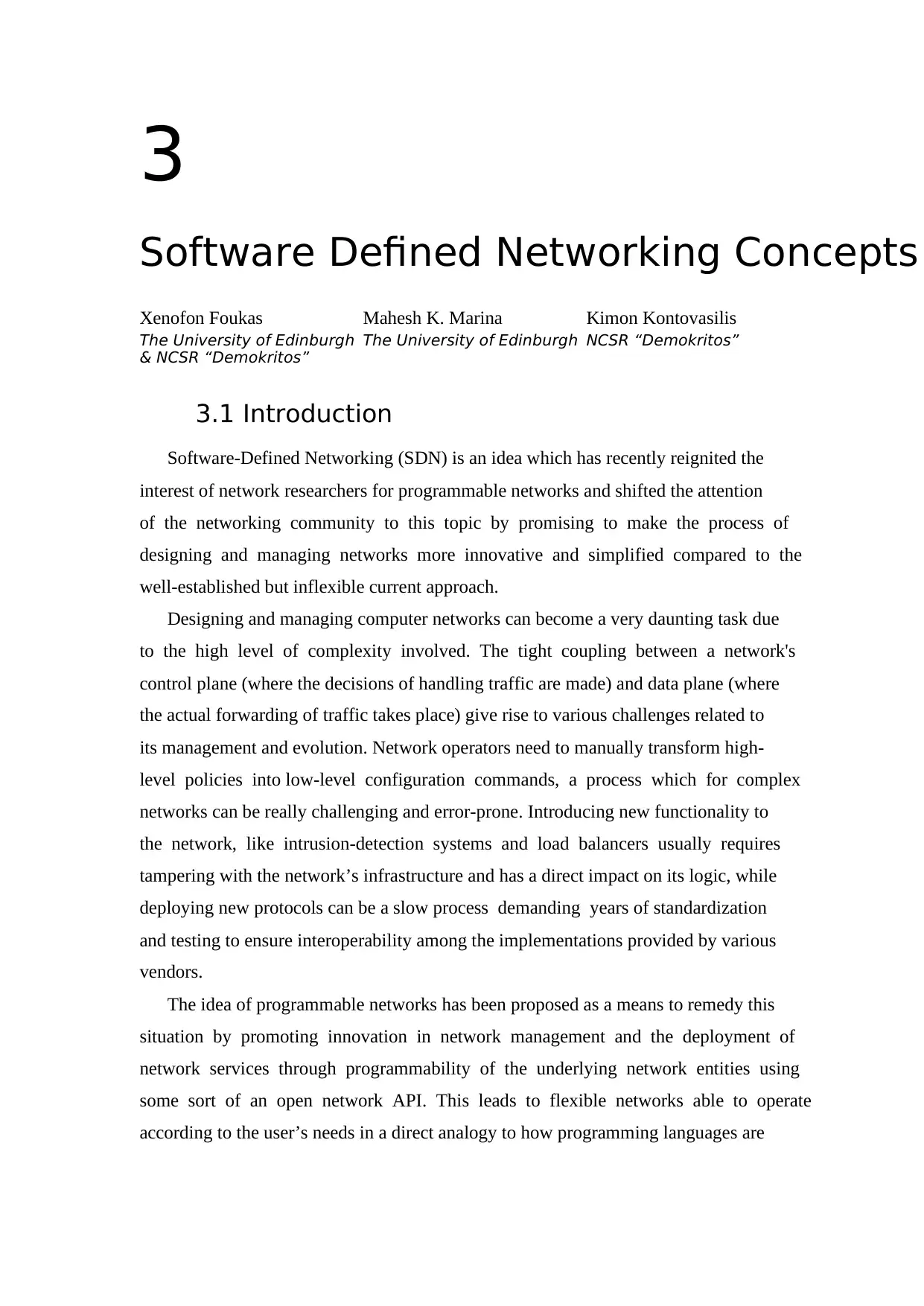
3
Software Defined Networking Concepts
Xenofon Foukas Mahesh K. Marina Kimon Kontovasilis
The University of Edinburgh The University of Edinburgh NCSR “Demokritos”
& NCSR “Demokritos”
3.1 Introduction
Software-Defined Networking (SDN) is an idea which has recently reignited the
interest of network researchers for programmable networks and shifted the attention
of the networking community to this topic by promising to make the process of
designing and managing networks more innovative and simplified compared to the
well-established but inflexible current approach.
Designing and managing computer networks can become a very daunting task due
to the high level of complexity involved. The tight coupling between a network's
control plane (where the decisions of handling traffic are made) and data plane (where
the actual forwarding of traffic takes place) give rise to various challenges related to
its management and evolution. Network operators need to manually transform high-
level policies into low-level configuration commands, a process which for complex
networks can be really challenging and error-prone. Introducing new functionality to
the network, like intrusion-detection systems and load balancers usually requires
tampering with the network’s infrastructure and has a direct impact on its logic, while
deploying new protocols can be a slow process demanding years of standardization
and testing to ensure interoperability among the implementations provided by various
vendors.
The idea of programmable networks has been proposed as a means to remedy this
situation by promoting innovation in network management and the deployment of
network services through programmability of the underlying network entities using
some sort of an open network API. This leads to flexible networks able to operate
according to the user’s needs in a direct analogy to how programming languages are
Software Defined Networking Concepts
Xenofon Foukas Mahesh K. Marina Kimon Kontovasilis
The University of Edinburgh The University of Edinburgh NCSR “Demokritos”
& NCSR “Demokritos”
3.1 Introduction
Software-Defined Networking (SDN) is an idea which has recently reignited the
interest of network researchers for programmable networks and shifted the attention
of the networking community to this topic by promising to make the process of
designing and managing networks more innovative and simplified compared to the
well-established but inflexible current approach.
Designing and managing computer networks can become a very daunting task due
to the high level of complexity involved. The tight coupling between a network's
control plane (where the decisions of handling traffic are made) and data plane (where
the actual forwarding of traffic takes place) give rise to various challenges related to
its management and evolution. Network operators need to manually transform high-
level policies into low-level configuration commands, a process which for complex
networks can be really challenging and error-prone. Introducing new functionality to
the network, like intrusion-detection systems and load balancers usually requires
tampering with the network’s infrastructure and has a direct impact on its logic, while
deploying new protocols can be a slow process demanding years of standardization
and testing to ensure interoperability among the implementations provided by various
vendors.
The idea of programmable networks has been proposed as a means to remedy this
situation by promoting innovation in network management and the deployment of
network services through programmability of the underlying network entities using
some sort of an open network API. This leads to flexible networks able to operate
according to the user’s needs in a direct analogy to how programming languages are
Secure Best Marks with AI Grader
Need help grading? Try our AI Grader for instant feedback on your assignments.
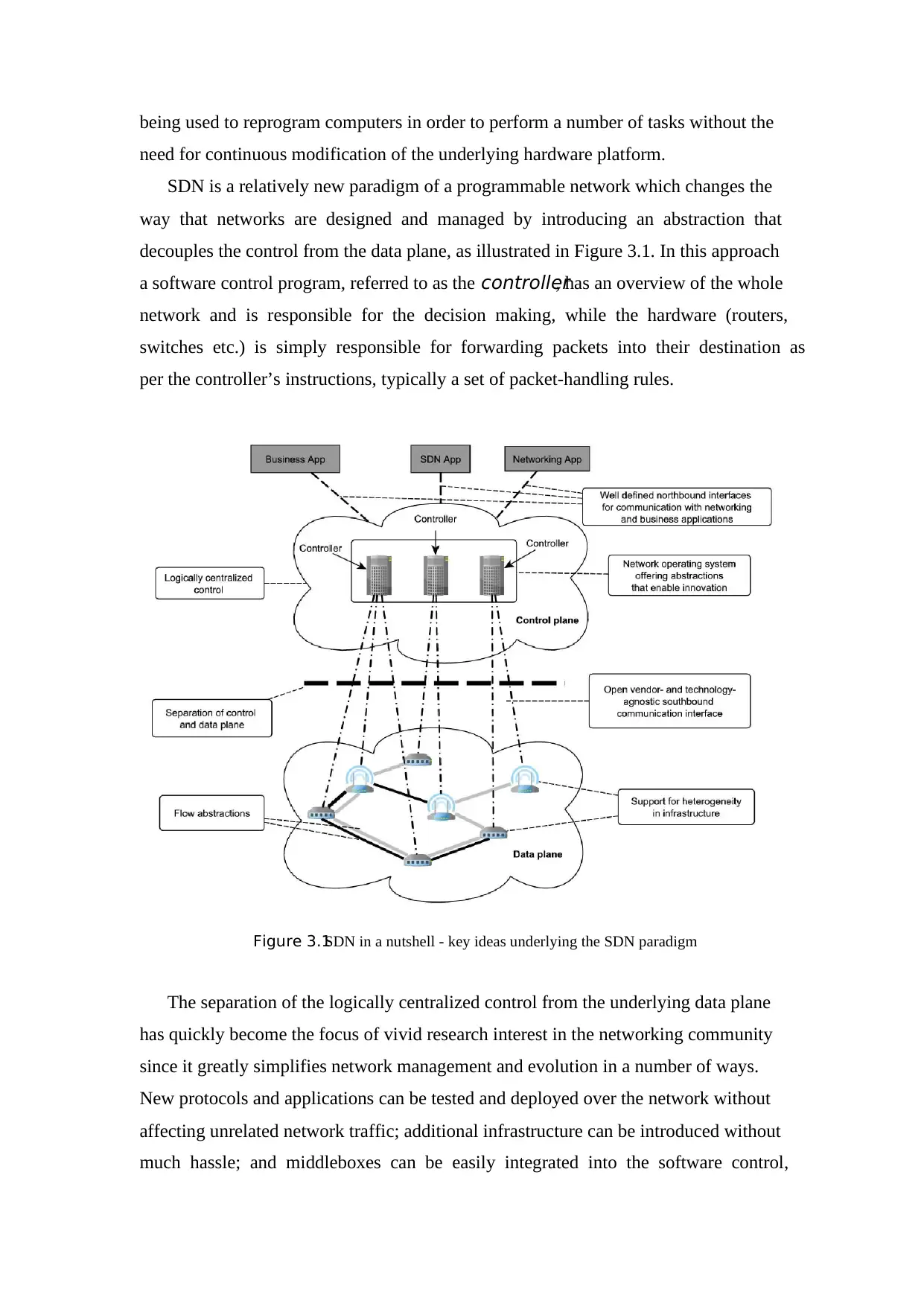
being used to reprogram computers in order to perform a number of tasks without the
need for continuous modification of the underlying hardware platform.
SDN is a relatively new paradigm of a programmable network which changes the
way that networks are designed and managed by introducing an abstraction that
decouples the control from the data plane, as illustrated in Figure 3.1. In this approach
a software control program, referred to as the controller, has an overview of the whole
network and is responsible for the decision making, while the hardware (routers,
switches etc.) is simply responsible for forwarding packets into their destination as
per the controller’s instructions, typically a set of packet-handling rules.
Figure 3.1SDN in a nutshell - key ideas underlying the SDN paradigm
The separation of the logically centralized control from the underlying data plane
has quickly become the focus of vivid research interest in the networking community
since it greatly simplifies network management and evolution in a number of ways.
New protocols and applications can be tested and deployed over the network without
affecting unrelated network traffic; additional infrastructure can be introduced without
much hassle; and middleboxes can be easily integrated into the software control,
need for continuous modification of the underlying hardware platform.
SDN is a relatively new paradigm of a programmable network which changes the
way that networks are designed and managed by introducing an abstraction that
decouples the control from the data plane, as illustrated in Figure 3.1. In this approach
a software control program, referred to as the controller, has an overview of the whole
network and is responsible for the decision making, while the hardware (routers,
switches etc.) is simply responsible for forwarding packets into their destination as
per the controller’s instructions, typically a set of packet-handling rules.
Figure 3.1SDN in a nutshell - key ideas underlying the SDN paradigm
The separation of the logically centralized control from the underlying data plane
has quickly become the focus of vivid research interest in the networking community
since it greatly simplifies network management and evolution in a number of ways.
New protocols and applications can be tested and deployed over the network without
affecting unrelated network traffic; additional infrastructure can be introduced without
much hassle; and middleboxes can be easily integrated into the software control,
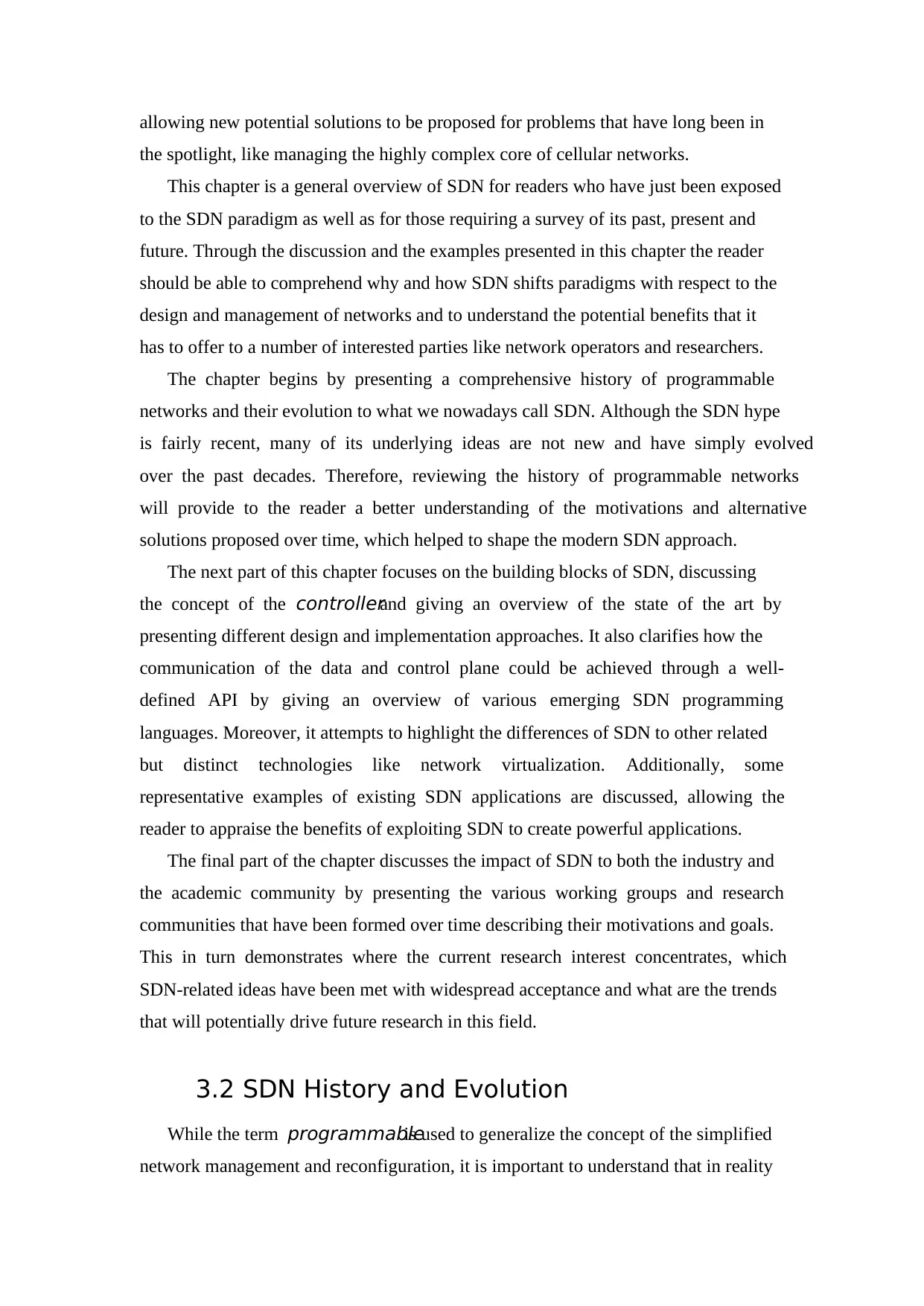
allowing new potential solutions to be proposed for problems that have long been in
the spotlight, like managing the highly complex core of cellular networks.
This chapter is a general overview of SDN for readers who have just been exposed
to the SDN paradigm as well as for those requiring a survey of its past, present and
future. Through the discussion and the examples presented in this chapter the reader
should be able to comprehend why and how SDN shifts paradigms with respect to the
design and management of networks and to understand the potential benefits that it
has to offer to a number of interested parties like network operators and researchers.
The chapter begins by presenting a comprehensive history of programmable
networks and their evolution to what we nowadays call SDN. Although the SDN hype
is fairly recent, many of its underlying ideas are not new and have simply evolved
over the past decades. Therefore, reviewing the history of programmable networks
will provide to the reader a better understanding of the motivations and alternative
solutions proposed over time, which helped to shape the modern SDN approach.
The next part of this chapter focuses on the building blocks of SDN, discussing
the concept of the controllerand giving an overview of the state of the art by
presenting different design and implementation approaches. It also clarifies how the
communication of the data and control plane could be achieved through a well-
defined API by giving an overview of various emerging SDN programming
languages. Moreover, it attempts to highlight the differences of SDN to other related
but distinct technologies like network virtualization. Additionally, some
representative examples of existing SDN applications are discussed, allowing the
reader to appraise the benefits of exploiting SDN to create powerful applications.
The final part of the chapter discusses the impact of SDN to both the industry and
the academic community by presenting the various working groups and research
communities that have been formed over time describing their motivations and goals.
This in turn demonstrates where the current research interest concentrates, which
SDN-related ideas have been met with widespread acceptance and what are the trends
that will potentially drive future research in this field.
3.2 SDN History and Evolution
While the term programmableis used to generalize the concept of the simplified
network management and reconfiguration, it is important to understand that in reality
the spotlight, like managing the highly complex core of cellular networks.
This chapter is a general overview of SDN for readers who have just been exposed
to the SDN paradigm as well as for those requiring a survey of its past, present and
future. Through the discussion and the examples presented in this chapter the reader
should be able to comprehend why and how SDN shifts paradigms with respect to the
design and management of networks and to understand the potential benefits that it
has to offer to a number of interested parties like network operators and researchers.
The chapter begins by presenting a comprehensive history of programmable
networks and their evolution to what we nowadays call SDN. Although the SDN hype
is fairly recent, many of its underlying ideas are not new and have simply evolved
over the past decades. Therefore, reviewing the history of programmable networks
will provide to the reader a better understanding of the motivations and alternative
solutions proposed over time, which helped to shape the modern SDN approach.
The next part of this chapter focuses on the building blocks of SDN, discussing
the concept of the controllerand giving an overview of the state of the art by
presenting different design and implementation approaches. It also clarifies how the
communication of the data and control plane could be achieved through a well-
defined API by giving an overview of various emerging SDN programming
languages. Moreover, it attempts to highlight the differences of SDN to other related
but distinct technologies like network virtualization. Additionally, some
representative examples of existing SDN applications are discussed, allowing the
reader to appraise the benefits of exploiting SDN to create powerful applications.
The final part of the chapter discusses the impact of SDN to both the industry and
the academic community by presenting the various working groups and research
communities that have been formed over time describing their motivations and goals.
This in turn demonstrates where the current research interest concentrates, which
SDN-related ideas have been met with widespread acceptance and what are the trends
that will potentially drive future research in this field.
3.2 SDN History and Evolution
While the term programmableis used to generalize the concept of the simplified
network management and reconfiguration, it is important to understand that in reality
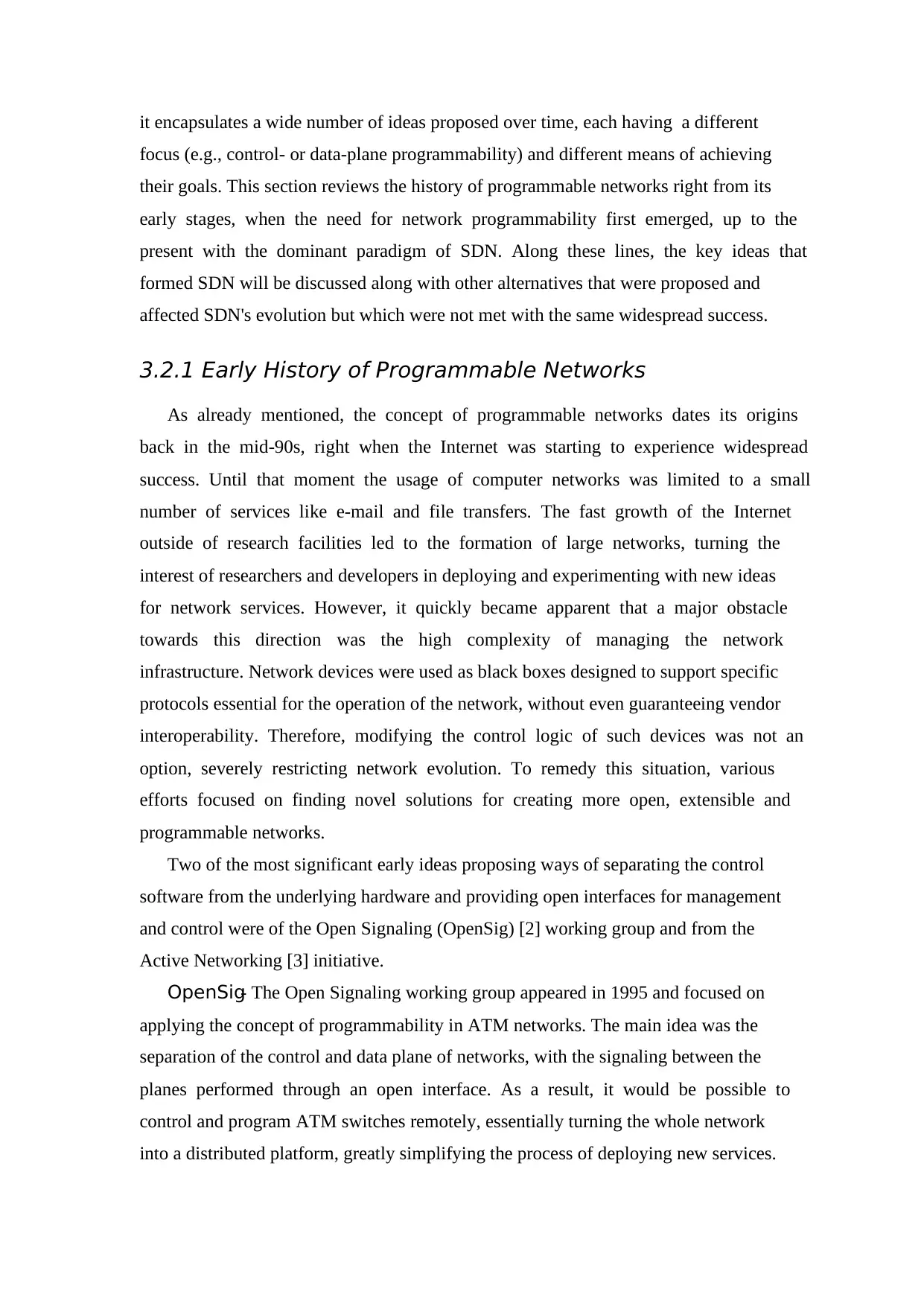
it encapsulates a wide number of ideas proposed over time, each having a different
focus (e.g., control- or data-plane programmability) and different means of achieving
their goals. This section reviews the history of programmable networks right from its
early stages, when the need for network programmability first emerged, up to the
present with the dominant paradigm of SDN. Along these lines, the key ideas that
formed SDN will be discussed along with other alternatives that were proposed and
affected SDN's evolution but which were not met with the same widespread success.
3.2.1 Early History of Programmable Networks
As already mentioned, the concept of programmable networks dates its origins
back in the mid-90s, right when the Internet was starting to experience widespread
success. Until that moment the usage of computer networks was limited to a small
number of services like e-mail and file transfers. The fast growth of the Internet
outside of research facilities led to the formation of large networks, turning the
interest of researchers and developers in deploying and experimenting with new ideas
for network services. However, it quickly became apparent that a major obstacle
towards this direction was the high complexity of managing the network
infrastructure. Network devices were used as black boxes designed to support specific
protocols essential for the operation of the network, without even guaranteeing vendor
interoperability. Therefore, modifying the control logic of such devices was not an
option, severely restricting network evolution. To remedy this situation, various
efforts focused on finding novel solutions for creating more open, extensible and
programmable networks.
Two of the most significant early ideas proposing ways of separating the control
software from the underlying hardware and providing open interfaces for management
and control were of the Open Signaling (OpenSig) [2] working group and from the
Active Networking [3] initiative.
OpenSig- The Open Signaling working group appeared in 1995 and focused on
applying the concept of programmability in ATM networks. The main idea was the
separation of the control and data plane of networks, with the signaling between the
planes performed through an open interface. As a result, it would be possible to
control and program ATM switches remotely, essentially turning the whole network
into a distributed platform, greatly simplifying the process of deploying new services.
focus (e.g., control- or data-plane programmability) and different means of achieving
their goals. This section reviews the history of programmable networks right from its
early stages, when the need for network programmability first emerged, up to the
present with the dominant paradigm of SDN. Along these lines, the key ideas that
formed SDN will be discussed along with other alternatives that were proposed and
affected SDN's evolution but which were not met with the same widespread success.
3.2.1 Early History of Programmable Networks
As already mentioned, the concept of programmable networks dates its origins
back in the mid-90s, right when the Internet was starting to experience widespread
success. Until that moment the usage of computer networks was limited to a small
number of services like e-mail and file transfers. The fast growth of the Internet
outside of research facilities led to the formation of large networks, turning the
interest of researchers and developers in deploying and experimenting with new ideas
for network services. However, it quickly became apparent that a major obstacle
towards this direction was the high complexity of managing the network
infrastructure. Network devices were used as black boxes designed to support specific
protocols essential for the operation of the network, without even guaranteeing vendor
interoperability. Therefore, modifying the control logic of such devices was not an
option, severely restricting network evolution. To remedy this situation, various
efforts focused on finding novel solutions for creating more open, extensible and
programmable networks.
Two of the most significant early ideas proposing ways of separating the control
software from the underlying hardware and providing open interfaces for management
and control were of the Open Signaling (OpenSig) [2] working group and from the
Active Networking [3] initiative.
OpenSig- The Open Signaling working group appeared in 1995 and focused on
applying the concept of programmability in ATM networks. The main idea was the
separation of the control and data plane of networks, with the signaling between the
planes performed through an open interface. As a result, it would be possible to
control and program ATM switches remotely, essentially turning the whole network
into a distributed platform, greatly simplifying the process of deploying new services.
Secure Best Marks with AI Grader
Need help grading? Try our AI Grader for instant feedback on your assignments.
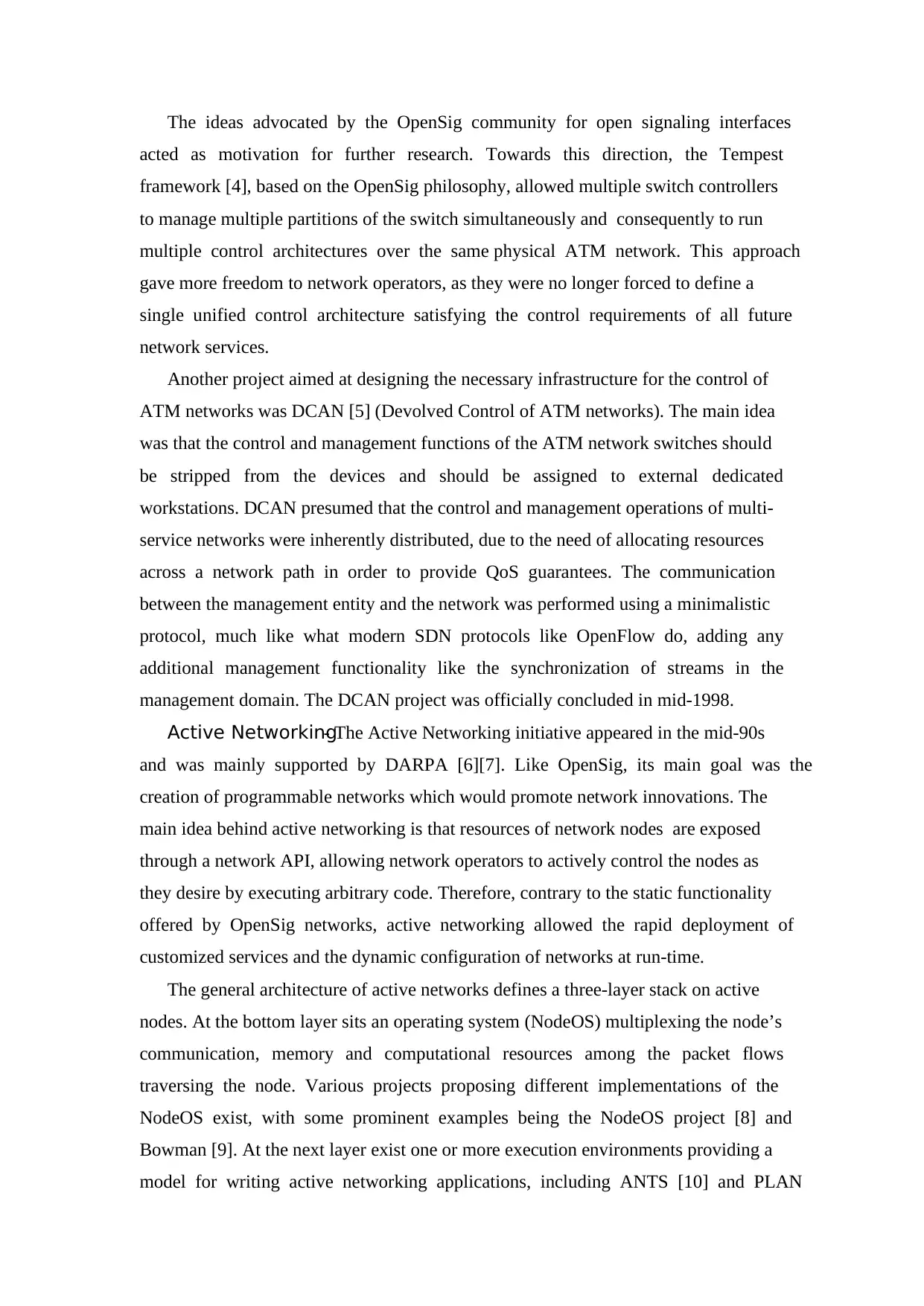
The ideas advocated by the OpenSig community for open signaling interfaces
acted as motivation for further research. Towards this direction, the Tempest
framework [4], based on the OpenSig philosophy, allowed multiple switch controllers
to manage multiple partitions of the switch simultaneously and consequently to run
multiple control architectures over the same physical ATM network. This approach
gave more freedom to network operators, as they were no longer forced to define a
single unified control architecture satisfying the control requirements of all future
network services.
Another project aimed at designing the necessary infrastructure for the control of
ATM networks was DCAN [5] (Devolved Control of ATM networks). The main idea
was that the control and management functions of the ATM network switches should
be stripped from the devices and should be assigned to external dedicated
workstations. DCAN presumed that the control and management operations of multi-
service networks were inherently distributed, due to the need of allocating resources
across a network path in order to provide QoS guarantees. The communication
between the management entity and the network was performed using a minimalistic
protocol, much like what modern SDN protocols like OpenFlow do, adding any
additional management functionality like the synchronization of streams in the
management domain. The DCAN project was officially concluded in mid-1998.
Active Networking- The Active Networking initiative appeared in the mid-90s
and was mainly supported by DARPA [6][7]. Like OpenSig, its main goal was the
creation of programmable networks which would promote network innovations. The
main idea behind active networking is that resources of network nodes are exposed
through a network API, allowing network operators to actively control the nodes as
they desire by executing arbitrary code. Therefore, contrary to the static functionality
offered by OpenSig networks, active networking allowed the rapid deployment of
customized services and the dynamic configuration of networks at run-time.
The general architecture of active networks defines a three-layer stack on active
nodes. At the bottom layer sits an operating system (NodeOS) multiplexing the node’s
communication, memory and computational resources among the packet flows
traversing the node. Various projects proposing different implementations of the
NodeOS exist, with some prominent examples being the NodeOS project [8] and
Bowman [9]. At the next layer exist one or more execution environments providing a
model for writing active networking applications, including ANTS [10] and PLAN
acted as motivation for further research. Towards this direction, the Tempest
framework [4], based on the OpenSig philosophy, allowed multiple switch controllers
to manage multiple partitions of the switch simultaneously and consequently to run
multiple control architectures over the same physical ATM network. This approach
gave more freedom to network operators, as they were no longer forced to define a
single unified control architecture satisfying the control requirements of all future
network services.
Another project aimed at designing the necessary infrastructure for the control of
ATM networks was DCAN [5] (Devolved Control of ATM networks). The main idea
was that the control and management functions of the ATM network switches should
be stripped from the devices and should be assigned to external dedicated
workstations. DCAN presumed that the control and management operations of multi-
service networks were inherently distributed, due to the need of allocating resources
across a network path in order to provide QoS guarantees. The communication
between the management entity and the network was performed using a minimalistic
protocol, much like what modern SDN protocols like OpenFlow do, adding any
additional management functionality like the synchronization of streams in the
management domain. The DCAN project was officially concluded in mid-1998.
Active Networking- The Active Networking initiative appeared in the mid-90s
and was mainly supported by DARPA [6][7]. Like OpenSig, its main goal was the
creation of programmable networks which would promote network innovations. The
main idea behind active networking is that resources of network nodes are exposed
through a network API, allowing network operators to actively control the nodes as
they desire by executing arbitrary code. Therefore, contrary to the static functionality
offered by OpenSig networks, active networking allowed the rapid deployment of
customized services and the dynamic configuration of networks at run-time.
The general architecture of active networks defines a three-layer stack on active
nodes. At the bottom layer sits an operating system (NodeOS) multiplexing the node’s
communication, memory and computational resources among the packet flows
traversing the node. Various projects proposing different implementations of the
NodeOS exist, with some prominent examples being the NodeOS project [8] and
Bowman [9]. At the next layer exist one or more execution environments providing a
model for writing active networking applications, including ANTS [10] and PLAN
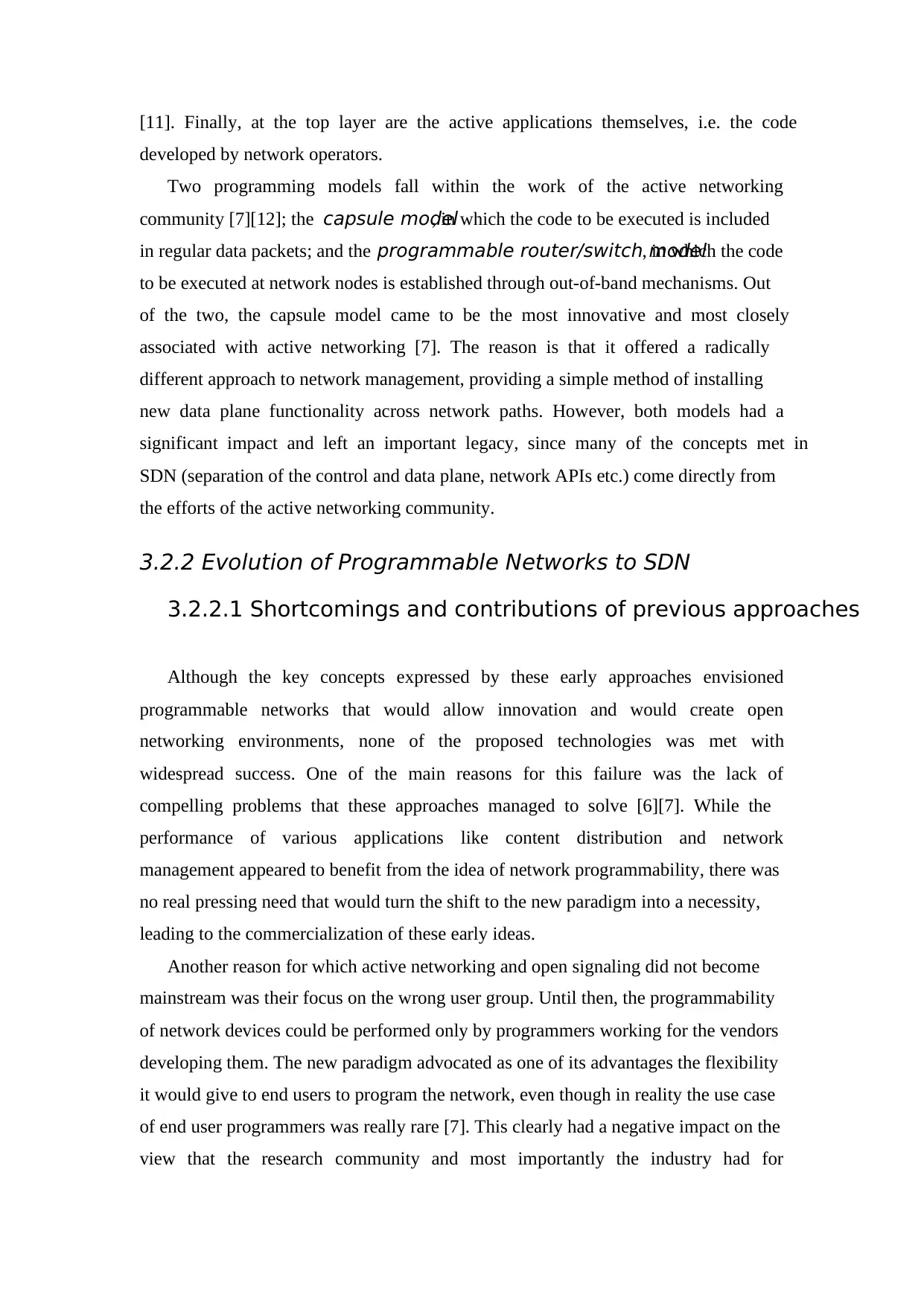
[11]. Finally, at the top layer are the active applications themselves, i.e. the code
developed by network operators.
Two programming models fall within the work of the active networking
community [7][12]; the capsule model, in which the code to be executed is included
in regular data packets; and the programmable router/switch model, in which the code
to be executed at network nodes is established through out-of-band mechanisms. Out
of the two, the capsule model came to be the most innovative and most closely
associated with active networking [7]. The reason is that it offered a radically
different approach to network management, providing a simple method of installing
new data plane functionality across network paths. However, both models had a
significant impact and left an important legacy, since many of the concepts met in
SDN (separation of the control and data plane, network APIs etc.) come directly from
the efforts of the active networking community.
3.2.2 Evolution of Programmable Networks to SDN
3.2.2.1 Shortcomings and contributions of previous approaches
Although the key concepts expressed by these early approaches envisioned
programmable networks that would allow innovation and would create open
networking environments, none of the proposed technologies was met with
widespread success. One of the main reasons for this failure was the lack of
compelling problems that these approaches managed to solve [6][7]. While the
performance of various applications like content distribution and network
management appeared to benefit from the idea of network programmability, there was
no real pressing need that would turn the shift to the new paradigm into a necessity,
leading to the commercialization of these early ideas.
Another reason for which active networking and open signaling did not become
mainstream was their focus on the wrong user group. Until then, the programmability
of network devices could be performed only by programmers working for the vendors
developing them. The new paradigm advocated as one of its advantages the flexibility
it would give to end users to program the network, even though in reality the use case
of end user programmers was really rare [7]. This clearly had a negative impact on the
view that the research community and most importantly the industry had for
developed by network operators.
Two programming models fall within the work of the active networking
community [7][12]; the capsule model, in which the code to be executed is included
in regular data packets; and the programmable router/switch model, in which the code
to be executed at network nodes is established through out-of-band mechanisms. Out
of the two, the capsule model came to be the most innovative and most closely
associated with active networking [7]. The reason is that it offered a radically
different approach to network management, providing a simple method of installing
new data plane functionality across network paths. However, both models had a
significant impact and left an important legacy, since many of the concepts met in
SDN (separation of the control and data plane, network APIs etc.) come directly from
the efforts of the active networking community.
3.2.2 Evolution of Programmable Networks to SDN
3.2.2.1 Shortcomings and contributions of previous approaches
Although the key concepts expressed by these early approaches envisioned
programmable networks that would allow innovation and would create open
networking environments, none of the proposed technologies was met with
widespread success. One of the main reasons for this failure was the lack of
compelling problems that these approaches managed to solve [6][7]. While the
performance of various applications like content distribution and network
management appeared to benefit from the idea of network programmability, there was
no real pressing need that would turn the shift to the new paradigm into a necessity,
leading to the commercialization of these early ideas.
Another reason for which active networking and open signaling did not become
mainstream was their focus on the wrong user group. Until then, the programmability
of network devices could be performed only by programmers working for the vendors
developing them. The new paradigm advocated as one of its advantages the flexibility
it would give to end users to program the network, even though in reality the use case
of end user programmers was really rare [7]. This clearly had a negative impact on the
view that the research community and most importantly the industry had for
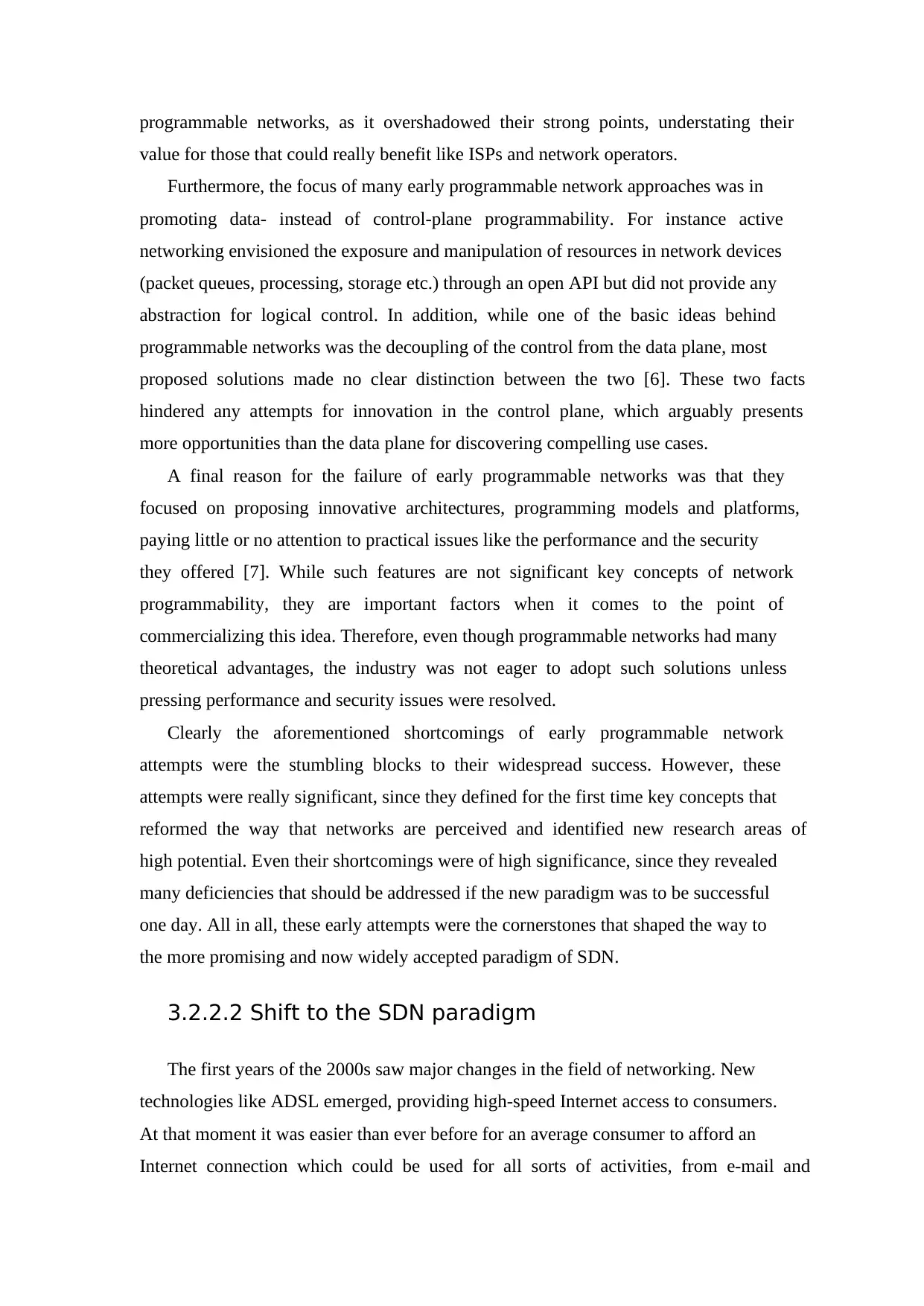
programmable networks, as it overshadowed their strong points, understating their
value for those that could really benefit like ISPs and network operators.
Furthermore, the focus of many early programmable network approaches was in
promoting data- instead of control-plane programmability. For instance active
networking envisioned the exposure and manipulation of resources in network devices
(packet queues, processing, storage etc.) through an open API but did not provide any
abstraction for logical control. In addition, while one of the basic ideas behind
programmable networks was the decoupling of the control from the data plane, most
proposed solutions made no clear distinction between the two [6]. These two facts
hindered any attempts for innovation in the control plane, which arguably presents
more opportunities than the data plane for discovering compelling use cases.
A final reason for the failure of early programmable networks was that they
focused on proposing innovative architectures, programming models and platforms,
paying little or no attention to practical issues like the performance and the security
they offered [7]. While such features are not significant key concepts of network
programmability, they are important factors when it comes to the point of
commercializing this idea. Therefore, even though programmable networks had many
theoretical advantages, the industry was not eager to adopt such solutions unless
pressing performance and security issues were resolved.
Clearly the aforementioned shortcomings of early programmable network
attempts were the stumbling blocks to their widespread success. However, these
attempts were really significant, since they defined for the first time key concepts that
reformed the way that networks are perceived and identified new research areas of
high potential. Even their shortcomings were of high significance, since they revealed
many deficiencies that should be addressed if the new paradigm was to be successful
one day. All in all, these early attempts were the cornerstones that shaped the way to
the more promising and now widely accepted paradigm of SDN.
3.2.2.2 Shift to the SDN paradigm
The first years of the 2000s saw major changes in the field of networking. New
technologies like ADSL emerged, providing high-speed Internet access to consumers.
At that moment it was easier than ever before for an average consumer to afford an
Internet connection which could be used for all sorts of activities, from e-mail and
value for those that could really benefit like ISPs and network operators.
Furthermore, the focus of many early programmable network approaches was in
promoting data- instead of control-plane programmability. For instance active
networking envisioned the exposure and manipulation of resources in network devices
(packet queues, processing, storage etc.) through an open API but did not provide any
abstraction for logical control. In addition, while one of the basic ideas behind
programmable networks was the decoupling of the control from the data plane, most
proposed solutions made no clear distinction between the two [6]. These two facts
hindered any attempts for innovation in the control plane, which arguably presents
more opportunities than the data plane for discovering compelling use cases.
A final reason for the failure of early programmable networks was that they
focused on proposing innovative architectures, programming models and platforms,
paying little or no attention to practical issues like the performance and the security
they offered [7]. While such features are not significant key concepts of network
programmability, they are important factors when it comes to the point of
commercializing this idea. Therefore, even though programmable networks had many
theoretical advantages, the industry was not eager to adopt such solutions unless
pressing performance and security issues were resolved.
Clearly the aforementioned shortcomings of early programmable network
attempts were the stumbling blocks to their widespread success. However, these
attempts were really significant, since they defined for the first time key concepts that
reformed the way that networks are perceived and identified new research areas of
high potential. Even their shortcomings were of high significance, since they revealed
many deficiencies that should be addressed if the new paradigm was to be successful
one day. All in all, these early attempts were the cornerstones that shaped the way to
the more promising and now widely accepted paradigm of SDN.
3.2.2.2 Shift to the SDN paradigm
The first years of the 2000s saw major changes in the field of networking. New
technologies like ADSL emerged, providing high-speed Internet access to consumers.
At that moment it was easier than ever before for an average consumer to afford an
Internet connection which could be used for all sorts of activities, from e-mail and
Paraphrase This Document
Need a fresh take? Get an instant paraphrase of this document with our AI Paraphraser
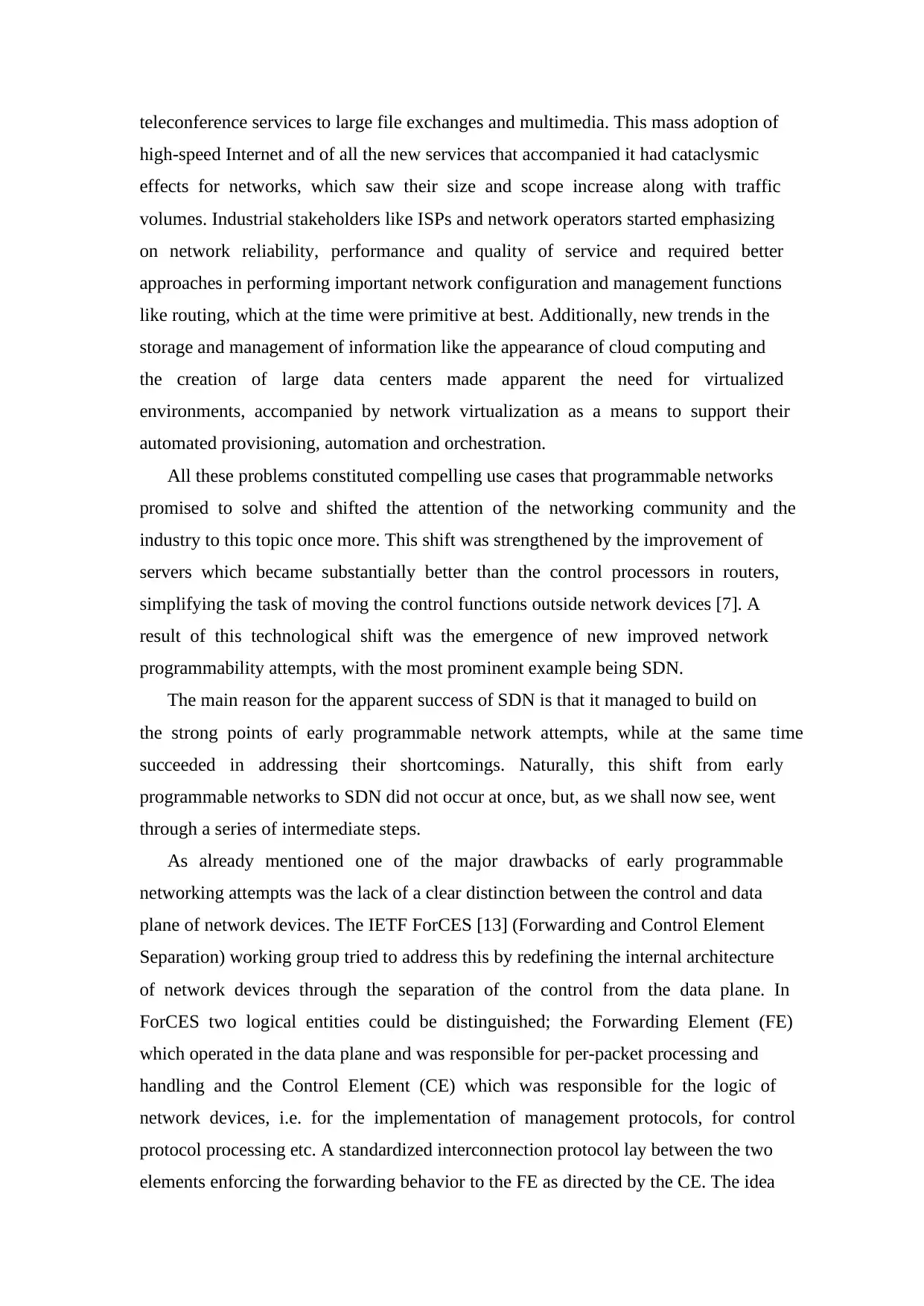
teleconference services to large file exchanges and multimedia. This mass adoption of
high-speed Internet and of all the new services that accompanied it had cataclysmic
effects for networks, which saw their size and scope increase along with traffic
volumes. Industrial stakeholders like ISPs and network operators started emphasizing
on network reliability, performance and quality of service and required better
approaches in performing important network configuration and management functions
like routing, which at the time were primitive at best. Additionally, new trends in the
storage and management of information like the appearance of cloud computing and
the creation of large data centers made apparent the need for virtualized
environments, accompanied by network virtualization as a means to support their
automated provisioning, automation and orchestration.
All these problems constituted compelling use cases that programmable networks
promised to solve and shifted the attention of the networking community and the
industry to this topic once more. This shift was strengthened by the improvement of
servers which became substantially better than the control processors in routers,
simplifying the task of moving the control functions outside network devices [7]. A
result of this technological shift was the emergence of new improved network
programmability attempts, with the most prominent example being SDN.
The main reason for the apparent success of SDN is that it managed to build on
the strong points of early programmable network attempts, while at the same time
succeeded in addressing their shortcomings. Naturally, this shift from early
programmable networks to SDN did not occur at once, but, as we shall now see, went
through a series of intermediate steps.
As already mentioned one of the major drawbacks of early programmable
networking attempts was the lack of a clear distinction between the control and data
plane of network devices. The IETF ForCES [13] (Forwarding and Control Element
Separation) working group tried to address this by redefining the internal architecture
of network devices through the separation of the control from the data plane. In
ForCES two logical entities could be distinguished; the Forwarding Element (FE)
which operated in the data plane and was responsible for per-packet processing and
handling and the Control Element (CE) which was responsible for the logic of
network devices, i.e. for the implementation of management protocols, for control
protocol processing etc. A standardized interconnection protocol lay between the two
elements enforcing the forwarding behavior to the FE as directed by the CE. The idea
high-speed Internet and of all the new services that accompanied it had cataclysmic
effects for networks, which saw their size and scope increase along with traffic
volumes. Industrial stakeholders like ISPs and network operators started emphasizing
on network reliability, performance and quality of service and required better
approaches in performing important network configuration and management functions
like routing, which at the time were primitive at best. Additionally, new trends in the
storage and management of information like the appearance of cloud computing and
the creation of large data centers made apparent the need for virtualized
environments, accompanied by network virtualization as a means to support their
automated provisioning, automation and orchestration.
All these problems constituted compelling use cases that programmable networks
promised to solve and shifted the attention of the networking community and the
industry to this topic once more. This shift was strengthened by the improvement of
servers which became substantially better than the control processors in routers,
simplifying the task of moving the control functions outside network devices [7]. A
result of this technological shift was the emergence of new improved network
programmability attempts, with the most prominent example being SDN.
The main reason for the apparent success of SDN is that it managed to build on
the strong points of early programmable network attempts, while at the same time
succeeded in addressing their shortcomings. Naturally, this shift from early
programmable networks to SDN did not occur at once, but, as we shall now see, went
through a series of intermediate steps.
As already mentioned one of the major drawbacks of early programmable
networking attempts was the lack of a clear distinction between the control and data
plane of network devices. The IETF ForCES [13] (Forwarding and Control Element
Separation) working group tried to address this by redefining the internal architecture
of network devices through the separation of the control from the data plane. In
ForCES two logical entities could be distinguished; the Forwarding Element (FE)
which operated in the data plane and was responsible for per-packet processing and
handling and the Control Element (CE) which was responsible for the logic of
network devices, i.e. for the implementation of management protocols, for control
protocol processing etc. A standardized interconnection protocol lay between the two
elements enforcing the forwarding behavior to the FE as directed by the CE. The idea
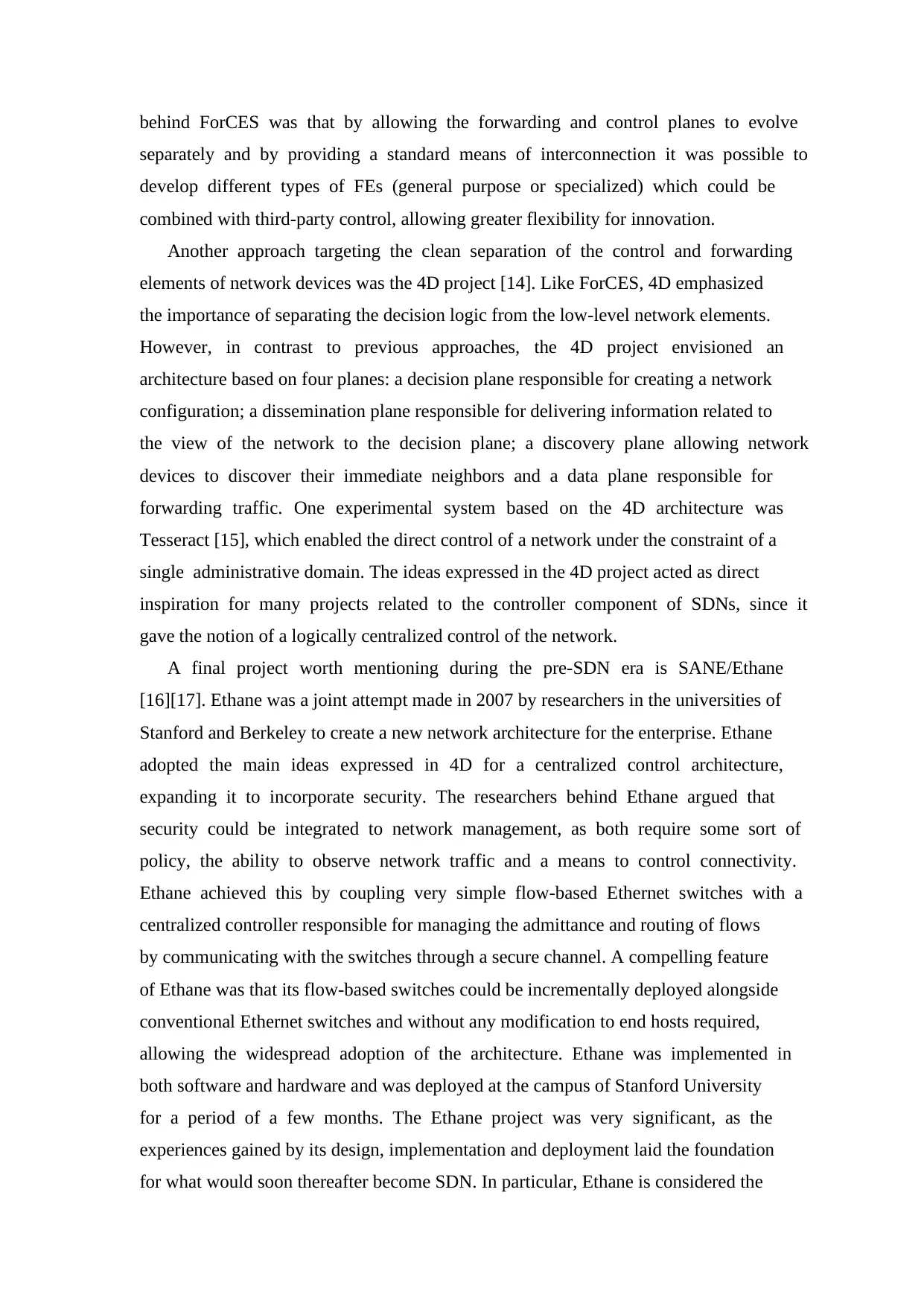
behind ForCES was that by allowing the forwarding and control planes to evolve
separately and by providing a standard means of interconnection it was possible to
develop different types of FEs (general purpose or specialized) which could be
combined with third-party control, allowing greater flexibility for innovation.
Another approach targeting the clean separation of the control and forwarding
elements of network devices was the 4D project [14]. Like ForCES, 4D emphasized
the importance of separating the decision logic from the low-level network elements.
However, in contrast to previous approaches, the 4D project envisioned an
architecture based on four planes: a decision plane responsible for creating a network
configuration; a dissemination plane responsible for delivering information related to
the view of the network to the decision plane; a discovery plane allowing network
devices to discover their immediate neighbors and a data plane responsible for
forwarding traffic. One experimental system based on the 4D architecture was
Tesseract [15], which enabled the direct control of a network under the constraint of a
single administrative domain. The ideas expressed in the 4D project acted as direct
inspiration for many projects related to the controller component of SDNs, since it
gave the notion of a logically centralized control of the network.
A final project worth mentioning during the pre-SDN era is SANE/Ethane
[16][17]. Ethane was a joint attempt made in 2007 by researchers in the universities of
Stanford and Berkeley to create a new network architecture for the enterprise. Ethane
adopted the main ideas expressed in 4D for a centralized control architecture,
expanding it to incorporate security. The researchers behind Ethane argued that
security could be integrated to network management, as both require some sort of
policy, the ability to observe network traffic and a means to control connectivity.
Ethane achieved this by coupling very simple flow-based Ethernet switches with a
centralized controller responsible for managing the admittance and routing of flows
by communicating with the switches through a secure channel. A compelling feature
of Ethane was that its flow-based switches could be incrementally deployed alongside
conventional Ethernet switches and without any modification to end hosts required,
allowing the widespread adoption of the architecture. Ethane was implemented in
both software and hardware and was deployed at the campus of Stanford University
for a period of a few months. The Ethane project was very significant, as the
experiences gained by its design, implementation and deployment laid the foundation
for what would soon thereafter become SDN. In particular, Ethane is considered the
separately and by providing a standard means of interconnection it was possible to
develop different types of FEs (general purpose or specialized) which could be
combined with third-party control, allowing greater flexibility for innovation.
Another approach targeting the clean separation of the control and forwarding
elements of network devices was the 4D project [14]. Like ForCES, 4D emphasized
the importance of separating the decision logic from the low-level network elements.
However, in contrast to previous approaches, the 4D project envisioned an
architecture based on four planes: a decision plane responsible for creating a network
configuration; a dissemination plane responsible for delivering information related to
the view of the network to the decision plane; a discovery plane allowing network
devices to discover their immediate neighbors and a data plane responsible for
forwarding traffic. One experimental system based on the 4D architecture was
Tesseract [15], which enabled the direct control of a network under the constraint of a
single administrative domain. The ideas expressed in the 4D project acted as direct
inspiration for many projects related to the controller component of SDNs, since it
gave the notion of a logically centralized control of the network.
A final project worth mentioning during the pre-SDN era is SANE/Ethane
[16][17]. Ethane was a joint attempt made in 2007 by researchers in the universities of
Stanford and Berkeley to create a new network architecture for the enterprise. Ethane
adopted the main ideas expressed in 4D for a centralized control architecture,
expanding it to incorporate security. The researchers behind Ethane argued that
security could be integrated to network management, as both require some sort of
policy, the ability to observe network traffic and a means to control connectivity.
Ethane achieved this by coupling very simple flow-based Ethernet switches with a
centralized controller responsible for managing the admittance and routing of flows
by communicating with the switches through a secure channel. A compelling feature
of Ethane was that its flow-based switches could be incrementally deployed alongside
conventional Ethernet switches and without any modification to end hosts required,
allowing the widespread adoption of the architecture. Ethane was implemented in
both software and hardware and was deployed at the campus of Stanford University
for a period of a few months. The Ethane project was very significant, as the
experiences gained by its design, implementation and deployment laid the foundation
for what would soon thereafter become SDN. In particular, Ethane is considered the
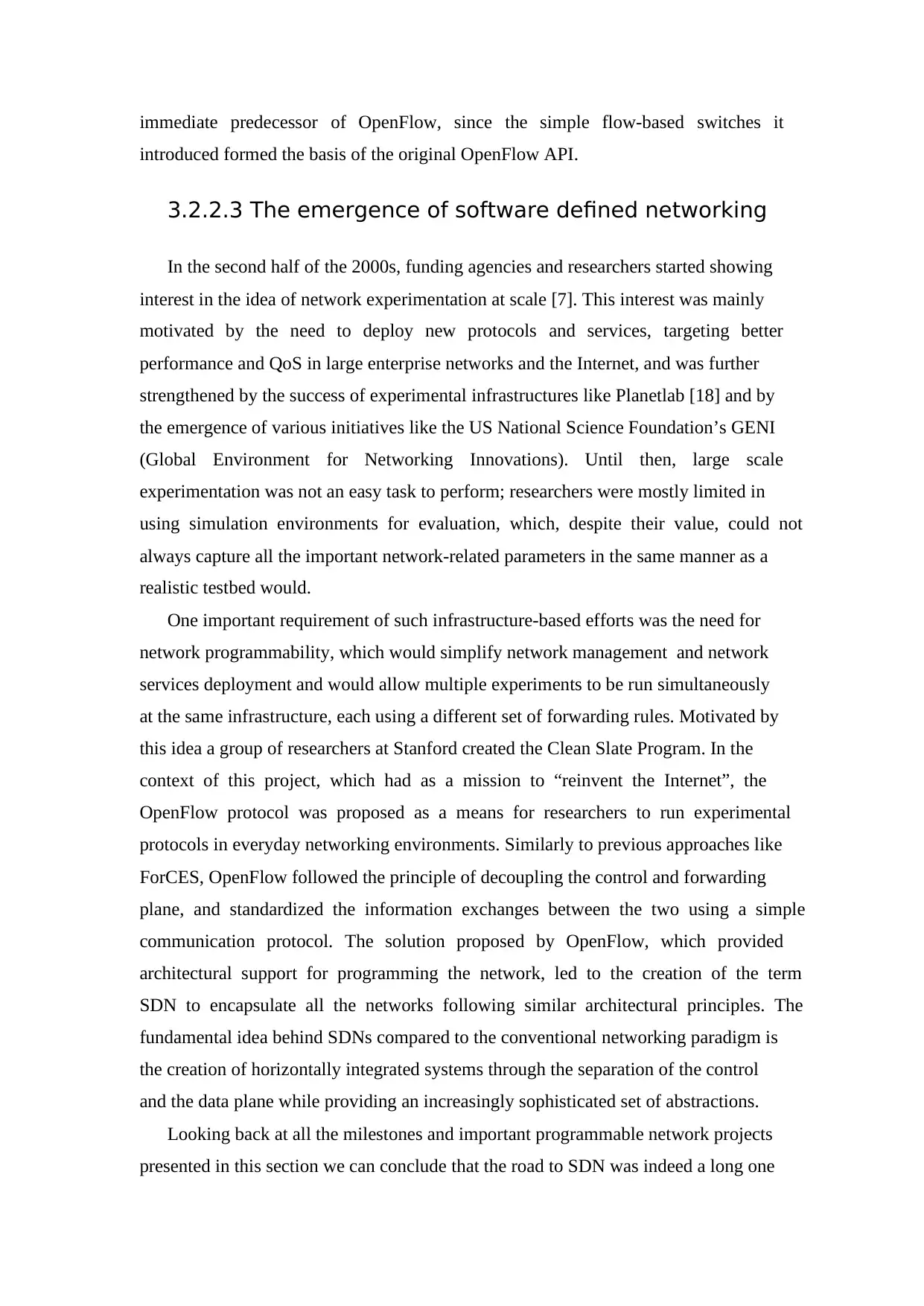
immediate predecessor of OpenFlow, since the simple flow-based switches it
introduced formed the basis of the original OpenFlow API.
3.2.2.3 The emergence of software defined networking
In the second half of the 2000s, funding agencies and researchers started showing
interest in the idea of network experimentation at scale [7]. This interest was mainly
motivated by the need to deploy new protocols and services, targeting better
performance and QoS in large enterprise networks and the Internet, and was further
strengthened by the success of experimental infrastructures like Planetlab [18] and by
the emergence of various initiatives like the US National Science Foundation’s GENI
(Global Environment for Networking Innovations). Until then, large scale
experimentation was not an easy task to perform; researchers were mostly limited in
using simulation environments for evaluation, which, despite their value, could not
always capture all the important network-related parameters in the same manner as a
realistic testbed would.
One important requirement of such infrastructure-based efforts was the need for
network programmability, which would simplify network management and network
services deployment and would allow multiple experiments to be run simultaneously
at the same infrastructure, each using a different set of forwarding rules. Motivated by
this idea a group of researchers at Stanford created the Clean Slate Program. In the
context of this project, which had as a mission to “reinvent the Internet”, the
OpenFlow protocol was proposed as a means for researchers to run experimental
protocols in everyday networking environments. Similarly to previous approaches like
ForCES, OpenFlow followed the principle of decoupling the control and forwarding
plane, and standardized the information exchanges between the two using a simple
communication protocol. The solution proposed by OpenFlow, which provided
architectural support for programming the network, led to the creation of the term
SDN to encapsulate all the networks following similar architectural principles. The
fundamental idea behind SDNs compared to the conventional networking paradigm is
the creation of horizontally integrated systems through the separation of the control
and the data plane while providing an increasingly sophisticated set of abstractions.
Looking back at all the milestones and important programmable network projects
presented in this section we can conclude that the road to SDN was indeed a long one
introduced formed the basis of the original OpenFlow API.
3.2.2.3 The emergence of software defined networking
In the second half of the 2000s, funding agencies and researchers started showing
interest in the idea of network experimentation at scale [7]. This interest was mainly
motivated by the need to deploy new protocols and services, targeting better
performance and QoS in large enterprise networks and the Internet, and was further
strengthened by the success of experimental infrastructures like Planetlab [18] and by
the emergence of various initiatives like the US National Science Foundation’s GENI
(Global Environment for Networking Innovations). Until then, large scale
experimentation was not an easy task to perform; researchers were mostly limited in
using simulation environments for evaluation, which, despite their value, could not
always capture all the important network-related parameters in the same manner as a
realistic testbed would.
One important requirement of such infrastructure-based efforts was the need for
network programmability, which would simplify network management and network
services deployment and would allow multiple experiments to be run simultaneously
at the same infrastructure, each using a different set of forwarding rules. Motivated by
this idea a group of researchers at Stanford created the Clean Slate Program. In the
context of this project, which had as a mission to “reinvent the Internet”, the
OpenFlow protocol was proposed as a means for researchers to run experimental
protocols in everyday networking environments. Similarly to previous approaches like
ForCES, OpenFlow followed the principle of decoupling the control and forwarding
plane, and standardized the information exchanges between the two using a simple
communication protocol. The solution proposed by OpenFlow, which provided
architectural support for programming the network, led to the creation of the term
SDN to encapsulate all the networks following similar architectural principles. The
fundamental idea behind SDNs compared to the conventional networking paradigm is
the creation of horizontally integrated systems through the separation of the control
and the data plane while providing an increasingly sophisticated set of abstractions.
Looking back at all the milestones and important programmable network projects
presented in this section we can conclude that the road to SDN was indeed a long one
Secure Best Marks with AI Grader
Need help grading? Try our AI Grader for instant feedback on your assignments.
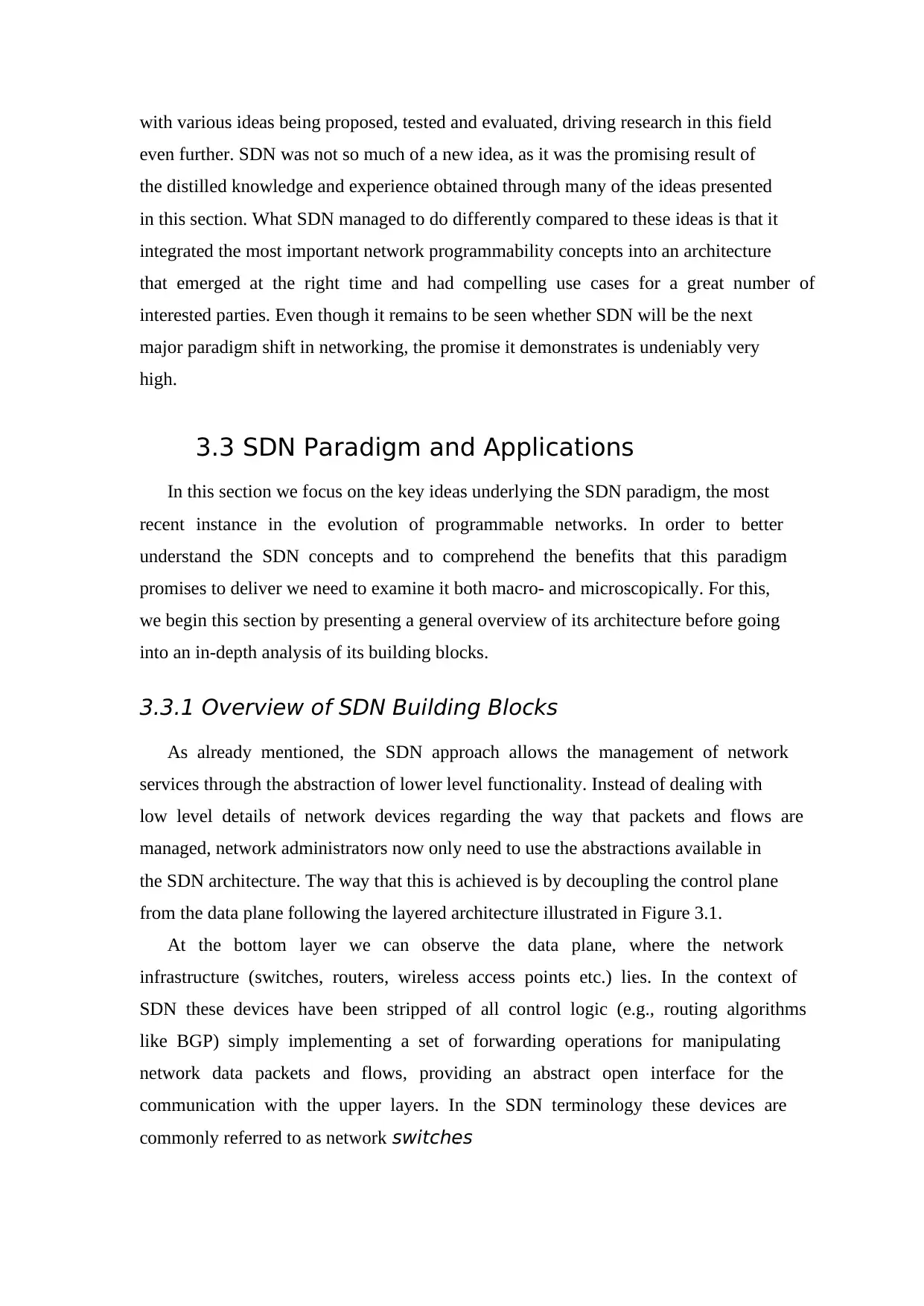
with various ideas being proposed, tested and evaluated, driving research in this field
even further. SDN was not so much of a new idea, as it was the promising result of
the distilled knowledge and experience obtained through many of the ideas presented
in this section. What SDN managed to do differently compared to these ideas is that it
integrated the most important network programmability concepts into an architecture
that emerged at the right time and had compelling use cases for a great number of
interested parties. Even though it remains to be seen whether SDN will be the next
major paradigm shift in networking, the promise it demonstrates is undeniably very
high.
3.3 SDN Paradigm and Applications
In this section we focus on the key ideas underlying the SDN paradigm, the most
recent instance in the evolution of programmable networks. In order to better
understand the SDN concepts and to comprehend the benefits that this paradigm
promises to deliver we need to examine it both macro- and microscopically. For this,
we begin this section by presenting a general overview of its architecture before going
into an in-depth analysis of its building blocks.
3.3.1 Overview of SDN Building Blocks
As already mentioned, the SDN approach allows the management of network
services through the abstraction of lower level functionality. Instead of dealing with
low level details of network devices regarding the way that packets and flows are
managed, network administrators now only need to use the abstractions available in
the SDN architecture. The way that this is achieved is by decoupling the control plane
from the data plane following the layered architecture illustrated in Figure 3.1.
At the bottom layer we can observe the data plane, where the network
infrastructure (switches, routers, wireless access points etc.) lies. In the context of
SDN these devices have been stripped of all control logic (e.g., routing algorithms
like BGP) simply implementing a set of forwarding operations for manipulating
network data packets and flows, providing an abstract open interface for the
communication with the upper layers. In the SDN terminology these devices are
commonly referred to as network switches.
even further. SDN was not so much of a new idea, as it was the promising result of
the distilled knowledge and experience obtained through many of the ideas presented
in this section. What SDN managed to do differently compared to these ideas is that it
integrated the most important network programmability concepts into an architecture
that emerged at the right time and had compelling use cases for a great number of
interested parties. Even though it remains to be seen whether SDN will be the next
major paradigm shift in networking, the promise it demonstrates is undeniably very
high.
3.3 SDN Paradigm and Applications
In this section we focus on the key ideas underlying the SDN paradigm, the most
recent instance in the evolution of programmable networks. In order to better
understand the SDN concepts and to comprehend the benefits that this paradigm
promises to deliver we need to examine it both macro- and microscopically. For this,
we begin this section by presenting a general overview of its architecture before going
into an in-depth analysis of its building blocks.
3.3.1 Overview of SDN Building Blocks
As already mentioned, the SDN approach allows the management of network
services through the abstraction of lower level functionality. Instead of dealing with
low level details of network devices regarding the way that packets and flows are
managed, network administrators now only need to use the abstractions available in
the SDN architecture. The way that this is achieved is by decoupling the control plane
from the data plane following the layered architecture illustrated in Figure 3.1.
At the bottom layer we can observe the data plane, where the network
infrastructure (switches, routers, wireless access points etc.) lies. In the context of
SDN these devices have been stripped of all control logic (e.g., routing algorithms
like BGP) simply implementing a set of forwarding operations for manipulating
network data packets and flows, providing an abstract open interface for the
communication with the upper layers. In the SDN terminology these devices are
commonly referred to as network switches.
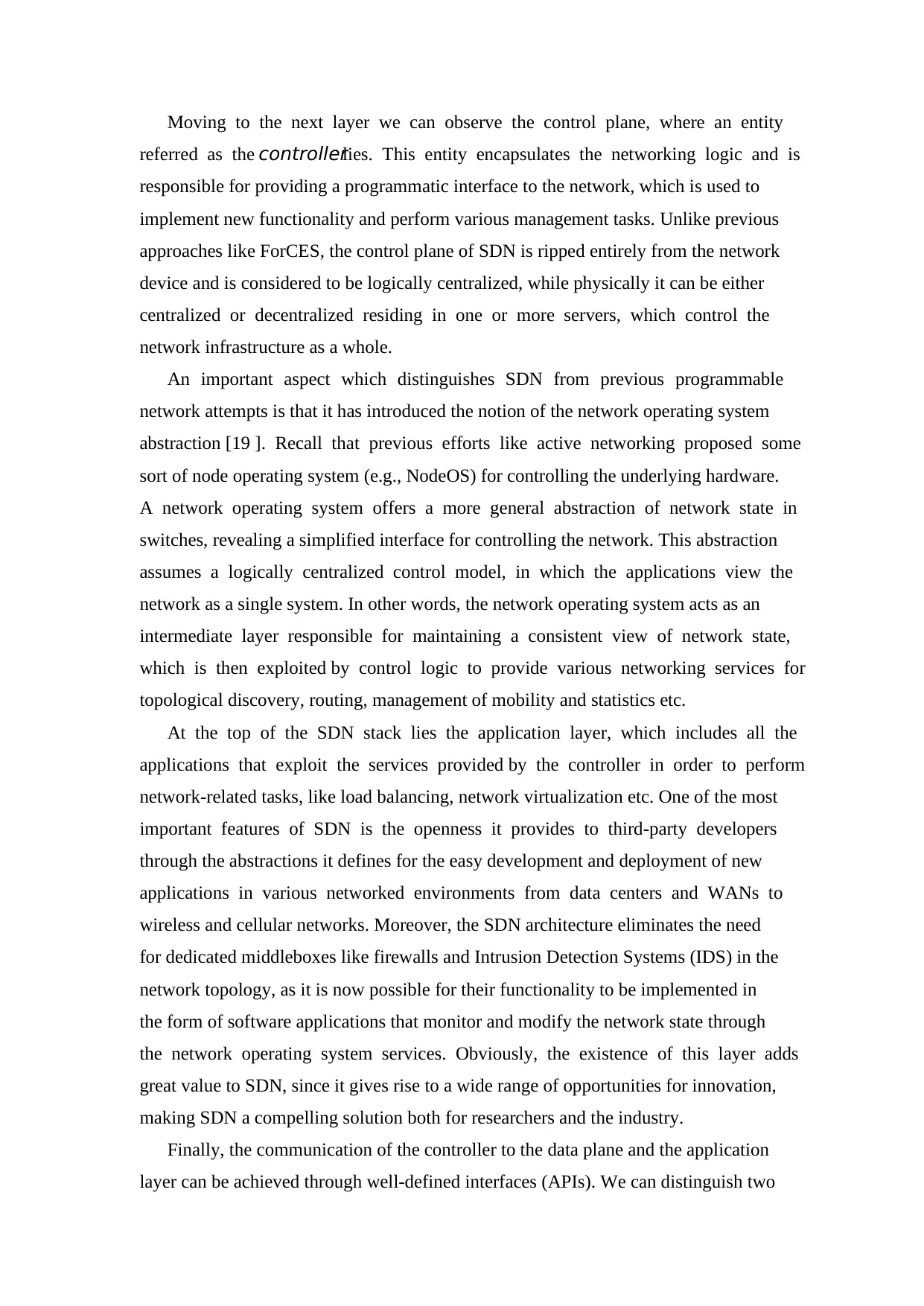
Moving to the next layer we can observe the control plane, where an entity
referred as the controllerlies. This entity encapsulates the networking logic and is
responsible for providing a programmatic interface to the network, which is used to
implement new functionality and perform various management tasks. Unlike previous
approaches like ForCES, the control plane of SDN is ripped entirely from the network
device and is considered to be logically centralized, while physically it can be either
centralized or decentralized residing in one or more servers, which control the
network infrastructure as a whole.
An important aspect which distinguishes SDN from previous programmable
network attempts is that it has introduced the notion of the network operating system
abstraction [19 ]. Recall that previous efforts like active networking proposed some
sort of node operating system (e.g., NodeOS) for controlling the underlying hardware.
A network operating system offers a more general abstraction of network state in
switches, revealing a simplified interface for controlling the network. This abstraction
assumes a logically centralized control model, in which the applications view the
network as a single system. In other words, the network operating system acts as an
intermediate layer responsible for maintaining a consistent view of network state,
which is then exploited by control logic to provide various networking services for
topological discovery, routing, management of mobility and statistics etc.
At the top of the SDN stack lies the application layer, which includes all the
applications that exploit the services provided by the controller in order to perform
network-related tasks, like load balancing, network virtualization etc. One of the most
important features of SDN is the openness it provides to third-party developers
through the abstractions it defines for the easy development and deployment of new
applications in various networked environments from data centers and WANs to
wireless and cellular networks. Moreover, the SDN architecture eliminates the need
for dedicated middleboxes like firewalls and Intrusion Detection Systems (IDS) in the
network topology, as it is now possible for their functionality to be implemented in
the form of software applications that monitor and modify the network state through
the network operating system services. Obviously, the existence of this layer adds
great value to SDN, since it gives rise to a wide range of opportunities for innovation,
making SDN a compelling solution both for researchers and the industry.
Finally, the communication of the controller to the data plane and the application
layer can be achieved through well-defined interfaces (APIs). We can distinguish two
referred as the controllerlies. This entity encapsulates the networking logic and is
responsible for providing a programmatic interface to the network, which is used to
implement new functionality and perform various management tasks. Unlike previous
approaches like ForCES, the control plane of SDN is ripped entirely from the network
device and is considered to be logically centralized, while physically it can be either
centralized or decentralized residing in one or more servers, which control the
network infrastructure as a whole.
An important aspect which distinguishes SDN from previous programmable
network attempts is that it has introduced the notion of the network operating system
abstraction [19 ]. Recall that previous efforts like active networking proposed some
sort of node operating system (e.g., NodeOS) for controlling the underlying hardware.
A network operating system offers a more general abstraction of network state in
switches, revealing a simplified interface for controlling the network. This abstraction
assumes a logically centralized control model, in which the applications view the
network as a single system. In other words, the network operating system acts as an
intermediate layer responsible for maintaining a consistent view of network state,
which is then exploited by control logic to provide various networking services for
topological discovery, routing, management of mobility and statistics etc.
At the top of the SDN stack lies the application layer, which includes all the
applications that exploit the services provided by the controller in order to perform
network-related tasks, like load balancing, network virtualization etc. One of the most
important features of SDN is the openness it provides to third-party developers
through the abstractions it defines for the easy development and deployment of new
applications in various networked environments from data centers and WANs to
wireless and cellular networks. Moreover, the SDN architecture eliminates the need
for dedicated middleboxes like firewalls and Intrusion Detection Systems (IDS) in the
network topology, as it is now possible for their functionality to be implemented in
the form of software applications that monitor and modify the network state through
the network operating system services. Obviously, the existence of this layer adds
great value to SDN, since it gives rise to a wide range of opportunities for innovation,
making SDN a compelling solution both for researchers and the industry.
Finally, the communication of the controller to the data plane and the application
layer can be achieved through well-defined interfaces (APIs). We can distinguish two
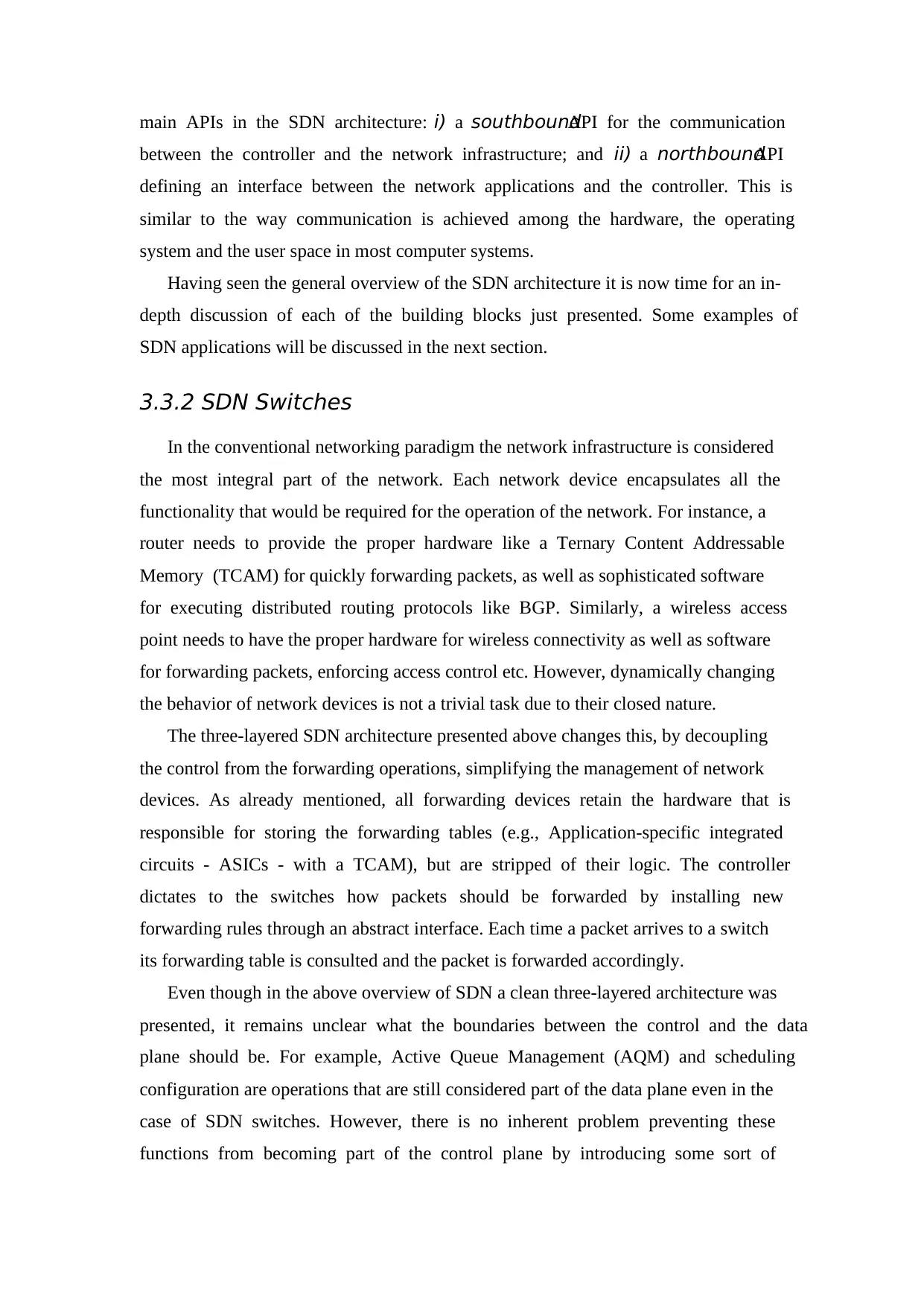
main APIs in the SDN architecture: i) a southboundAPI for the communication
between the controller and the network infrastructure; and ii) a northboundAPI
defining an interface between the network applications and the controller. This is
similar to the way communication is achieved among the hardware, the operating
system and the user space in most computer systems.
Having seen the general overview of the SDN architecture it is now time for an in-
depth discussion of each of the building blocks just presented. Some examples of
SDN applications will be discussed in the next section.
3.3.2 SDN Switches
In the conventional networking paradigm the network infrastructure is considered
the most integral part of the network. Each network device encapsulates all the
functionality that would be required for the operation of the network. For instance, a
router needs to provide the proper hardware like a Ternary Content Addressable
Memory (TCAM) for quickly forwarding packets, as well as sophisticated software
for executing distributed routing protocols like BGP. Similarly, a wireless access
point needs to have the proper hardware for wireless connectivity as well as software
for forwarding packets, enforcing access control etc. However, dynamically changing
the behavior of network devices is not a trivial task due to their closed nature.
The three-layered SDN architecture presented above changes this, by decoupling
the control from the forwarding operations, simplifying the management of network
devices. As already mentioned, all forwarding devices retain the hardware that is
responsible for storing the forwarding tables (e.g., Application-specific integrated
circuits - ASICs - with a TCAM), but are stripped of their logic. The controller
dictates to the switches how packets should be forwarded by installing new
forwarding rules through an abstract interface. Each time a packet arrives to a switch
its forwarding table is consulted and the packet is forwarded accordingly.
Even though in the above overview of SDN a clean three-layered architecture was
presented, it remains unclear what the boundaries between the control and the data
plane should be. For example, Active Queue Management (AQM) and scheduling
configuration are operations that are still considered part of the data plane even in the
case of SDN switches. However, there is no inherent problem preventing these
functions from becoming part of the control plane by introducing some sort of
between the controller and the network infrastructure; and ii) a northboundAPI
defining an interface between the network applications and the controller. This is
similar to the way communication is achieved among the hardware, the operating
system and the user space in most computer systems.
Having seen the general overview of the SDN architecture it is now time for an in-
depth discussion of each of the building blocks just presented. Some examples of
SDN applications will be discussed in the next section.
3.3.2 SDN Switches
In the conventional networking paradigm the network infrastructure is considered
the most integral part of the network. Each network device encapsulates all the
functionality that would be required for the operation of the network. For instance, a
router needs to provide the proper hardware like a Ternary Content Addressable
Memory (TCAM) for quickly forwarding packets, as well as sophisticated software
for executing distributed routing protocols like BGP. Similarly, a wireless access
point needs to have the proper hardware for wireless connectivity as well as software
for forwarding packets, enforcing access control etc. However, dynamically changing
the behavior of network devices is not a trivial task due to their closed nature.
The three-layered SDN architecture presented above changes this, by decoupling
the control from the forwarding operations, simplifying the management of network
devices. As already mentioned, all forwarding devices retain the hardware that is
responsible for storing the forwarding tables (e.g., Application-specific integrated
circuits - ASICs - with a TCAM), but are stripped of their logic. The controller
dictates to the switches how packets should be forwarded by installing new
forwarding rules through an abstract interface. Each time a packet arrives to a switch
its forwarding table is consulted and the packet is forwarded accordingly.
Even though in the above overview of SDN a clean three-layered architecture was
presented, it remains unclear what the boundaries between the control and the data
plane should be. For example, Active Queue Management (AQM) and scheduling
configuration are operations that are still considered part of the data plane even in the
case of SDN switches. However, there is no inherent problem preventing these
functions from becoming part of the control plane by introducing some sort of
Paraphrase This Document
Need a fresh take? Get an instant paraphrase of this document with our AI Paraphraser
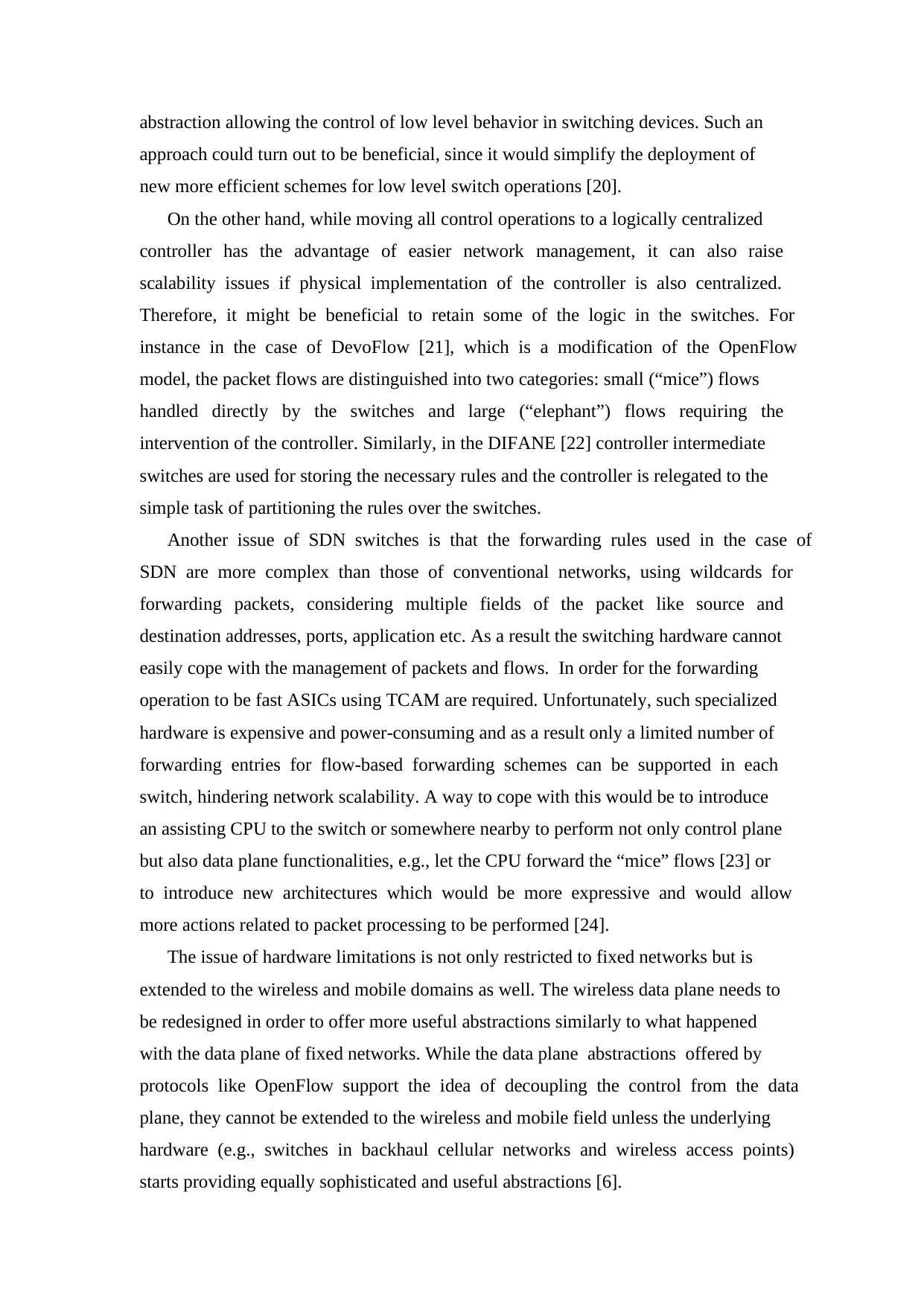
abstraction allowing the control of low level behavior in switching devices. Such an
approach could turn out to be beneficial, since it would simplify the deployment of
new more efficient schemes for low level switch operations [20].
On the other hand, while moving all control operations to a logically centralized
controller has the advantage of easier network management, it can also raise
scalability issues if physical implementation of the controller is also centralized.
Therefore, it might be beneficial to retain some of the logic in the switches. For
instance in the case of DevoFlow [21], which is a modification of the OpenFlow
model, the packet flows are distinguished into two categories: small (“mice”) flows
handled directly by the switches and large (“elephant”) flows requiring the
intervention of the controller. Similarly, in the DIFANE [22] controller intermediate
switches are used for storing the necessary rules and the controller is relegated to the
simple task of partitioning the rules over the switches.
Another issue of SDN switches is that the forwarding rules used in the case of
SDN are more complex than those of conventional networks, using wildcards for
forwarding packets, considering multiple fields of the packet like source and
destination addresses, ports, application etc. As a result the switching hardware cannot
easily cope with the management of packets and flows. In order for the forwarding
operation to be fast ASICs using TCAM are required. Unfortunately, such specialized
hardware is expensive and power-consuming and as a result only a limited number of
forwarding entries for flow-based forwarding schemes can be supported in each
switch, hindering network scalability. A way to cope with this would be to introduce
an assisting CPU to the switch or somewhere nearby to perform not only control plane
but also data plane functionalities, e.g., let the CPU forward the “mice” flows [23] or
to introduce new architectures which would be more expressive and would allow
more actions related to packet processing to be performed [24].
The issue of hardware limitations is not only restricted to fixed networks but is
extended to the wireless and mobile domains as well. The wireless data plane needs to
be redesigned in order to offer more useful abstractions similarly to what happened
with the data plane of fixed networks. While the data plane abstractions offered by
protocols like OpenFlow support the idea of decoupling the control from the data
plane, they cannot be extended to the wireless and mobile field unless the underlying
hardware (e.g., switches in backhaul cellular networks and wireless access points)
starts providing equally sophisticated and useful abstractions [6].
approach could turn out to be beneficial, since it would simplify the deployment of
new more efficient schemes for low level switch operations [20].
On the other hand, while moving all control operations to a logically centralized
controller has the advantage of easier network management, it can also raise
scalability issues if physical implementation of the controller is also centralized.
Therefore, it might be beneficial to retain some of the logic in the switches. For
instance in the case of DevoFlow [21], which is a modification of the OpenFlow
model, the packet flows are distinguished into two categories: small (“mice”) flows
handled directly by the switches and large (“elephant”) flows requiring the
intervention of the controller. Similarly, in the DIFANE [22] controller intermediate
switches are used for storing the necessary rules and the controller is relegated to the
simple task of partitioning the rules over the switches.
Another issue of SDN switches is that the forwarding rules used in the case of
SDN are more complex than those of conventional networks, using wildcards for
forwarding packets, considering multiple fields of the packet like source and
destination addresses, ports, application etc. As a result the switching hardware cannot
easily cope with the management of packets and flows. In order for the forwarding
operation to be fast ASICs using TCAM are required. Unfortunately, such specialized
hardware is expensive and power-consuming and as a result only a limited number of
forwarding entries for flow-based forwarding schemes can be supported in each
switch, hindering network scalability. A way to cope with this would be to introduce
an assisting CPU to the switch or somewhere nearby to perform not only control plane
but also data plane functionalities, e.g., let the CPU forward the “mice” flows [23] or
to introduce new architectures which would be more expressive and would allow
more actions related to packet processing to be performed [24].
The issue of hardware limitations is not only restricted to fixed networks but is
extended to the wireless and mobile domains as well. The wireless data plane needs to
be redesigned in order to offer more useful abstractions similarly to what happened
with the data plane of fixed networks. While the data plane abstractions offered by
protocols like OpenFlow support the idea of decoupling the control from the data
plane, they cannot be extended to the wireless and mobile field unless the underlying
hardware (e.g., switches in backhaul cellular networks and wireless access points)
starts providing equally sophisticated and useful abstractions [6].
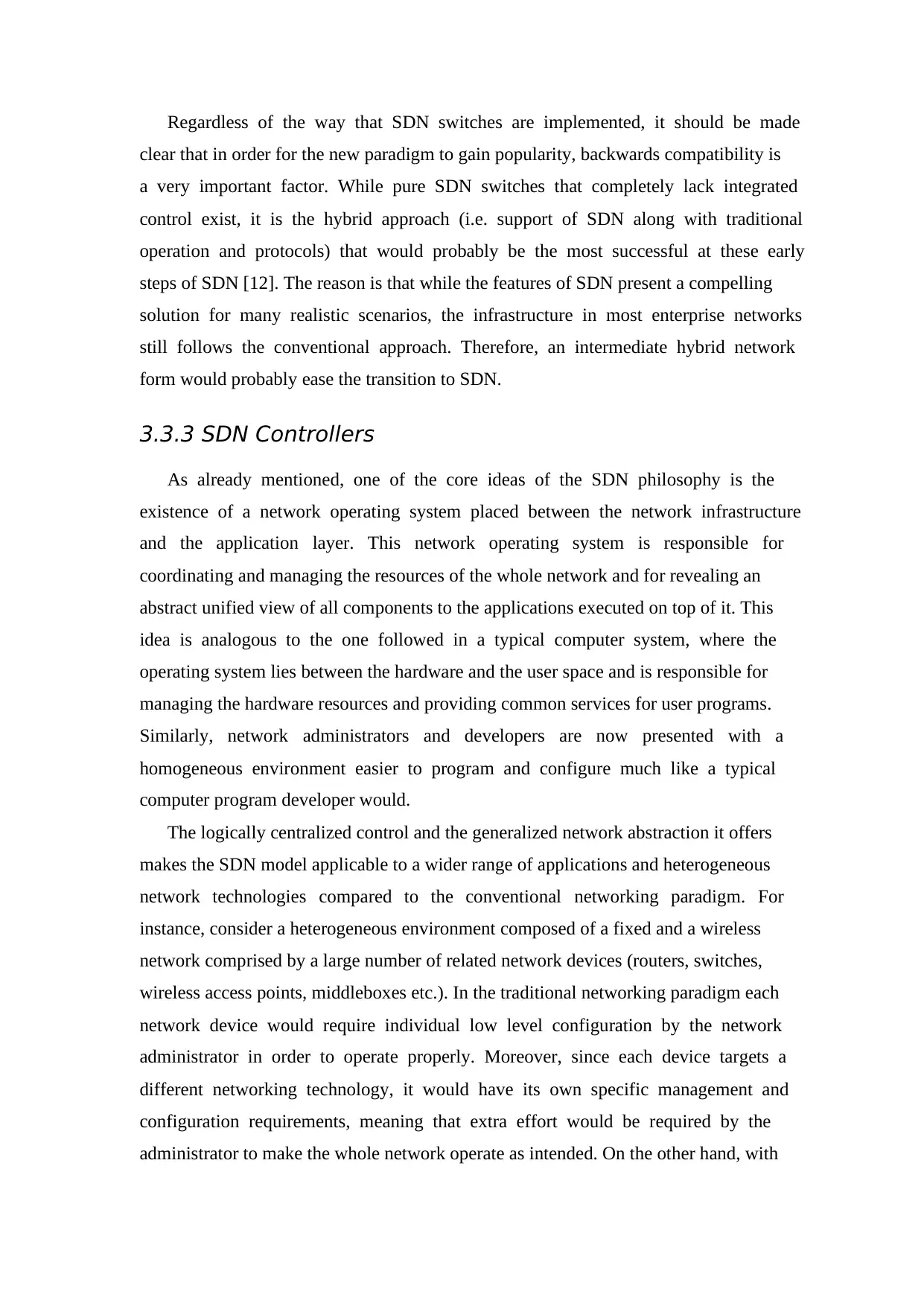
Regardless of the way that SDN switches are implemented, it should be made
clear that in order for the new paradigm to gain popularity, backwards compatibility is
a very important factor. While pure SDN switches that completely lack integrated
control exist, it is the hybrid approach (i.e. support of SDN along with traditional
operation and protocols) that would probably be the most successful at these early
steps of SDN [12]. The reason is that while the features of SDN present a compelling
solution for many realistic scenarios, the infrastructure in most enterprise networks
still follows the conventional approach. Therefore, an intermediate hybrid network
form would probably ease the transition to SDN.
3.3.3 SDN Controllers
As already mentioned, one of the core ideas of the SDN philosophy is the
existence of a network operating system placed between the network infrastructure
and the application layer. This network operating system is responsible for
coordinating and managing the resources of the whole network and for revealing an
abstract unified view of all components to the applications executed on top of it. This
idea is analogous to the one followed in a typical computer system, where the
operating system lies between the hardware and the user space and is responsible for
managing the hardware resources and providing common services for user programs.
Similarly, network administrators and developers are now presented with a
homogeneous environment easier to program and configure much like a typical
computer program developer would.
The logically centralized control and the generalized network abstraction it offers
makes the SDN model applicable to a wider range of applications and heterogeneous
network technologies compared to the conventional networking paradigm. For
instance, consider a heterogeneous environment composed of a fixed and a wireless
network comprised by a large number of related network devices (routers, switches,
wireless access points, middleboxes etc.). In the traditional networking paradigm each
network device would require individual low level configuration by the network
administrator in order to operate properly. Moreover, since each device targets a
different networking technology, it would have its own specific management and
configuration requirements, meaning that extra effort would be required by the
administrator to make the whole network operate as intended. On the other hand, with
clear that in order for the new paradigm to gain popularity, backwards compatibility is
a very important factor. While pure SDN switches that completely lack integrated
control exist, it is the hybrid approach (i.e. support of SDN along with traditional
operation and protocols) that would probably be the most successful at these early
steps of SDN [12]. The reason is that while the features of SDN present a compelling
solution for many realistic scenarios, the infrastructure in most enterprise networks
still follows the conventional approach. Therefore, an intermediate hybrid network
form would probably ease the transition to SDN.
3.3.3 SDN Controllers
As already mentioned, one of the core ideas of the SDN philosophy is the
existence of a network operating system placed between the network infrastructure
and the application layer. This network operating system is responsible for
coordinating and managing the resources of the whole network and for revealing an
abstract unified view of all components to the applications executed on top of it. This
idea is analogous to the one followed in a typical computer system, where the
operating system lies between the hardware and the user space and is responsible for
managing the hardware resources and providing common services for user programs.
Similarly, network administrators and developers are now presented with a
homogeneous environment easier to program and configure much like a typical
computer program developer would.
The logically centralized control and the generalized network abstraction it offers
makes the SDN model applicable to a wider range of applications and heterogeneous
network technologies compared to the conventional networking paradigm. For
instance, consider a heterogeneous environment composed of a fixed and a wireless
network comprised by a large number of related network devices (routers, switches,
wireless access points, middleboxes etc.). In the traditional networking paradigm each
network device would require individual low level configuration by the network
administrator in order to operate properly. Moreover, since each device targets a
different networking technology, it would have its own specific management and
configuration requirements, meaning that extra effort would be required by the
administrator to make the whole network operate as intended. On the other hand, with
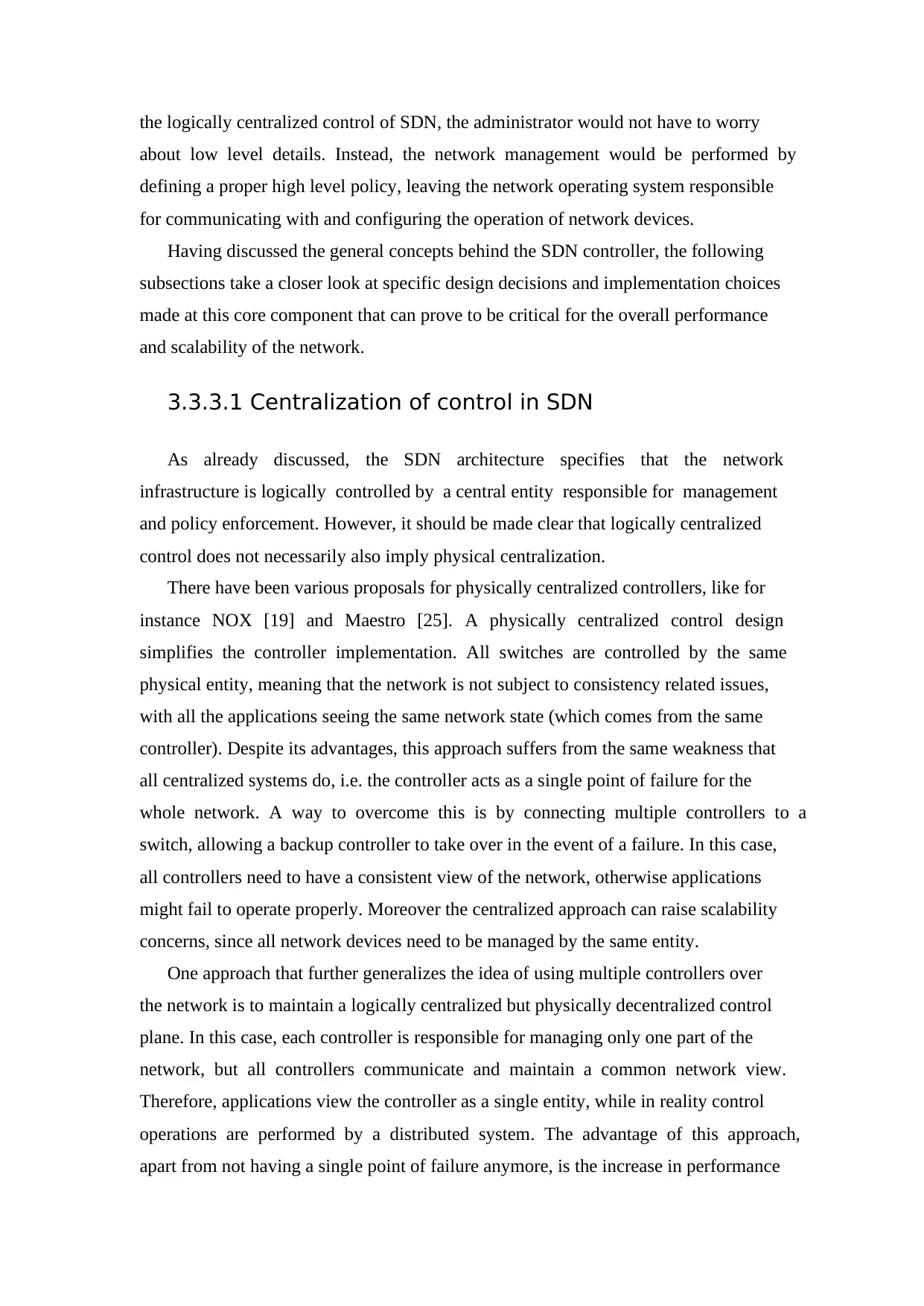
the logically centralized control of SDN, the administrator would not have to worry
about low level details. Instead, the network management would be performed by
defining a proper high level policy, leaving the network operating system responsible
for communicating with and configuring the operation of network devices.
Having discussed the general concepts behind the SDN controller, the following
subsections take a closer look at specific design decisions and implementation choices
made at this core component that can prove to be critical for the overall performance
and scalability of the network.
3.3.3.1 Centralization of control in SDN
As already discussed, the SDN architecture specifies that the network
infrastructure is logically controlled by a central entity responsible for management
and policy enforcement. However, it should be made clear that logically centralized
control does not necessarily also imply physical centralization.
There have been various proposals for physically centralized controllers, like for
instance NOX [19] and Maestro [25]. A physically centralized control design
simplifies the controller implementation. All switches are controlled by the same
physical entity, meaning that the network is not subject to consistency related issues,
with all the applications seeing the same network state (which comes from the same
controller). Despite its advantages, this approach suffers from the same weakness that
all centralized systems do, i.e. the controller acts as a single point of failure for the
whole network. A way to overcome this is by connecting multiple controllers to a
switch, allowing a backup controller to take over in the event of a failure. In this case,
all controllers need to have a consistent view of the network, otherwise applications
might fail to operate properly. Moreover the centralized approach can raise scalability
concerns, since all network devices need to be managed by the same entity.
One approach that further generalizes the idea of using multiple controllers over
the network is to maintain a logically centralized but physically decentralized control
plane. In this case, each controller is responsible for managing only one part of the
network, but all controllers communicate and maintain a common network view.
Therefore, applications view the controller as a single entity, while in reality control
operations are performed by a distributed system. The advantage of this approach,
apart from not having a single point of failure anymore, is the increase in performance
about low level details. Instead, the network management would be performed by
defining a proper high level policy, leaving the network operating system responsible
for communicating with and configuring the operation of network devices.
Having discussed the general concepts behind the SDN controller, the following
subsections take a closer look at specific design decisions and implementation choices
made at this core component that can prove to be critical for the overall performance
and scalability of the network.
3.3.3.1 Centralization of control in SDN
As already discussed, the SDN architecture specifies that the network
infrastructure is logically controlled by a central entity responsible for management
and policy enforcement. However, it should be made clear that logically centralized
control does not necessarily also imply physical centralization.
There have been various proposals for physically centralized controllers, like for
instance NOX [19] and Maestro [25]. A physically centralized control design
simplifies the controller implementation. All switches are controlled by the same
physical entity, meaning that the network is not subject to consistency related issues,
with all the applications seeing the same network state (which comes from the same
controller). Despite its advantages, this approach suffers from the same weakness that
all centralized systems do, i.e. the controller acts as a single point of failure for the
whole network. A way to overcome this is by connecting multiple controllers to a
switch, allowing a backup controller to take over in the event of a failure. In this case,
all controllers need to have a consistent view of the network, otherwise applications
might fail to operate properly. Moreover the centralized approach can raise scalability
concerns, since all network devices need to be managed by the same entity.
One approach that further generalizes the idea of using multiple controllers over
the network is to maintain a logically centralized but physically decentralized control
plane. In this case, each controller is responsible for managing only one part of the
network, but all controllers communicate and maintain a common network view.
Therefore, applications view the controller as a single entity, while in reality control
operations are performed by a distributed system. The advantage of this approach,
apart from not having a single point of failure anymore, is the increase in performance
Secure Best Marks with AI Grader
Need help grading? Try our AI Grader for instant feedback on your assignments.
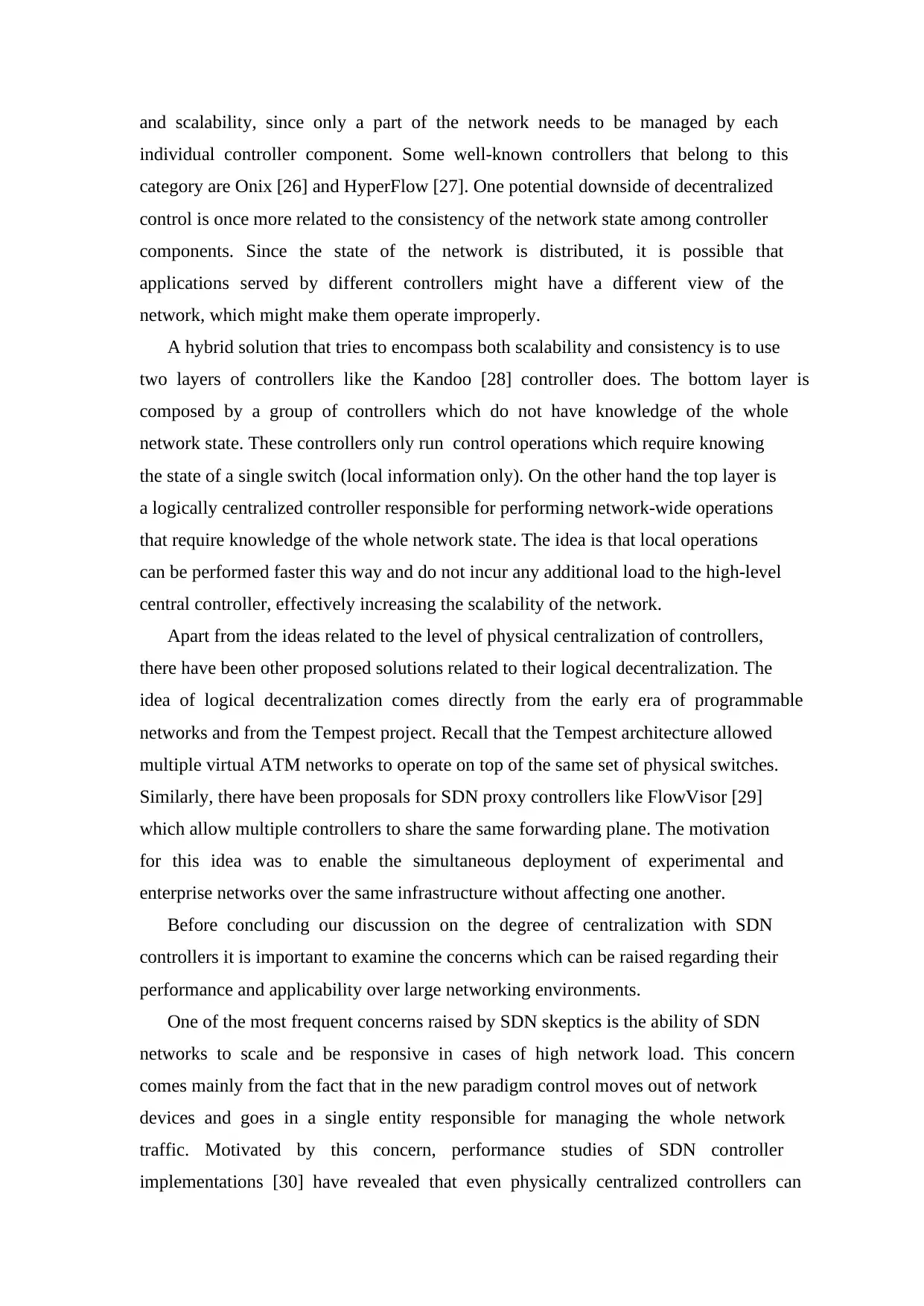
and scalability, since only a part of the network needs to be managed by each
individual controller component. Some well-known controllers that belong to this
category are Onix [26] and HyperFlow [27]. One potential downside of decentralized
control is once more related to the consistency of the network state among controller
components. Since the state of the network is distributed, it is possible that
applications served by different controllers might have a different view of the
network, which might make them operate improperly.
A hybrid solution that tries to encompass both scalability and consistency is to use
two layers of controllers like the Kandoo [28] controller does. The bottom layer is
composed by a group of controllers which do not have knowledge of the whole
network state. These controllers only run control operations which require knowing
the state of a single switch (local information only). On the other hand the top layer is
a logically centralized controller responsible for performing network-wide operations
that require knowledge of the whole network state. The idea is that local operations
can be performed faster this way and do not incur any additional load to the high-level
central controller, effectively increasing the scalability of the network.
Apart from the ideas related to the level of physical centralization of controllers,
there have been other proposed solutions related to their logical decentralization. The
idea of logical decentralization comes directly from the early era of programmable
networks and from the Tempest project. Recall that the Tempest architecture allowed
multiple virtual ATM networks to operate on top of the same set of physical switches.
Similarly, there have been proposals for SDN proxy controllers like FlowVisor [29]
which allow multiple controllers to share the same forwarding plane. The motivation
for this idea was to enable the simultaneous deployment of experimental and
enterprise networks over the same infrastructure without affecting one another.
Before concluding our discussion on the degree of centralization with SDN
controllers it is important to examine the concerns which can be raised regarding their
performance and applicability over large networking environments.
One of the most frequent concerns raised by SDN skeptics is the ability of SDN
networks to scale and be responsive in cases of high network load. This concern
comes mainly from the fact that in the new paradigm control moves out of network
devices and goes in a single entity responsible for managing the whole network
traffic. Motivated by this concern, performance studies of SDN controller
implementations [30] have revealed that even physically centralized controllers can
individual controller component. Some well-known controllers that belong to this
category are Onix [26] and HyperFlow [27]. One potential downside of decentralized
control is once more related to the consistency of the network state among controller
components. Since the state of the network is distributed, it is possible that
applications served by different controllers might have a different view of the
network, which might make them operate improperly.
A hybrid solution that tries to encompass both scalability and consistency is to use
two layers of controllers like the Kandoo [28] controller does. The bottom layer is
composed by a group of controllers which do not have knowledge of the whole
network state. These controllers only run control operations which require knowing
the state of a single switch (local information only). On the other hand the top layer is
a logically centralized controller responsible for performing network-wide operations
that require knowledge of the whole network state. The idea is that local operations
can be performed faster this way and do not incur any additional load to the high-level
central controller, effectively increasing the scalability of the network.
Apart from the ideas related to the level of physical centralization of controllers,
there have been other proposed solutions related to their logical decentralization. The
idea of logical decentralization comes directly from the early era of programmable
networks and from the Tempest project. Recall that the Tempest architecture allowed
multiple virtual ATM networks to operate on top of the same set of physical switches.
Similarly, there have been proposals for SDN proxy controllers like FlowVisor [29]
which allow multiple controllers to share the same forwarding plane. The motivation
for this idea was to enable the simultaneous deployment of experimental and
enterprise networks over the same infrastructure without affecting one another.
Before concluding our discussion on the degree of centralization with SDN
controllers it is important to examine the concerns which can be raised regarding their
performance and applicability over large networking environments.
One of the most frequent concerns raised by SDN skeptics is the ability of SDN
networks to scale and be responsive in cases of high network load. This concern
comes mainly from the fact that in the new paradigm control moves out of network
devices and goes in a single entity responsible for managing the whole network
traffic. Motivated by this concern, performance studies of SDN controller
implementations [30] have revealed that even physically centralized controllers can
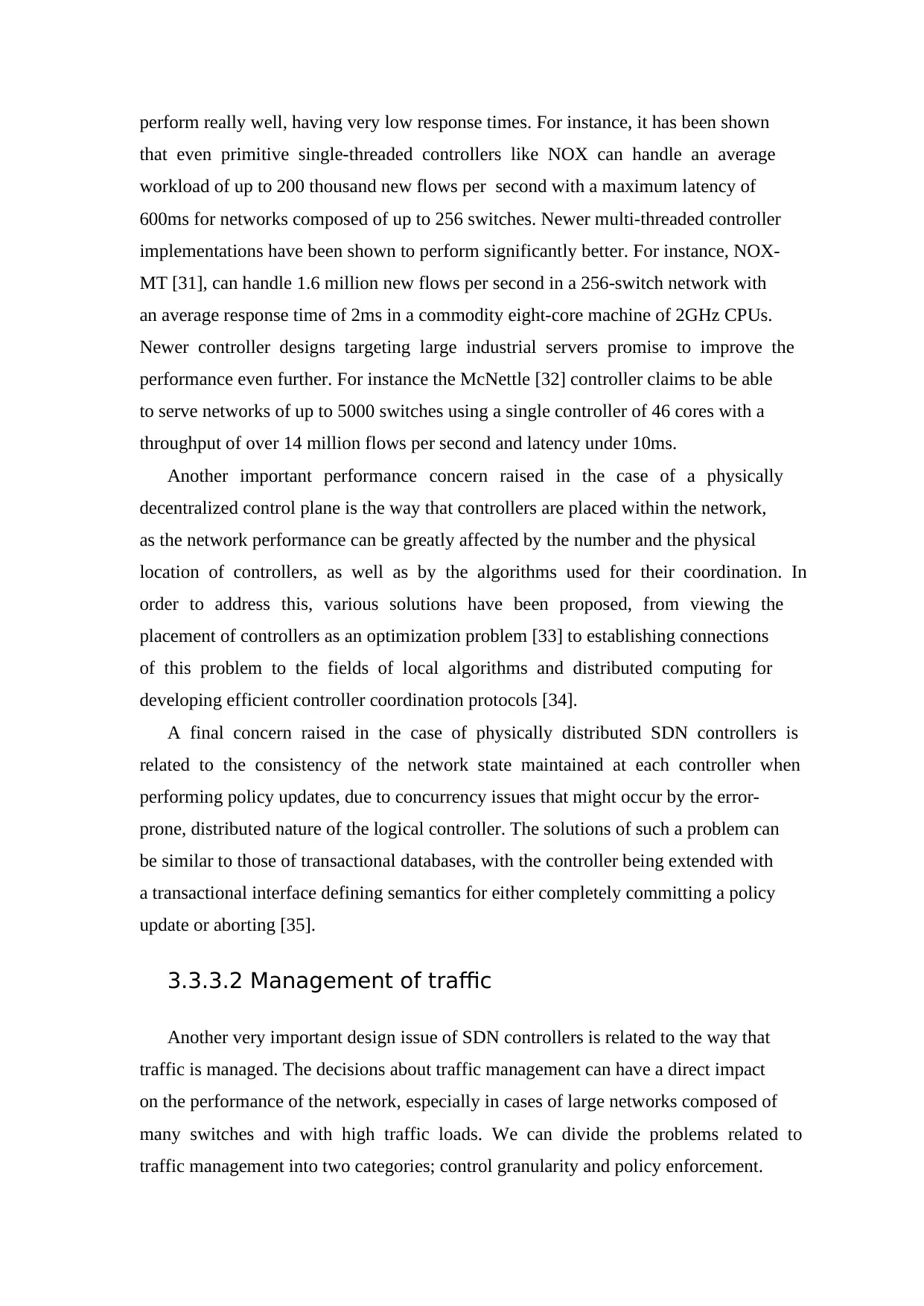
perform really well, having very low response times. For instance, it has been shown
that even primitive single-threaded controllers like NOX can handle an average
workload of up to 200 thousand new flows per second with a maximum latency of
600ms for networks composed of up to 256 switches. Newer multi-threaded controller
implementations have been shown to perform significantly better. For instance, NOX-
MT [31], can handle 1.6 million new flows per second in a 256-switch network with
an average response time of 2ms in a commodity eight-core machine of 2GHz CPUs.
Newer controller designs targeting large industrial servers promise to improve the
performance even further. For instance the McNettle [32] controller claims to be able
to serve networks of up to 5000 switches using a single controller of 46 cores with a
throughput of over 14 million flows per second and latency under 10ms.
Another important performance concern raised in the case of a physically
decentralized control plane is the way that controllers are placed within the network,
as the network performance can be greatly affected by the number and the physical
location of controllers, as well as by the algorithms used for their coordination. In
order to address this, various solutions have been proposed, from viewing the
placement of controllers as an optimization problem [33] to establishing connections
of this problem to the fields of local algorithms and distributed computing for
developing efficient controller coordination protocols [34].
A final concern raised in the case of physically distributed SDN controllers is
related to the consistency of the network state maintained at each controller when
performing policy updates, due to concurrency issues that might occur by the error-
prone, distributed nature of the logical controller. The solutions of such a problem can
be similar to those of transactional databases, with the controller being extended with
a transactional interface defining semantics for either completely committing a policy
update or aborting [35].
3.3.3.2 Management of traffic
Another very important design issue of SDN controllers is related to the way that
traffic is managed. The decisions about traffic management can have a direct impact
on the performance of the network, especially in cases of large networks composed of
many switches and with high traffic loads. We can divide the problems related to
traffic management into two categories; control granularity and policy enforcement.
that even primitive single-threaded controllers like NOX can handle an average
workload of up to 200 thousand new flows per second with a maximum latency of
600ms for networks composed of up to 256 switches. Newer multi-threaded controller
implementations have been shown to perform significantly better. For instance, NOX-
MT [31], can handle 1.6 million new flows per second in a 256-switch network with
an average response time of 2ms in a commodity eight-core machine of 2GHz CPUs.
Newer controller designs targeting large industrial servers promise to improve the
performance even further. For instance the McNettle [32] controller claims to be able
to serve networks of up to 5000 switches using a single controller of 46 cores with a
throughput of over 14 million flows per second and latency under 10ms.
Another important performance concern raised in the case of a physically
decentralized control plane is the way that controllers are placed within the network,
as the network performance can be greatly affected by the number and the physical
location of controllers, as well as by the algorithms used for their coordination. In
order to address this, various solutions have been proposed, from viewing the
placement of controllers as an optimization problem [33] to establishing connections
of this problem to the fields of local algorithms and distributed computing for
developing efficient controller coordination protocols [34].
A final concern raised in the case of physically distributed SDN controllers is
related to the consistency of the network state maintained at each controller when
performing policy updates, due to concurrency issues that might occur by the error-
prone, distributed nature of the logical controller. The solutions of such a problem can
be similar to those of transactional databases, with the controller being extended with
a transactional interface defining semantics for either completely committing a policy
update or aborting [35].
3.3.3.2 Management of traffic
Another very important design issue of SDN controllers is related to the way that
traffic is managed. The decisions about traffic management can have a direct impact
on the performance of the network, especially in cases of large networks composed of
many switches and with high traffic loads. We can divide the problems related to
traffic management into two categories; control granularity and policy enforcement.
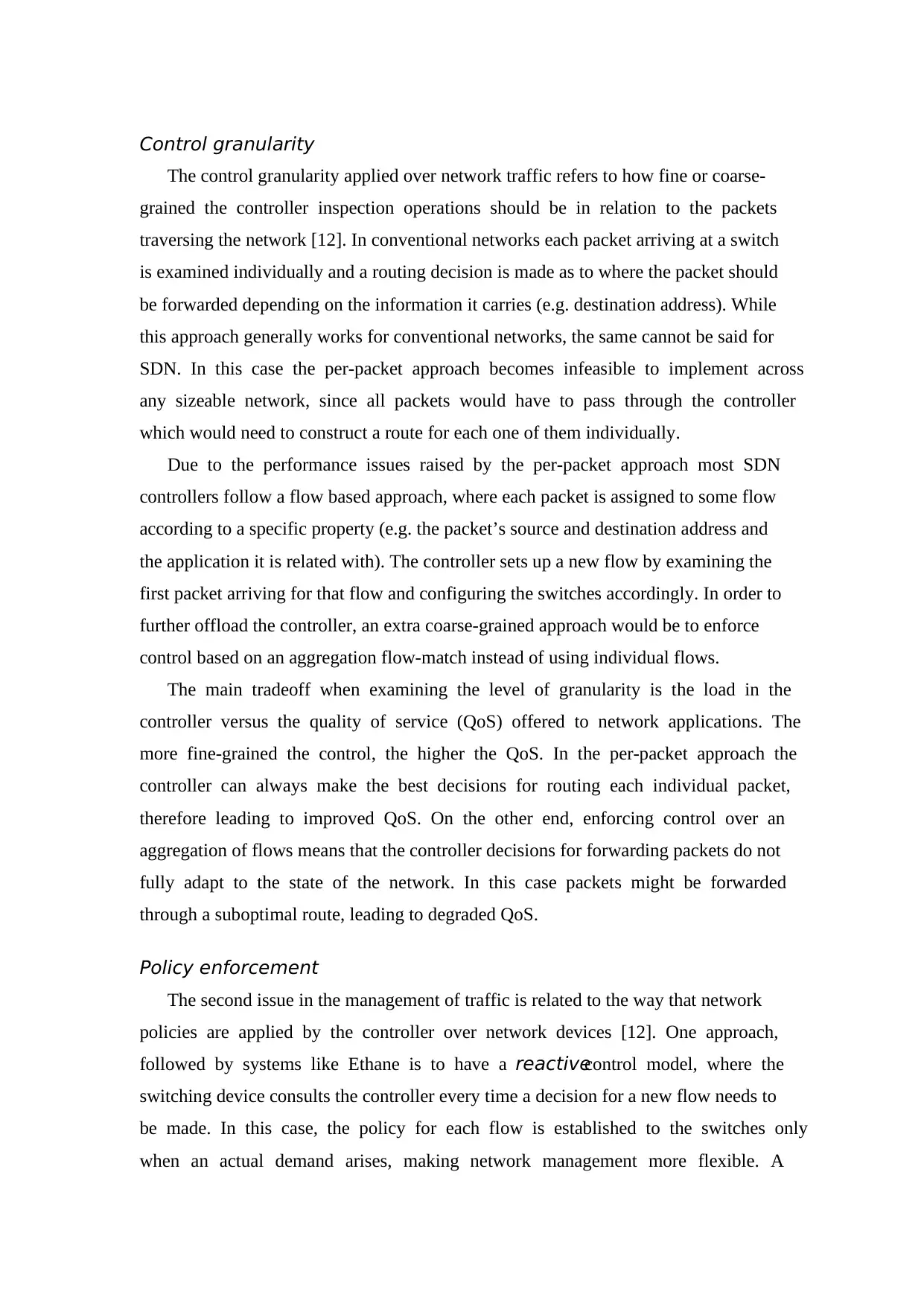
Control granularity
The control granularity applied over network traffic refers to how fine or coarse-
grained the controller inspection operations should be in relation to the packets
traversing the network [12]. In conventional networks each packet arriving at a switch
is examined individually and a routing decision is made as to where the packet should
be forwarded depending on the information it carries (e.g. destination address). While
this approach generally works for conventional networks, the same cannot be said for
SDN. In this case the per-packet approach becomes infeasible to implement across
any sizeable network, since all packets would have to pass through the controller
which would need to construct a route for each one of them individually.
Due to the performance issues raised by the per-packet approach most SDN
controllers follow a flow based approach, where each packet is assigned to some flow
according to a specific property (e.g. the packet’s source and destination address and
the application it is related with). The controller sets up a new flow by examining the
first packet arriving for that flow and configuring the switches accordingly. In order to
further offload the controller, an extra coarse-grained approach would be to enforce
control based on an aggregation flow-match instead of using individual flows.
The main tradeoff when examining the level of granularity is the load in the
controller versus the quality of service (QoS) offered to network applications. The
more fine-grained the control, the higher the QoS. In the per-packet approach the
controller can always make the best decisions for routing each individual packet,
therefore leading to improved QoS. On the other end, enforcing control over an
aggregation of flows means that the controller decisions for forwarding packets do not
fully adapt to the state of the network. In this case packets might be forwarded
through a suboptimal route, leading to degraded QoS.
Policy enforcement
The second issue in the management of traffic is related to the way that network
policies are applied by the controller over network devices [12]. One approach,
followed by systems like Ethane is to have a reactivecontrol model, where the
switching device consults the controller every time a decision for a new flow needs to
be made. In this case, the policy for each flow is established to the switches only
when an actual demand arises, making network management more flexible. A
The control granularity applied over network traffic refers to how fine or coarse-
grained the controller inspection operations should be in relation to the packets
traversing the network [12]. In conventional networks each packet arriving at a switch
is examined individually and a routing decision is made as to where the packet should
be forwarded depending on the information it carries (e.g. destination address). While
this approach generally works for conventional networks, the same cannot be said for
SDN. In this case the per-packet approach becomes infeasible to implement across
any sizeable network, since all packets would have to pass through the controller
which would need to construct a route for each one of them individually.
Due to the performance issues raised by the per-packet approach most SDN
controllers follow a flow based approach, where each packet is assigned to some flow
according to a specific property (e.g. the packet’s source and destination address and
the application it is related with). The controller sets up a new flow by examining the
first packet arriving for that flow and configuring the switches accordingly. In order to
further offload the controller, an extra coarse-grained approach would be to enforce
control based on an aggregation flow-match instead of using individual flows.
The main tradeoff when examining the level of granularity is the load in the
controller versus the quality of service (QoS) offered to network applications. The
more fine-grained the control, the higher the QoS. In the per-packet approach the
controller can always make the best decisions for routing each individual packet,
therefore leading to improved QoS. On the other end, enforcing control over an
aggregation of flows means that the controller decisions for forwarding packets do not
fully adapt to the state of the network. In this case packets might be forwarded
through a suboptimal route, leading to degraded QoS.
Policy enforcement
The second issue in the management of traffic is related to the way that network
policies are applied by the controller over network devices [12]. One approach,
followed by systems like Ethane is to have a reactivecontrol model, where the
switching device consults the controller every time a decision for a new flow needs to
be made. In this case, the policy for each flow is established to the switches only
when an actual demand arises, making network management more flexible. A
Paraphrase This Document
Need a fresh take? Get an instant paraphrase of this document with our AI Paraphraser
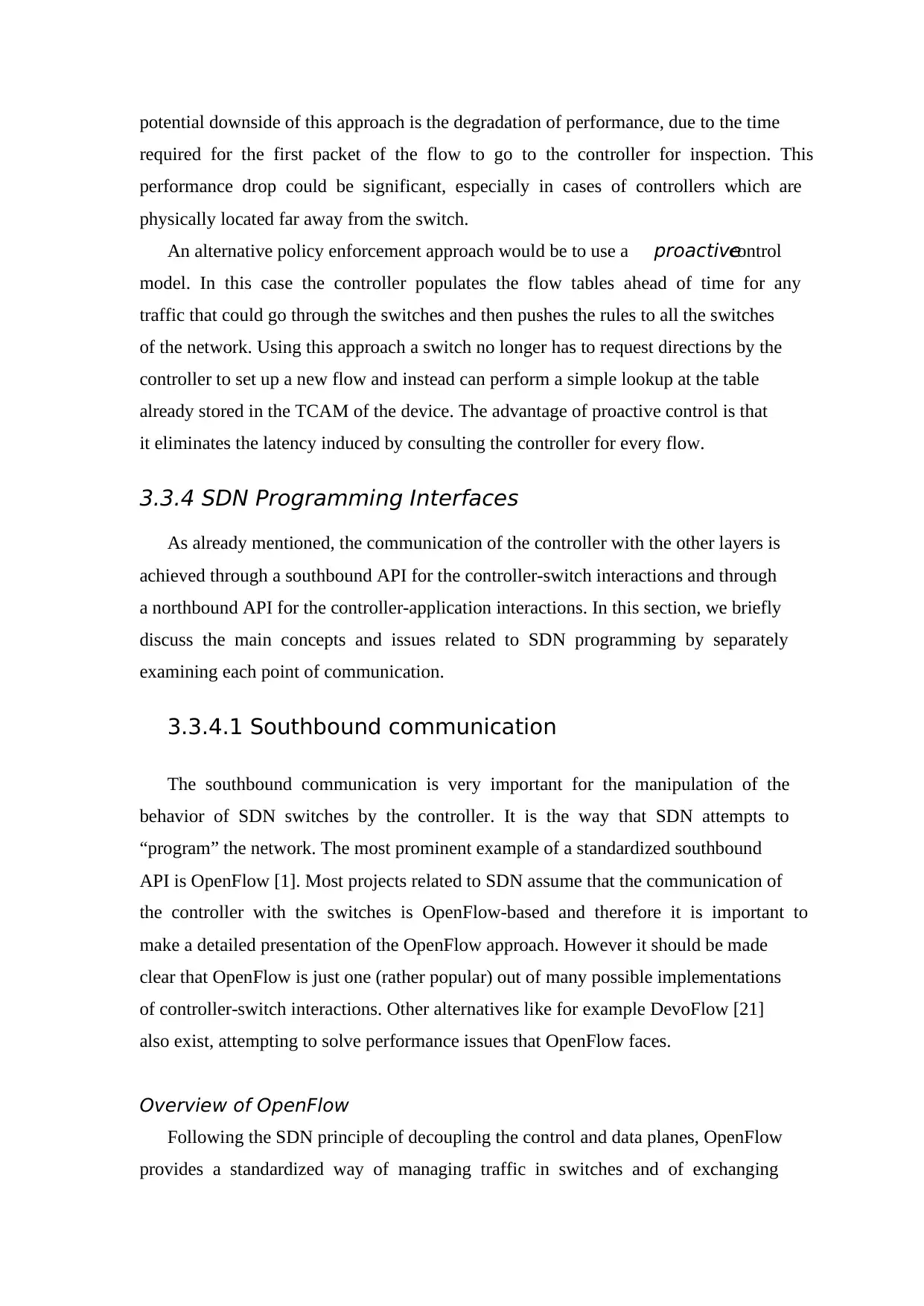
potential downside of this approach is the degradation of performance, due to the time
required for the first packet of the flow to go to the controller for inspection. This
performance drop could be significant, especially in cases of controllers which are
physically located far away from the switch.
An alternative policy enforcement approach would be to use a proactivecontrol
model. In this case the controller populates the flow tables ahead of time for any
traffic that could go through the switches and then pushes the rules to all the switches
of the network. Using this approach a switch no longer has to request directions by the
controller to set up a new flow and instead can perform a simple lookup at the table
already stored in the TCAM of the device. The advantage of proactive control is that
it eliminates the latency induced by consulting the controller for every flow.
3.3.4 SDN Programming Interfaces
As already mentioned, the communication of the controller with the other layers is
achieved through a southbound API for the controller-switch interactions and through
a northbound API for the controller-application interactions. In this section, we briefly
discuss the main concepts and issues related to SDN programming by separately
examining each point of communication.
3.3.4.1 Southbound communication
The southbound communication is very important for the manipulation of the
behavior of SDN switches by the controller. It is the way that SDN attempts to
“program” the network. The most prominent example of a standardized southbound
API is OpenFlow [1]. Most projects related to SDN assume that the communication of
the controller with the switches is OpenFlow-based and therefore it is important to
make a detailed presentation of the OpenFlow approach. However it should be made
clear that OpenFlow is just one (rather popular) out of many possible implementations
of controller-switch interactions. Other alternatives like for example DevoFlow [21]
also exist, attempting to solve performance issues that OpenFlow faces.
Overview of OpenFlow
Following the SDN principle of decoupling the control and data planes, OpenFlow
provides a standardized way of managing traffic in switches and of exchanging
required for the first packet of the flow to go to the controller for inspection. This
performance drop could be significant, especially in cases of controllers which are
physically located far away from the switch.
An alternative policy enforcement approach would be to use a proactivecontrol
model. In this case the controller populates the flow tables ahead of time for any
traffic that could go through the switches and then pushes the rules to all the switches
of the network. Using this approach a switch no longer has to request directions by the
controller to set up a new flow and instead can perform a simple lookup at the table
already stored in the TCAM of the device. The advantage of proactive control is that
it eliminates the latency induced by consulting the controller for every flow.
3.3.4 SDN Programming Interfaces
As already mentioned, the communication of the controller with the other layers is
achieved through a southbound API for the controller-switch interactions and through
a northbound API for the controller-application interactions. In this section, we briefly
discuss the main concepts and issues related to SDN programming by separately
examining each point of communication.
3.3.4.1 Southbound communication
The southbound communication is very important for the manipulation of the
behavior of SDN switches by the controller. It is the way that SDN attempts to
“program” the network. The most prominent example of a standardized southbound
API is OpenFlow [1]. Most projects related to SDN assume that the communication of
the controller with the switches is OpenFlow-based and therefore it is important to
make a detailed presentation of the OpenFlow approach. However it should be made
clear that OpenFlow is just one (rather popular) out of many possible implementations
of controller-switch interactions. Other alternatives like for example DevoFlow [21]
also exist, attempting to solve performance issues that OpenFlow faces.
Overview of OpenFlow
Following the SDN principle of decoupling the control and data planes, OpenFlow
provides a standardized way of managing traffic in switches and of exchanging
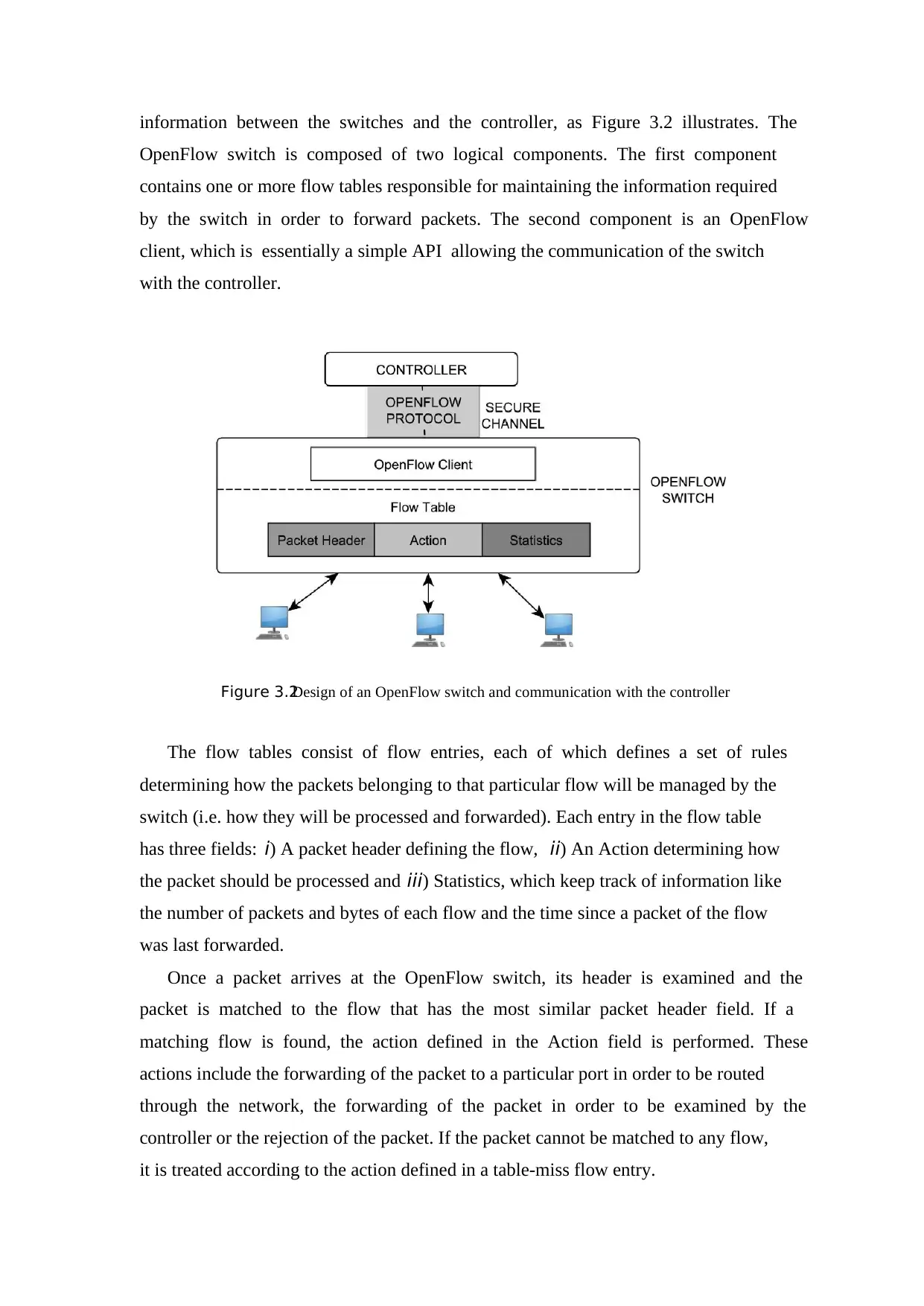
information between the switches and the controller, as Figure 3.2 illustrates. The
OpenFlow switch is composed of two logical components. The first component
contains one or more flow tables responsible for maintaining the information required
by the switch in order to forward packets. The second component is an OpenFlow
client, which is essentially a simple API allowing the communication of the switch
with the controller.
Figure 3.2Design of an OpenFlow switch and communication with the controller
The flow tables consist of flow entries, each of which defines a set of rules
determining how the packets belonging to that particular flow will be managed by the
switch (i.e. how they will be processed and forwarded). Each entry in the flow table
has three fields: i) A packet header defining the flow, ii) An Action determining how
the packet should be processed and iii) Statistics, which keep track of information like
the number of packets and bytes of each flow and the time since a packet of the flow
was last forwarded.
Once a packet arrives at the OpenFlow switch, its header is examined and the
packet is matched to the flow that has the most similar packet header field. If a
matching flow is found, the action defined in the Action field is performed. These
actions include the forwarding of the packet to a particular port in order to be routed
through the network, the forwarding of the packet in order to be examined by the
controller or the rejection of the packet. If the packet cannot be matched to any flow,
it is treated according to the action defined in a table-miss flow entry.
OpenFlow switch is composed of two logical components. The first component
contains one or more flow tables responsible for maintaining the information required
by the switch in order to forward packets. The second component is an OpenFlow
client, which is essentially a simple API allowing the communication of the switch
with the controller.
Figure 3.2Design of an OpenFlow switch and communication with the controller
The flow tables consist of flow entries, each of which defines a set of rules
determining how the packets belonging to that particular flow will be managed by the
switch (i.e. how they will be processed and forwarded). Each entry in the flow table
has three fields: i) A packet header defining the flow, ii) An Action determining how
the packet should be processed and iii) Statistics, which keep track of information like
the number of packets and bytes of each flow and the time since a packet of the flow
was last forwarded.
Once a packet arrives at the OpenFlow switch, its header is examined and the
packet is matched to the flow that has the most similar packet header field. If a
matching flow is found, the action defined in the Action field is performed. These
actions include the forwarding of the packet to a particular port in order to be routed
through the network, the forwarding of the packet in order to be examined by the
controller or the rejection of the packet. If the packet cannot be matched to any flow,
it is treated according to the action defined in a table-miss flow entry.
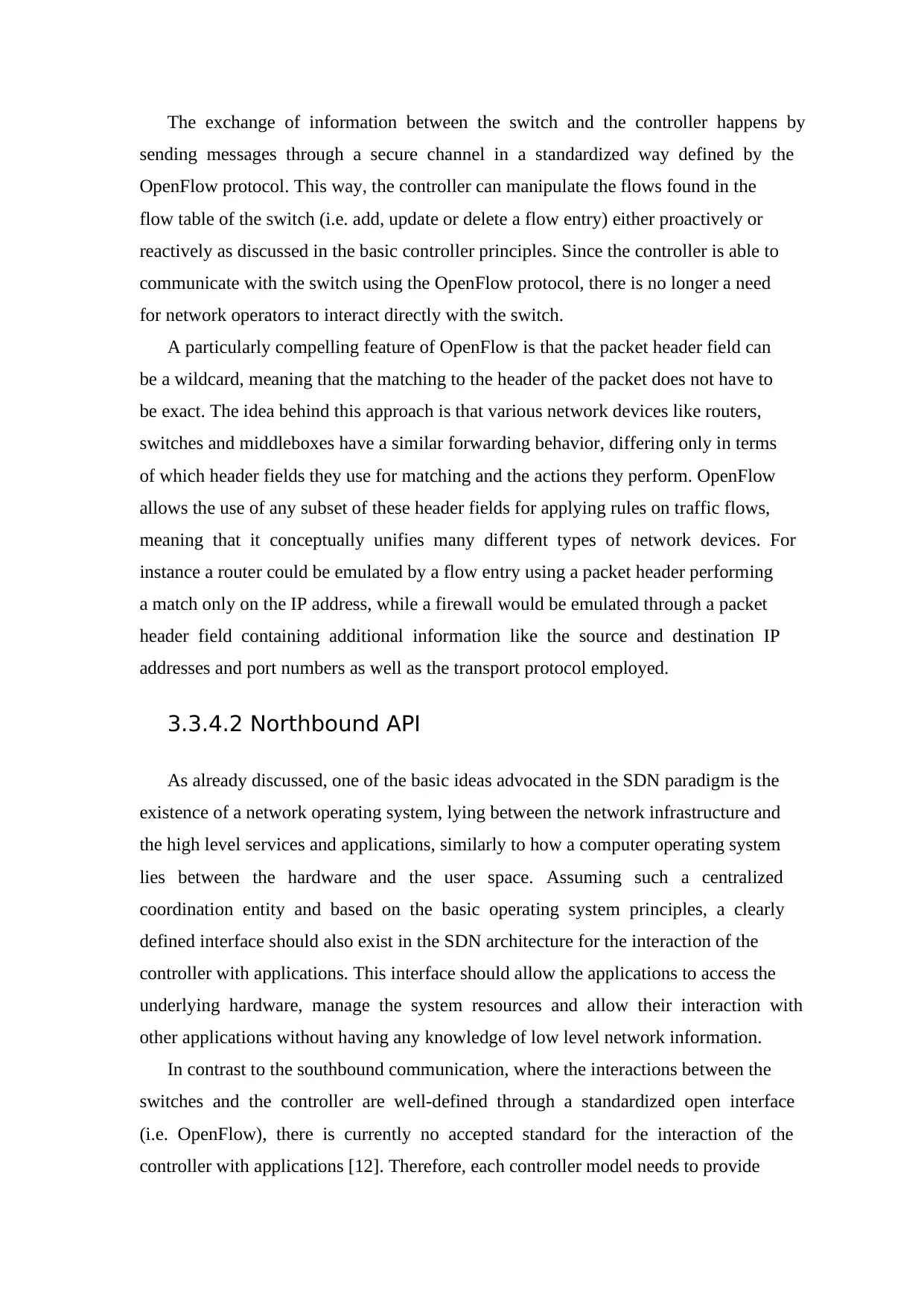
The exchange of information between the switch and the controller happens by
sending messages through a secure channel in a standardized way defined by the
OpenFlow protocol. This way, the controller can manipulate the flows found in the
flow table of the switch (i.e. add, update or delete a flow entry) either proactively or
reactively as discussed in the basic controller principles. Since the controller is able to
communicate with the switch using the OpenFlow protocol, there is no longer a need
for network operators to interact directly with the switch.
A particularly compelling feature of OpenFlow is that the packet header field can
be a wildcard, meaning that the matching to the header of the packet does not have to
be exact. The idea behind this approach is that various network devices like routers,
switches and middleboxes have a similar forwarding behavior, differing only in terms
of which header fields they use for matching and the actions they perform. OpenFlow
allows the use of any subset of these header fields for applying rules on traffic flows,
meaning that it conceptually unifies many different types of network devices. For
instance a router could be emulated by a flow entry using a packet header performing
a match only on the IP address, while a firewall would be emulated through a packet
header field containing additional information like the source and destination IP
addresses and port numbers as well as the transport protocol employed.
3.3.4.2 Northbound API
As already discussed, one of the basic ideas advocated in the SDN paradigm is the
existence of a network operating system, lying between the network infrastructure and
the high level services and applications, similarly to how a computer operating system
lies between the hardware and the user space. Assuming such a centralized
coordination entity and based on the basic operating system principles, a clearly
defined interface should also exist in the SDN architecture for the interaction of the
controller with applications. This interface should allow the applications to access the
underlying hardware, manage the system resources and allow their interaction with
other applications without having any knowledge of low level network information.
In contrast to the southbound communication, where the interactions between the
switches and the controller are well-defined through a standardized open interface
(i.e. OpenFlow), there is currently no accepted standard for the interaction of the
controller with applications [12]. Therefore, each controller model needs to provide
sending messages through a secure channel in a standardized way defined by the
OpenFlow protocol. This way, the controller can manipulate the flows found in the
flow table of the switch (i.e. add, update or delete a flow entry) either proactively or
reactively as discussed in the basic controller principles. Since the controller is able to
communicate with the switch using the OpenFlow protocol, there is no longer a need
for network operators to interact directly with the switch.
A particularly compelling feature of OpenFlow is that the packet header field can
be a wildcard, meaning that the matching to the header of the packet does not have to
be exact. The idea behind this approach is that various network devices like routers,
switches and middleboxes have a similar forwarding behavior, differing only in terms
of which header fields they use for matching and the actions they perform. OpenFlow
allows the use of any subset of these header fields for applying rules on traffic flows,
meaning that it conceptually unifies many different types of network devices. For
instance a router could be emulated by a flow entry using a packet header performing
a match only on the IP address, while a firewall would be emulated through a packet
header field containing additional information like the source and destination IP
addresses and port numbers as well as the transport protocol employed.
3.3.4.2 Northbound API
As already discussed, one of the basic ideas advocated in the SDN paradigm is the
existence of a network operating system, lying between the network infrastructure and
the high level services and applications, similarly to how a computer operating system
lies between the hardware and the user space. Assuming such a centralized
coordination entity and based on the basic operating system principles, a clearly
defined interface should also exist in the SDN architecture for the interaction of the
controller with applications. This interface should allow the applications to access the
underlying hardware, manage the system resources and allow their interaction with
other applications without having any knowledge of low level network information.
In contrast to the southbound communication, where the interactions between the
switches and the controller are well-defined through a standardized open interface
(i.e. OpenFlow), there is currently no accepted standard for the interaction of the
controller with applications [12]. Therefore, each controller model needs to provide
Secure Best Marks with AI Grader
Need help grading? Try our AI Grader for instant feedback on your assignments.
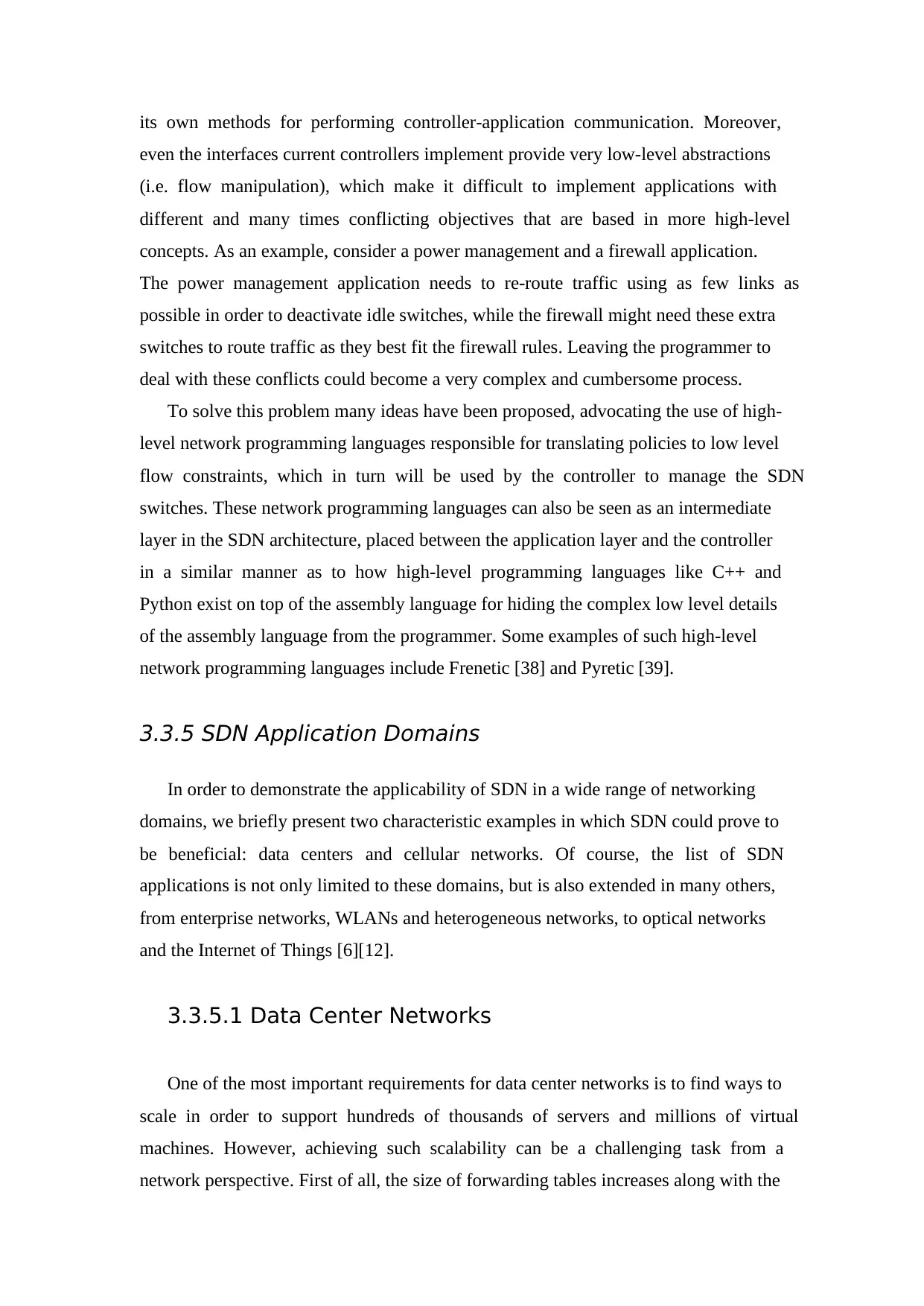
its own methods for performing controller-application communication. Moreover,
even the interfaces current controllers implement provide very low-level abstractions
(i.e. flow manipulation), which make it difficult to implement applications with
different and many times conflicting objectives that are based in more high-level
concepts. As an example, consider a power management and a firewall application.
The power management application needs to re-route traffic using as few links as
possible in order to deactivate idle switches, while the firewall might need these extra
switches to route traffic as they best fit the firewall rules. Leaving the programmer to
deal with these conflicts could become a very complex and cumbersome process.
To solve this problem many ideas have been proposed, advocating the use of high-
level network programming languages responsible for translating policies to low level
flow constraints, which in turn will be used by the controller to manage the SDN
switches. These network programming languages can also be seen as an intermediate
layer in the SDN architecture, placed between the application layer and the controller
in a similar manner as to how high-level programming languages like C++ and
Python exist on top of the assembly language for hiding the complex low level details
of the assembly language from the programmer. Some examples of such high-level
network programming languages include Frenetic [38] and Pyretic [39].
3.3.5 SDN Application Domains
In order to demonstrate the applicability of SDN in a wide range of networking
domains, we briefly present two characteristic examples in which SDN could prove to
be beneficial: data centers and cellular networks. Of course, the list of SDN
applications is not only limited to these domains, but is also extended in many others,
from enterprise networks, WLANs and heterogeneous networks, to optical networks
and the Internet of Things [6][12].
3.3.5.1 Data Center Networks
One of the most important requirements for data center networks is to find ways to
scale in order to support hundreds of thousands of servers and millions of virtual
machines. However, achieving such scalability can be a challenging task from a
network perspective. First of all, the size of forwarding tables increases along with the
even the interfaces current controllers implement provide very low-level abstractions
(i.e. flow manipulation), which make it difficult to implement applications with
different and many times conflicting objectives that are based in more high-level
concepts. As an example, consider a power management and a firewall application.
The power management application needs to re-route traffic using as few links as
possible in order to deactivate idle switches, while the firewall might need these extra
switches to route traffic as they best fit the firewall rules. Leaving the programmer to
deal with these conflicts could become a very complex and cumbersome process.
To solve this problem many ideas have been proposed, advocating the use of high-
level network programming languages responsible for translating policies to low level
flow constraints, which in turn will be used by the controller to manage the SDN
switches. These network programming languages can also be seen as an intermediate
layer in the SDN architecture, placed between the application layer and the controller
in a similar manner as to how high-level programming languages like C++ and
Python exist on top of the assembly language for hiding the complex low level details
of the assembly language from the programmer. Some examples of such high-level
network programming languages include Frenetic [38] and Pyretic [39].
3.3.5 SDN Application Domains
In order to demonstrate the applicability of SDN in a wide range of networking
domains, we briefly present two characteristic examples in which SDN could prove to
be beneficial: data centers and cellular networks. Of course, the list of SDN
applications is not only limited to these domains, but is also extended in many others,
from enterprise networks, WLANs and heterogeneous networks, to optical networks
and the Internet of Things [6][12].
3.3.5.1 Data Center Networks
One of the most important requirements for data center networks is to find ways to
scale in order to support hundreds of thousands of servers and millions of virtual
machines. However, achieving such scalability can be a challenging task from a
network perspective. First of all, the size of forwarding tables increases along with the
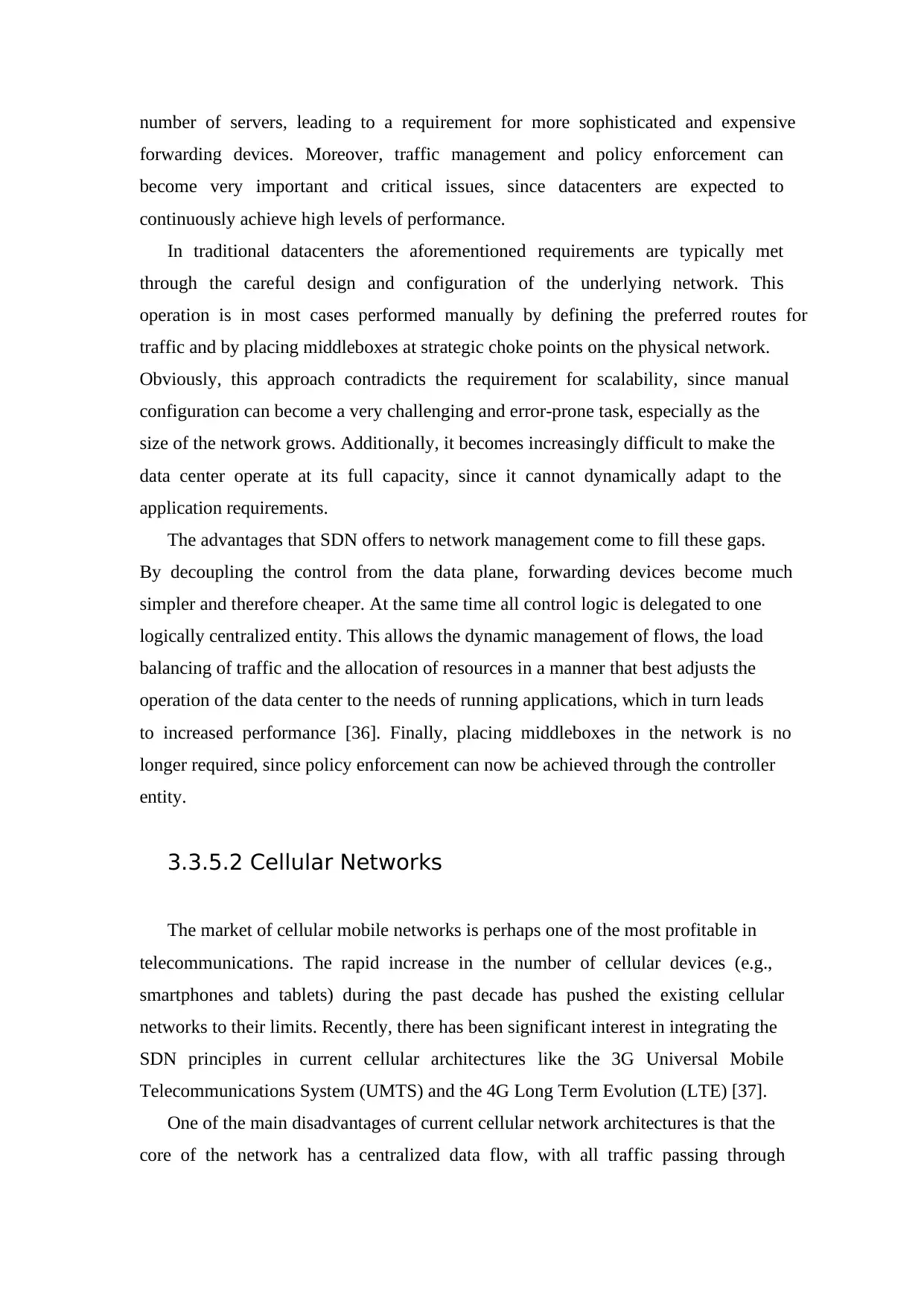
number of servers, leading to a requirement for more sophisticated and expensive
forwarding devices. Moreover, traffic management and policy enforcement can
become very important and critical issues, since datacenters are expected to
continuously achieve high levels of performance.
In traditional datacenters the aforementioned requirements are typically met
through the careful design and configuration of the underlying network. This
operation is in most cases performed manually by defining the preferred routes for
traffic and by placing middleboxes at strategic choke points on the physical network.
Obviously, this approach contradicts the requirement for scalability, since manual
configuration can become a very challenging and error-prone task, especially as the
size of the network grows. Additionally, it becomes increasingly difficult to make the
data center operate at its full capacity, since it cannot dynamically adapt to the
application requirements.
The advantages that SDN offers to network management come to fill these gaps.
By decoupling the control from the data plane, forwarding devices become much
simpler and therefore cheaper. At the same time all control logic is delegated to one
logically centralized entity. This allows the dynamic management of flows, the load
balancing of traffic and the allocation of resources in a manner that best adjusts the
operation of the data center to the needs of running applications, which in turn leads
to increased performance [36]. Finally, placing middleboxes in the network is no
longer required, since policy enforcement can now be achieved through the controller
entity.
3.3.5.2 Cellular Networks
The market of cellular mobile networks is perhaps one of the most profitable in
telecommunications. The rapid increase in the number of cellular devices (e.g.,
smartphones and tablets) during the past decade has pushed the existing cellular
networks to their limits. Recently, there has been significant interest in integrating the
SDN principles in current cellular architectures like the 3G Universal Mobile
Telecommunications System (UMTS) and the 4G Long Term Evolution (LTE) [37].
One of the main disadvantages of current cellular network architectures is that the
core of the network has a centralized data flow, with all traffic passing through
forwarding devices. Moreover, traffic management and policy enforcement can
become very important and critical issues, since datacenters are expected to
continuously achieve high levels of performance.
In traditional datacenters the aforementioned requirements are typically met
through the careful design and configuration of the underlying network. This
operation is in most cases performed manually by defining the preferred routes for
traffic and by placing middleboxes at strategic choke points on the physical network.
Obviously, this approach contradicts the requirement for scalability, since manual
configuration can become a very challenging and error-prone task, especially as the
size of the network grows. Additionally, it becomes increasingly difficult to make the
data center operate at its full capacity, since it cannot dynamically adapt to the
application requirements.
The advantages that SDN offers to network management come to fill these gaps.
By decoupling the control from the data plane, forwarding devices become much
simpler and therefore cheaper. At the same time all control logic is delegated to one
logically centralized entity. This allows the dynamic management of flows, the load
balancing of traffic and the allocation of resources in a manner that best adjusts the
operation of the data center to the needs of running applications, which in turn leads
to increased performance [36]. Finally, placing middleboxes in the network is no
longer required, since policy enforcement can now be achieved through the controller
entity.
3.3.5.2 Cellular Networks
The market of cellular mobile networks is perhaps one of the most profitable in
telecommunications. The rapid increase in the number of cellular devices (e.g.,
smartphones and tablets) during the past decade has pushed the existing cellular
networks to their limits. Recently, there has been significant interest in integrating the
SDN principles in current cellular architectures like the 3G Universal Mobile
Telecommunications System (UMTS) and the 4G Long Term Evolution (LTE) [37].
One of the main disadvantages of current cellular network architectures is that the
core of the network has a centralized data flow, with all traffic passing through
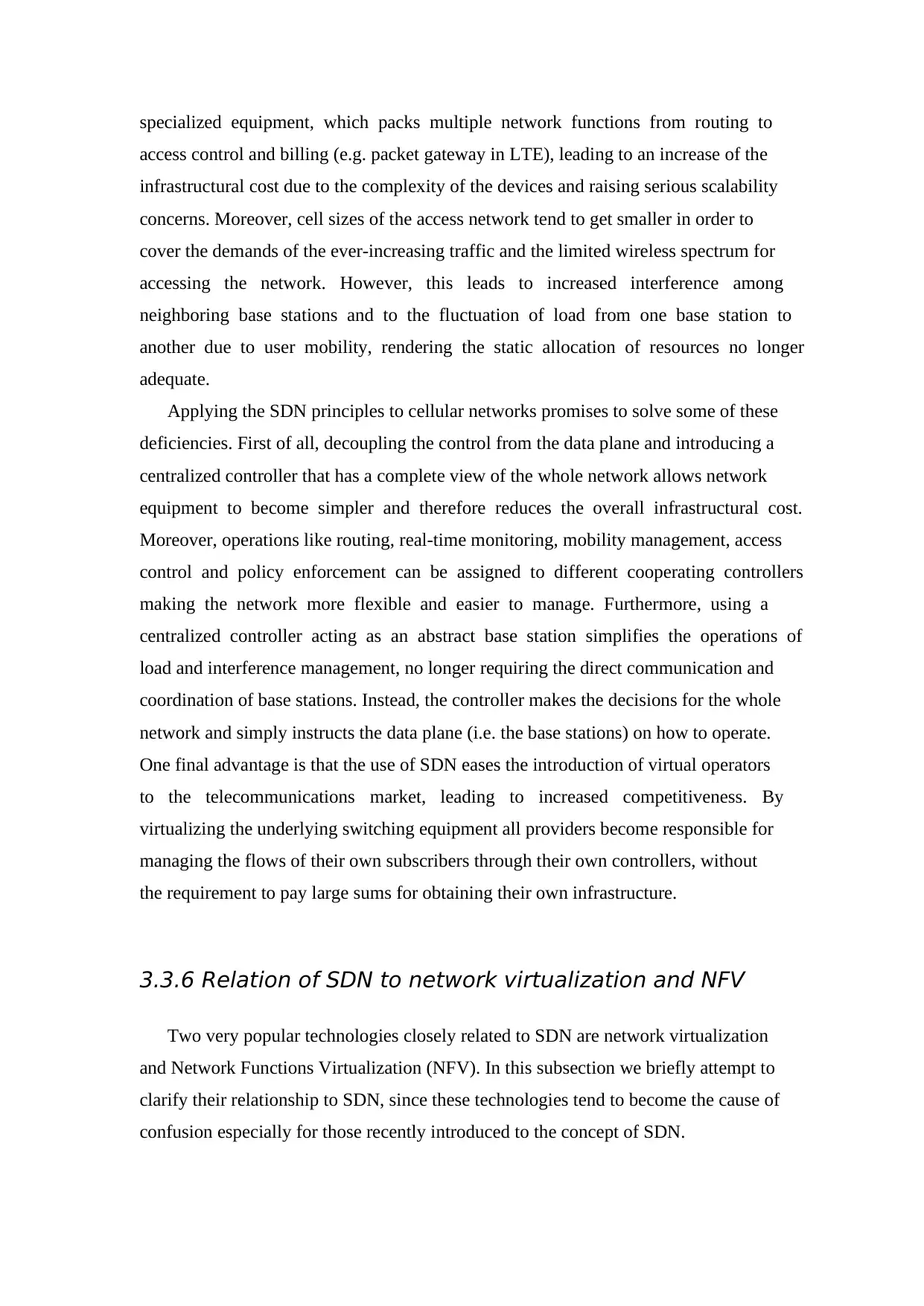
specialized equipment, which packs multiple network functions from routing to
access control and billing (e.g. packet gateway in LTE), leading to an increase of the
infrastructural cost due to the complexity of the devices and raising serious scalability
concerns. Moreover, cell sizes of the access network tend to get smaller in order to
cover the demands of the ever-increasing traffic and the limited wireless spectrum for
accessing the network. However, this leads to increased interference among
neighboring base stations and to the fluctuation of load from one base station to
another due to user mobility, rendering the static allocation of resources no longer
adequate.
Applying the SDN principles to cellular networks promises to solve some of these
deficiencies. First of all, decoupling the control from the data plane and introducing a
centralized controller that has a complete view of the whole network allows network
equipment to become simpler and therefore reduces the overall infrastructural cost.
Moreover, operations like routing, real-time monitoring, mobility management, access
control and policy enforcement can be assigned to different cooperating controllers
making the network more flexible and easier to manage. Furthermore, using a
centralized controller acting as an abstract base station simplifies the operations of
load and interference management, no longer requiring the direct communication and
coordination of base stations. Instead, the controller makes the decisions for the whole
network and simply instructs the data plane (i.e. the base stations) on how to operate.
One final advantage is that the use of SDN eases the introduction of virtual operators
to the telecommunications market, leading to increased competitiveness. By
virtualizing the underlying switching equipment all providers become responsible for
managing the flows of their own subscribers through their own controllers, without
the requirement to pay large sums for obtaining their own infrastructure.
3.3.6 Relation of SDN to network virtualization and NFV
Two very popular technologies closely related to SDN are network virtualization
and Network Functions Virtualization (NFV). In this subsection we briefly attempt to
clarify their relationship to SDN, since these technologies tend to become the cause of
confusion especially for those recently introduced to the concept of SDN.
access control and billing (e.g. packet gateway in LTE), leading to an increase of the
infrastructural cost due to the complexity of the devices and raising serious scalability
concerns. Moreover, cell sizes of the access network tend to get smaller in order to
cover the demands of the ever-increasing traffic and the limited wireless spectrum for
accessing the network. However, this leads to increased interference among
neighboring base stations and to the fluctuation of load from one base station to
another due to user mobility, rendering the static allocation of resources no longer
adequate.
Applying the SDN principles to cellular networks promises to solve some of these
deficiencies. First of all, decoupling the control from the data plane and introducing a
centralized controller that has a complete view of the whole network allows network
equipment to become simpler and therefore reduces the overall infrastructural cost.
Moreover, operations like routing, real-time monitoring, mobility management, access
control and policy enforcement can be assigned to different cooperating controllers
making the network more flexible and easier to manage. Furthermore, using a
centralized controller acting as an abstract base station simplifies the operations of
load and interference management, no longer requiring the direct communication and
coordination of base stations. Instead, the controller makes the decisions for the whole
network and simply instructs the data plane (i.e. the base stations) on how to operate.
One final advantage is that the use of SDN eases the introduction of virtual operators
to the telecommunications market, leading to increased competitiveness. By
virtualizing the underlying switching equipment all providers become responsible for
managing the flows of their own subscribers through their own controllers, without
the requirement to pay large sums for obtaining their own infrastructure.
3.3.6 Relation of SDN to network virtualization and NFV
Two very popular technologies closely related to SDN are network virtualization
and Network Functions Virtualization (NFV). In this subsection we briefly attempt to
clarify their relationship to SDN, since these technologies tend to become the cause of
confusion especially for those recently introduced to the concept of SDN.
Paraphrase This Document
Need a fresh take? Get an instant paraphrase of this document with our AI Paraphraser
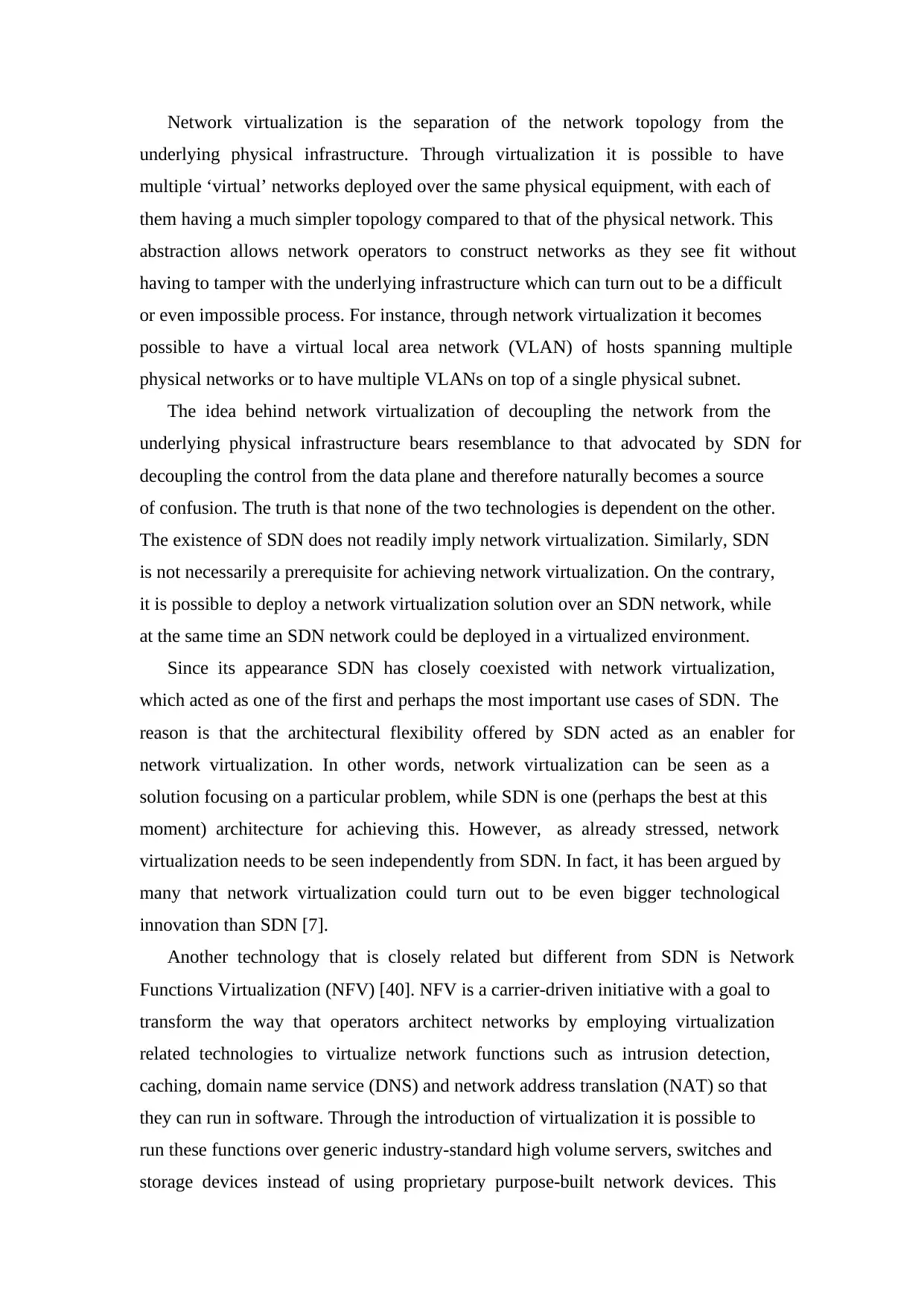
Network virtualization is the separation of the network topology from the
underlying physical infrastructure. Through virtualization it is possible to have
multiple ‘virtual’ networks deployed over the same physical equipment, with each of
them having a much simpler topology compared to that of the physical network. This
abstraction allows network operators to construct networks as they see fit without
having to tamper with the underlying infrastructure which can turn out to be a difficult
or even impossible process. For instance, through network virtualization it becomes
possible to have a virtual local area network (VLAN) of hosts spanning multiple
physical networks or to have multiple VLANs on top of a single physical subnet.
The idea behind network virtualization of decoupling the network from the
underlying physical infrastructure bears resemblance to that advocated by SDN for
decoupling the control from the data plane and therefore naturally becomes a source
of confusion. The truth is that none of the two technologies is dependent on the other.
The existence of SDN does not readily imply network virtualization. Similarly, SDN
is not necessarily a prerequisite for achieving network virtualization. On the contrary,
it is possible to deploy a network virtualization solution over an SDN network, while
at the same time an SDN network could be deployed in a virtualized environment.
Since its appearance SDN has closely coexisted with network virtualization,
which acted as one of the first and perhaps the most important use cases of SDN. The
reason is that the architectural flexibility offered by SDN acted as an enabler for
network virtualization. In other words, network virtualization can be seen as a
solution focusing on a particular problem, while SDN is one (perhaps the best at this
moment) architecture for achieving this. However, as already stressed, network
virtualization needs to be seen independently from SDN. In fact, it has been argued by
many that network virtualization could turn out to be even bigger technological
innovation than SDN [7].
Another technology that is closely related but different from SDN is Network
Functions Virtualization (NFV) [40]. NFV is a carrier-driven initiative with a goal to
transform the way that operators architect networks by employing virtualization
related technologies to virtualize network functions such as intrusion detection,
caching, domain name service (DNS) and network address translation (NAT) so that
they can run in software. Through the introduction of virtualization it is possible to
run these functions over generic industry-standard high volume servers, switches and
storage devices instead of using proprietary purpose-built network devices. This
underlying physical infrastructure. Through virtualization it is possible to have
multiple ‘virtual’ networks deployed over the same physical equipment, with each of
them having a much simpler topology compared to that of the physical network. This
abstraction allows network operators to construct networks as they see fit without
having to tamper with the underlying infrastructure which can turn out to be a difficult
or even impossible process. For instance, through network virtualization it becomes
possible to have a virtual local area network (VLAN) of hosts spanning multiple
physical networks or to have multiple VLANs on top of a single physical subnet.
The idea behind network virtualization of decoupling the network from the
underlying physical infrastructure bears resemblance to that advocated by SDN for
decoupling the control from the data plane and therefore naturally becomes a source
of confusion. The truth is that none of the two technologies is dependent on the other.
The existence of SDN does not readily imply network virtualization. Similarly, SDN
is not necessarily a prerequisite for achieving network virtualization. On the contrary,
it is possible to deploy a network virtualization solution over an SDN network, while
at the same time an SDN network could be deployed in a virtualized environment.
Since its appearance SDN has closely coexisted with network virtualization,
which acted as one of the first and perhaps the most important use cases of SDN. The
reason is that the architectural flexibility offered by SDN acted as an enabler for
network virtualization. In other words, network virtualization can be seen as a
solution focusing on a particular problem, while SDN is one (perhaps the best at this
moment) architecture for achieving this. However, as already stressed, network
virtualization needs to be seen independently from SDN. In fact, it has been argued by
many that network virtualization could turn out to be even bigger technological
innovation than SDN [7].
Another technology that is closely related but different from SDN is Network
Functions Virtualization (NFV) [40]. NFV is a carrier-driven initiative with a goal to
transform the way that operators architect networks by employing virtualization
related technologies to virtualize network functions such as intrusion detection,
caching, domain name service (DNS) and network address translation (NAT) so that
they can run in software. Through the introduction of virtualization it is possible to
run these functions over generic industry-standard high volume servers, switches and
storage devices instead of using proprietary purpose-built network devices. This
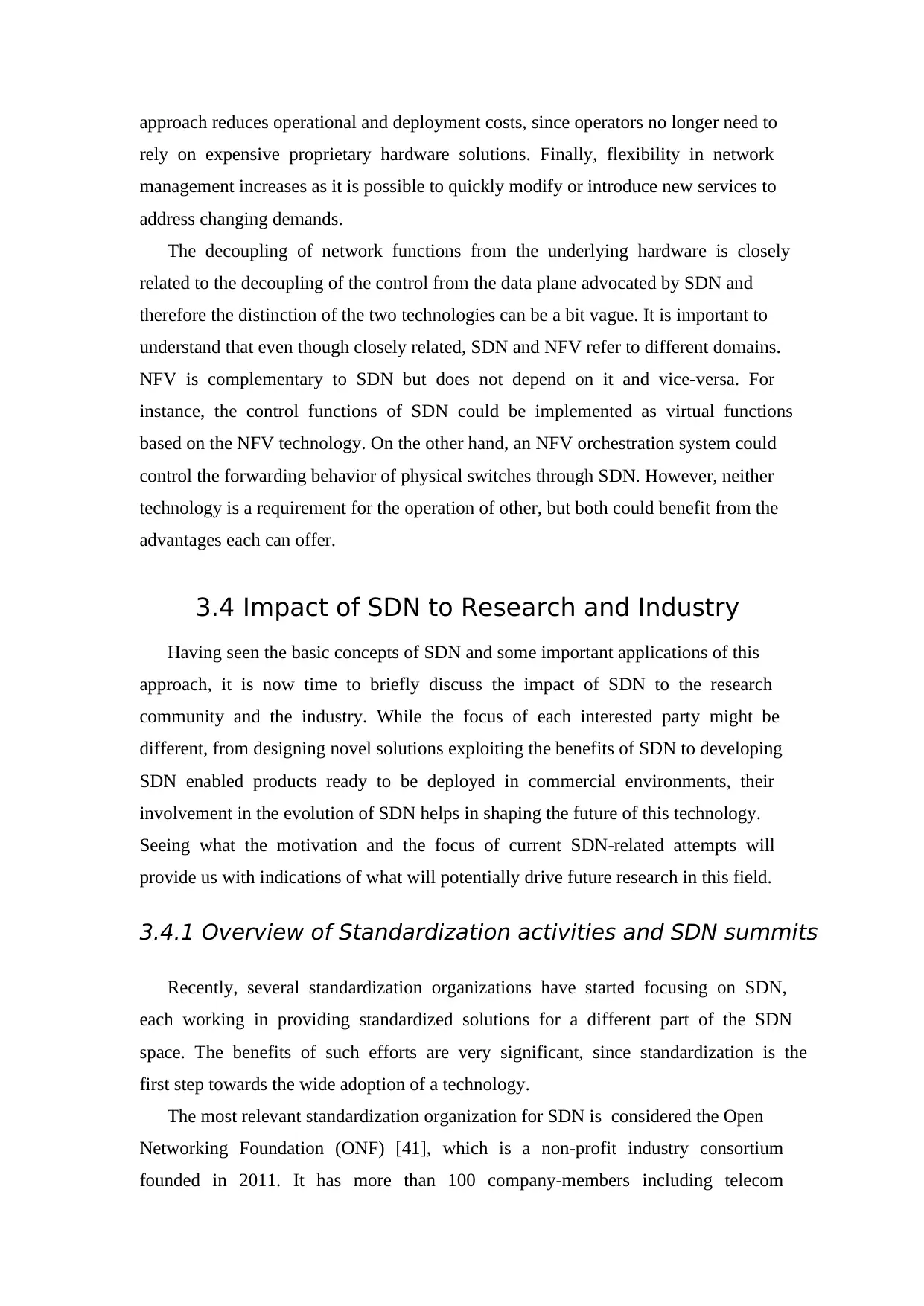
approach reduces operational and deployment costs, since operators no longer need to
rely on expensive proprietary hardware solutions. Finally, flexibility in network
management increases as it is possible to quickly modify or introduce new services to
address changing demands.
The decoupling of network functions from the underlying hardware is closely
related to the decoupling of the control from the data plane advocated by SDN and
therefore the distinction of the two technologies can be a bit vague. It is important to
understand that even though closely related, SDN and NFV refer to different domains.
NFV is complementary to SDN but does not depend on it and vice-versa. For
instance, the control functions of SDN could be implemented as virtual functions
based on the NFV technology. On the other hand, an NFV orchestration system could
control the forwarding behavior of physical switches through SDN. However, neither
technology is a requirement for the operation of other, but both could benefit from the
advantages each can offer.
3.4 Impact of SDN to Research and Industry
Having seen the basic concepts of SDN and some important applications of this
approach, it is now time to briefly discuss the impact of SDN to the research
community and the industry. While the focus of each interested party might be
different, from designing novel solutions exploiting the benefits of SDN to developing
SDN enabled products ready to be deployed in commercial environments, their
involvement in the evolution of SDN helps in shaping the future of this technology.
Seeing what the motivation and the focus of current SDN-related attempts will
provide us with indications of what will potentially drive future research in this field.
3.4.1 Overview of Standardization activities and SDN summits
Recently, several standardization organizations have started focusing on SDN,
each working in providing standardized solutions for a different part of the SDN
space. The benefits of such efforts are very significant, since standardization is the
first step towards the wide adoption of a technology.
The most relevant standardization organization for SDN is considered the Open
Networking Foundation (ONF) [41], which is a non-profit industry consortium
founded in 2011. It has more than 100 company-members including telecom
rely on expensive proprietary hardware solutions. Finally, flexibility in network
management increases as it is possible to quickly modify or introduce new services to
address changing demands.
The decoupling of network functions from the underlying hardware is closely
related to the decoupling of the control from the data plane advocated by SDN and
therefore the distinction of the two technologies can be a bit vague. It is important to
understand that even though closely related, SDN and NFV refer to different domains.
NFV is complementary to SDN but does not depend on it and vice-versa. For
instance, the control functions of SDN could be implemented as virtual functions
based on the NFV technology. On the other hand, an NFV orchestration system could
control the forwarding behavior of physical switches through SDN. However, neither
technology is a requirement for the operation of other, but both could benefit from the
advantages each can offer.
3.4 Impact of SDN to Research and Industry
Having seen the basic concepts of SDN and some important applications of this
approach, it is now time to briefly discuss the impact of SDN to the research
community and the industry. While the focus of each interested party might be
different, from designing novel solutions exploiting the benefits of SDN to developing
SDN enabled products ready to be deployed in commercial environments, their
involvement in the evolution of SDN helps in shaping the future of this technology.
Seeing what the motivation and the focus of current SDN-related attempts will
provide us with indications of what will potentially drive future research in this field.
3.4.1 Overview of Standardization activities and SDN summits
Recently, several standardization organizations have started focusing on SDN,
each working in providing standardized solutions for a different part of the SDN
space. The benefits of such efforts are very significant, since standardization is the
first step towards the wide adoption of a technology.
The most relevant standardization organization for SDN is considered the Open
Networking Foundation (ONF) [41], which is a non-profit industry consortium
founded in 2011. It has more than 100 company-members including telecom
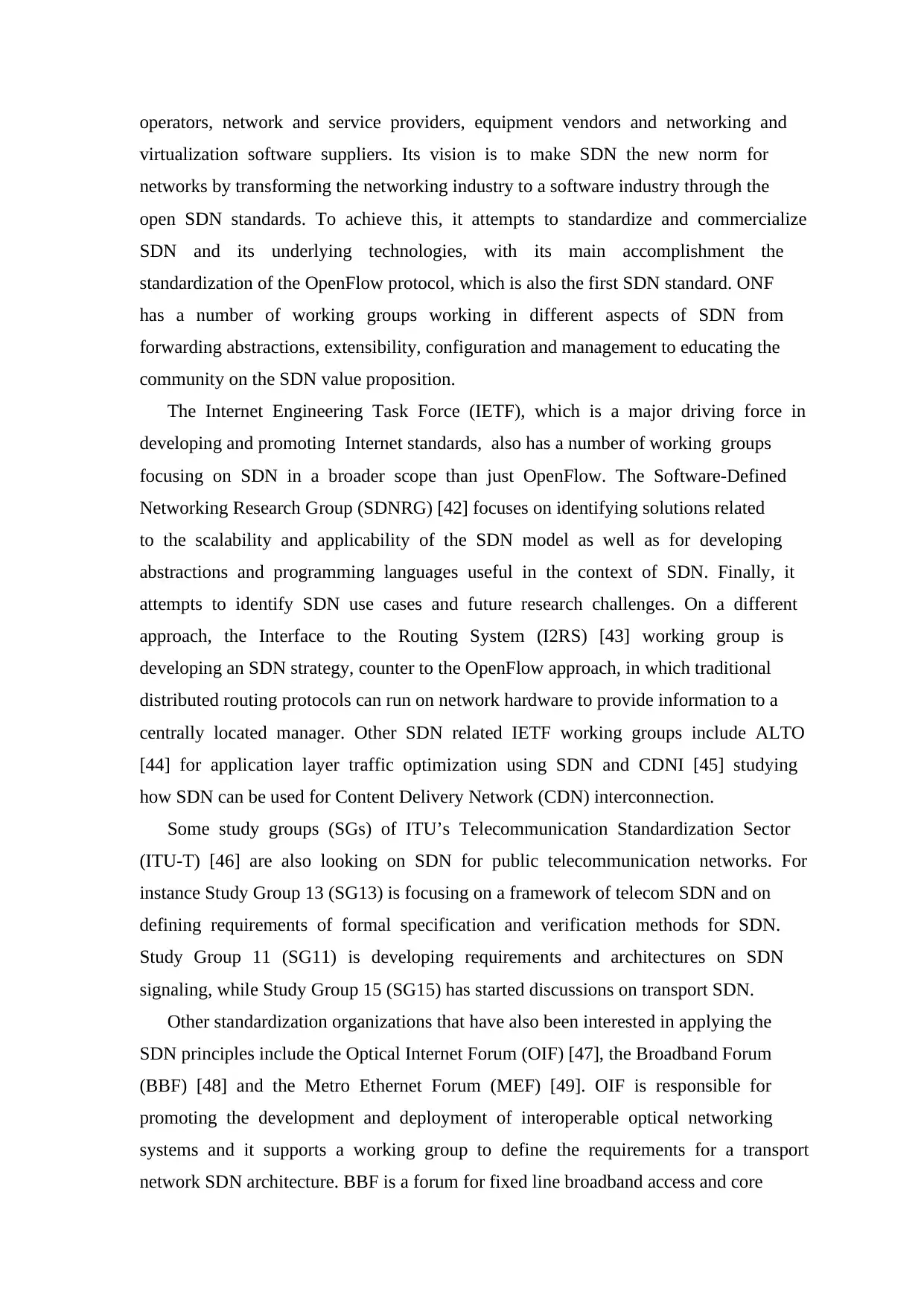
operators, network and service providers, equipment vendors and networking and
virtualization software suppliers. Its vision is to make SDN the new norm for
networks by transforming the networking industry to a software industry through the
open SDN standards. To achieve this, it attempts to standardize and commercialize
SDN and its underlying technologies, with its main accomplishment the
standardization of the OpenFlow protocol, which is also the first SDN standard. ONF
has a number of working groups working in different aspects of SDN from
forwarding abstractions, extensibility, configuration and management to educating the
community on the SDN value proposition.
The Internet Engineering Task Force (IETF), which is a major driving force in
developing and promoting Internet standards, also has a number of working groups
focusing on SDN in a broader scope than just OpenFlow. The Software-Defined
Networking Research Group (SDNRG) [42] focuses on identifying solutions related
to the scalability and applicability of the SDN model as well as for developing
abstractions and programming languages useful in the context of SDN. Finally, it
attempts to identify SDN use cases and future research challenges. On a different
approach, the Interface to the Routing System (I2RS) [43] working group is
developing an SDN strategy, counter to the OpenFlow approach, in which traditional
distributed routing protocols can run on network hardware to provide information to a
centrally located manager. Other SDN related IETF working groups include ALTO
[44] for application layer traffic optimization using SDN and CDNI [45] studying
how SDN can be used for Content Delivery Network (CDN) interconnection.
Some study groups (SGs) of ITU’s Telecommunication Standardization Sector
(ITU-T) [46] are also looking on SDN for public telecommunication networks. For
instance Study Group 13 (SG13) is focusing on a framework of telecom SDN and on
defining requirements of formal specification and verification methods for SDN.
Study Group 11 (SG11) is developing requirements and architectures on SDN
signaling, while Study Group 15 (SG15) has started discussions on transport SDN.
Other standardization organizations that have also been interested in applying the
SDN principles include the Optical Internet Forum (OIF) [47], the Broadband Forum
(BBF) [48] and the Metro Ethernet Forum (MEF) [49]. OIF is responsible for
promoting the development and deployment of interoperable optical networking
systems and it supports a working group to define the requirements for a transport
network SDN architecture. BBF is a forum for fixed line broadband access and core
virtualization software suppliers. Its vision is to make SDN the new norm for
networks by transforming the networking industry to a software industry through the
open SDN standards. To achieve this, it attempts to standardize and commercialize
SDN and its underlying technologies, with its main accomplishment the
standardization of the OpenFlow protocol, which is also the first SDN standard. ONF
has a number of working groups working in different aspects of SDN from
forwarding abstractions, extensibility, configuration and management to educating the
community on the SDN value proposition.
The Internet Engineering Task Force (IETF), which is a major driving force in
developing and promoting Internet standards, also has a number of working groups
focusing on SDN in a broader scope than just OpenFlow. The Software-Defined
Networking Research Group (SDNRG) [42] focuses on identifying solutions related
to the scalability and applicability of the SDN model as well as for developing
abstractions and programming languages useful in the context of SDN. Finally, it
attempts to identify SDN use cases and future research challenges. On a different
approach, the Interface to the Routing System (I2RS) [43] working group is
developing an SDN strategy, counter to the OpenFlow approach, in which traditional
distributed routing protocols can run on network hardware to provide information to a
centrally located manager. Other SDN related IETF working groups include ALTO
[44] for application layer traffic optimization using SDN and CDNI [45] studying
how SDN can be used for Content Delivery Network (CDN) interconnection.
Some study groups (SGs) of ITU’s Telecommunication Standardization Sector
(ITU-T) [46] are also looking on SDN for public telecommunication networks. For
instance Study Group 13 (SG13) is focusing on a framework of telecom SDN and on
defining requirements of formal specification and verification methods for SDN.
Study Group 11 (SG11) is developing requirements and architectures on SDN
signaling, while Study Group 15 (SG15) has started discussions on transport SDN.
Other standardization organizations that have also been interested in applying the
SDN principles include the Optical Internet Forum (OIF) [47], the Broadband Forum
(BBF) [48] and the Metro Ethernet Forum (MEF) [49]. OIF is responsible for
promoting the development and deployment of interoperable optical networking
systems and it supports a working group to define the requirements for a transport
network SDN architecture. BBF is a forum for fixed line broadband access and core
Secure Best Marks with AI Grader
Need help grading? Try our AI Grader for instant feedback on your assignments.
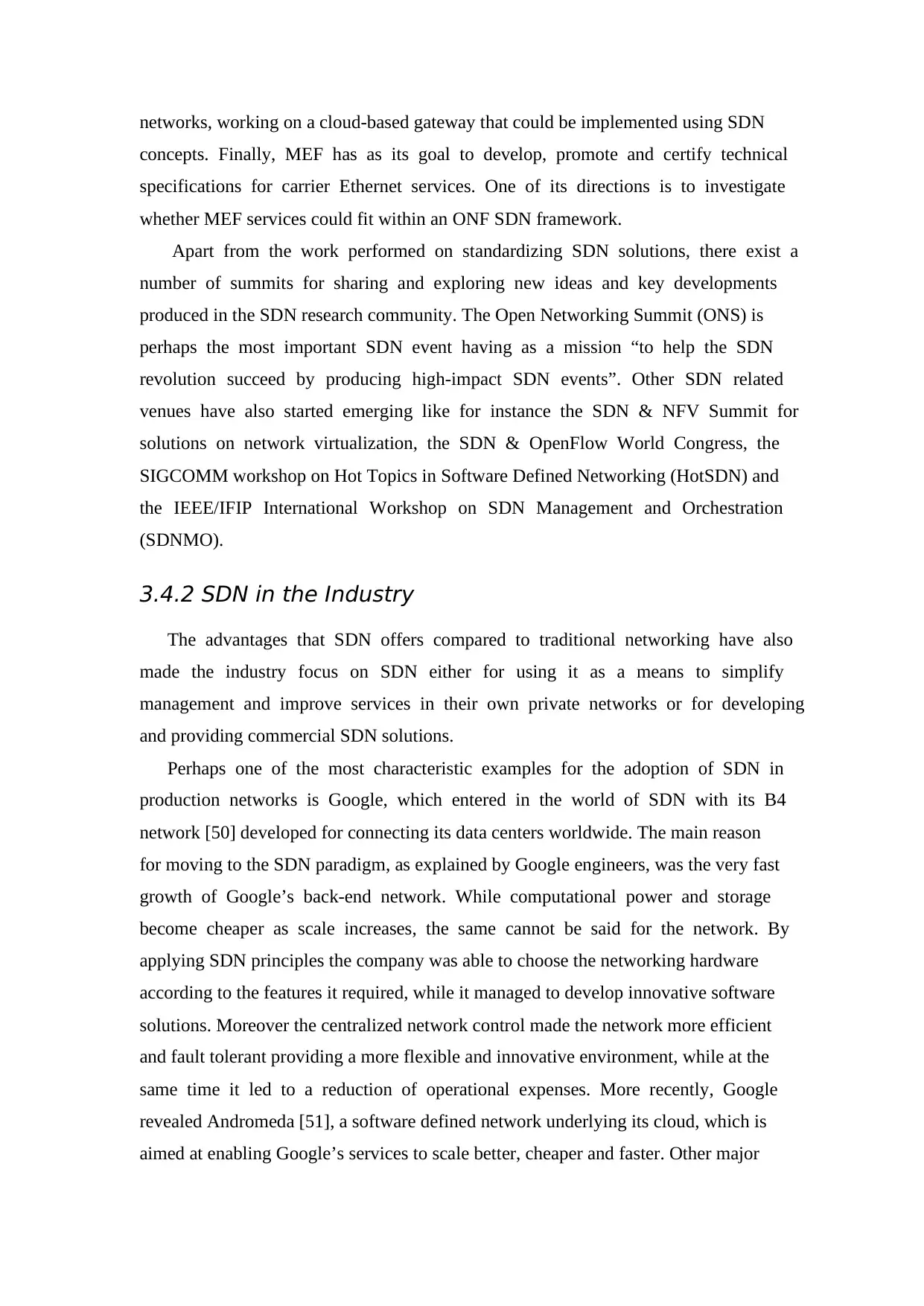
networks, working on a cloud-based gateway that could be implemented using SDN
concepts. Finally, MEF has as its goal to develop, promote and certify technical
specifications for carrier Ethernet services. One of its directions is to investigate
whether MEF services could fit within an ONF SDN framework.
Apart from the work performed on standardizing SDN solutions, there exist a
number of summits for sharing and exploring new ideas and key developments
produced in the SDN research community. The Open Networking Summit (ONS) is
perhaps the most important SDN event having as a mission “to help the SDN
revolution succeed by producing high-impact SDN events”. Other SDN related
venues have also started emerging like for instance the SDN & NFV Summit for
solutions on network virtualization, the SDN & OpenFlow World Congress, the
SIGCOMM workshop on Hot Topics in Software Defined Networking (HotSDN) and
the IEEE/IFIP International Workshop on SDN Management and Orchestration
(SDNMO).
3.4.2 SDN in the Industry
The advantages that SDN offers compared to traditional networking have also
made the industry focus on SDN either for using it as a means to simplify
management and improve services in their own private networks or for developing
and providing commercial SDN solutions.
Perhaps one of the most characteristic examples for the adoption of SDN in
production networks is Google, which entered in the world of SDN with its B4
network [50] developed for connecting its data centers worldwide. The main reason
for moving to the SDN paradigm, as explained by Google engineers, was the very fast
growth of Google’s back-end network. While computational power and storage
become cheaper as scale increases, the same cannot be said for the network. By
applying SDN principles the company was able to choose the networking hardware
according to the features it required, while it managed to develop innovative software
solutions. Moreover the centralized network control made the network more efficient
and fault tolerant providing a more flexible and innovative environment, while at the
same time it led to a reduction of operational expenses. More recently, Google
revealed Andromeda [51], a software defined network underlying its cloud, which is
aimed at enabling Google’s services to scale better, cheaper and faster. Other major
concepts. Finally, MEF has as its goal to develop, promote and certify technical
specifications for carrier Ethernet services. One of its directions is to investigate
whether MEF services could fit within an ONF SDN framework.
Apart from the work performed on standardizing SDN solutions, there exist a
number of summits for sharing and exploring new ideas and key developments
produced in the SDN research community. The Open Networking Summit (ONS) is
perhaps the most important SDN event having as a mission “to help the SDN
revolution succeed by producing high-impact SDN events”. Other SDN related
venues have also started emerging like for instance the SDN & NFV Summit for
solutions on network virtualization, the SDN & OpenFlow World Congress, the
SIGCOMM workshop on Hot Topics in Software Defined Networking (HotSDN) and
the IEEE/IFIP International Workshop on SDN Management and Orchestration
(SDNMO).
3.4.2 SDN in the Industry
The advantages that SDN offers compared to traditional networking have also
made the industry focus on SDN either for using it as a means to simplify
management and improve services in their own private networks or for developing
and providing commercial SDN solutions.
Perhaps one of the most characteristic examples for the adoption of SDN in
production networks is Google, which entered in the world of SDN with its B4
network [50] developed for connecting its data centers worldwide. The main reason
for moving to the SDN paradigm, as explained by Google engineers, was the very fast
growth of Google’s back-end network. While computational power and storage
become cheaper as scale increases, the same cannot be said for the network. By
applying SDN principles the company was able to choose the networking hardware
according to the features it required, while it managed to develop innovative software
solutions. Moreover the centralized network control made the network more efficient
and fault tolerant providing a more flexible and innovative environment, while at the
same time it led to a reduction of operational expenses. More recently, Google
revealed Andromeda [51], a software defined network underlying its cloud, which is
aimed at enabling Google’s services to scale better, cheaper and faster. Other major
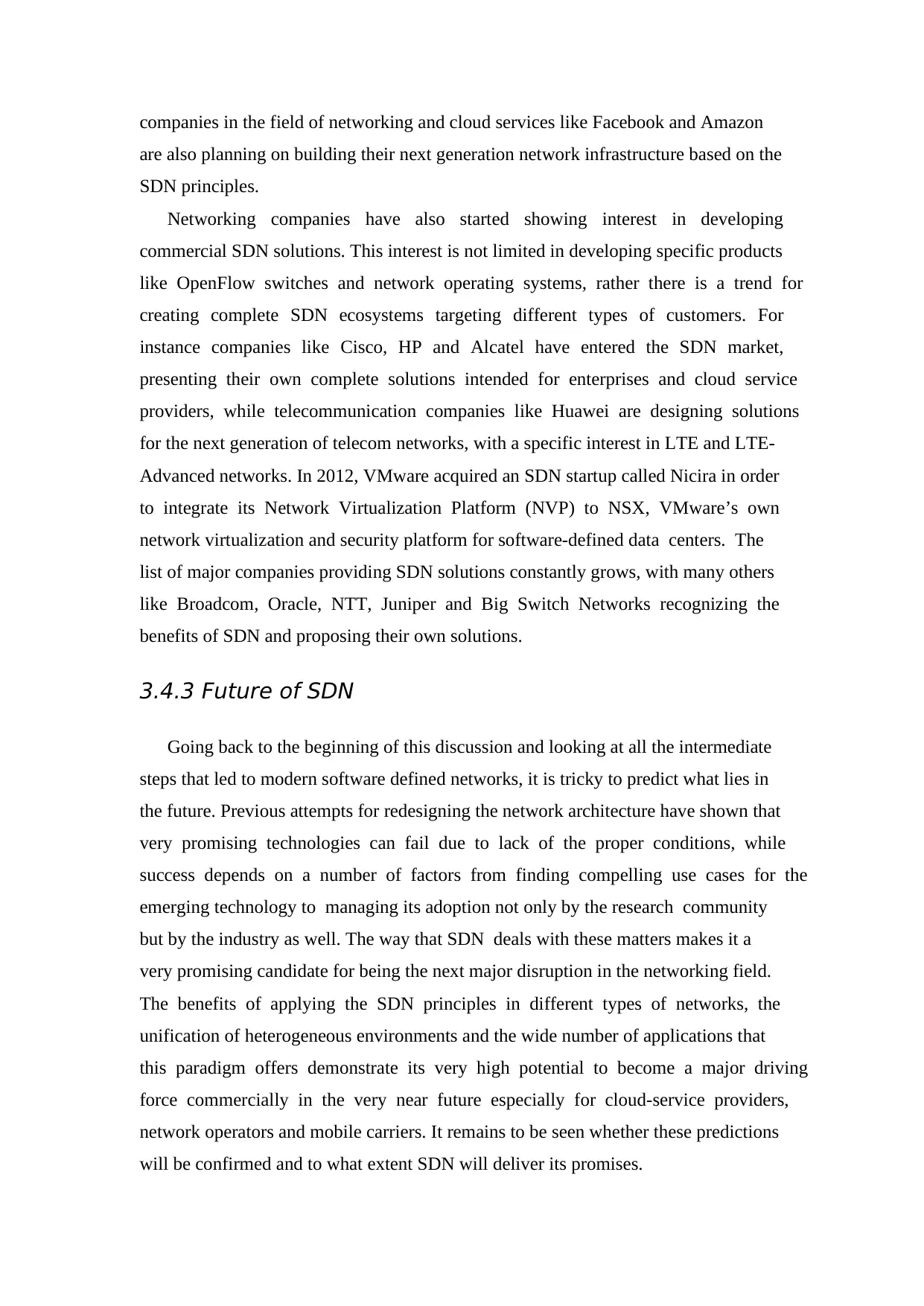
companies in the field of networking and cloud services like Facebook and Amazon
are also planning on building their next generation network infrastructure based on the
SDN principles.
Networking companies have also started showing interest in developing
commercial SDN solutions. This interest is not limited in developing specific products
like OpenFlow switches and network operating systems, rather there is a trend for
creating complete SDN ecosystems targeting different types of customers. For
instance companies like Cisco, HP and Alcatel have entered the SDN market,
presenting their own complete solutions intended for enterprises and cloud service
providers, while telecommunication companies like Huawei are designing solutions
for the next generation of telecom networks, with a specific interest in LTE and LTE-
Advanced networks. In 2012, VMware acquired an SDN startup called Nicira in order
to integrate its Network Virtualization Platform (NVP) to NSX, VMware’s own
network virtualization and security platform for software-defined data centers. The
list of major companies providing SDN solutions constantly grows, with many others
like Broadcom, Oracle, NTT, Juniper and Big Switch Networks recognizing the
benefits of SDN and proposing their own solutions.
3.4.3 Future of SDN
Going back to the beginning of this discussion and looking at all the intermediate
steps that led to modern software defined networks, it is tricky to predict what lies in
the future. Previous attempts for redesigning the network architecture have shown that
very promising technologies can fail due to lack of the proper conditions, while
success depends on a number of factors from finding compelling use cases for the
emerging technology to managing its adoption not only by the research community
but by the industry as well. The way that SDN deals with these matters makes it a
very promising candidate for being the next major disruption in the networking field.
The benefits of applying the SDN principles in different types of networks, the
unification of heterogeneous environments and the wide number of applications that
this paradigm offers demonstrate its very high potential to become a major driving
force commercially in the very near future especially for cloud-service providers,
network operators and mobile carriers. It remains to be seen whether these predictions
will be confirmed and to what extent SDN will deliver its promises.
are also planning on building their next generation network infrastructure based on the
SDN principles.
Networking companies have also started showing interest in developing
commercial SDN solutions. This interest is not limited in developing specific products
like OpenFlow switches and network operating systems, rather there is a trend for
creating complete SDN ecosystems targeting different types of customers. For
instance companies like Cisco, HP and Alcatel have entered the SDN market,
presenting their own complete solutions intended for enterprises and cloud service
providers, while telecommunication companies like Huawei are designing solutions
for the next generation of telecom networks, with a specific interest in LTE and LTE-
Advanced networks. In 2012, VMware acquired an SDN startup called Nicira in order
to integrate its Network Virtualization Platform (NVP) to NSX, VMware’s own
network virtualization and security platform for software-defined data centers. The
list of major companies providing SDN solutions constantly grows, with many others
like Broadcom, Oracle, NTT, Juniper and Big Switch Networks recognizing the
benefits of SDN and proposing their own solutions.
3.4.3 Future of SDN
Going back to the beginning of this discussion and looking at all the intermediate
steps that led to modern software defined networks, it is tricky to predict what lies in
the future. Previous attempts for redesigning the network architecture have shown that
very promising technologies can fail due to lack of the proper conditions, while
success depends on a number of factors from finding compelling use cases for the
emerging technology to managing its adoption not only by the research community
but by the industry as well. The way that SDN deals with these matters makes it a
very promising candidate for being the next major disruption in the networking field.
The benefits of applying the SDN principles in different types of networks, the
unification of heterogeneous environments and the wide number of applications that
this paradigm offers demonstrate its very high potential to become a major driving
force commercially in the very near future especially for cloud-service providers,
network operators and mobile carriers. It remains to be seen whether these predictions
will be confirmed and to what extent SDN will deliver its promises.
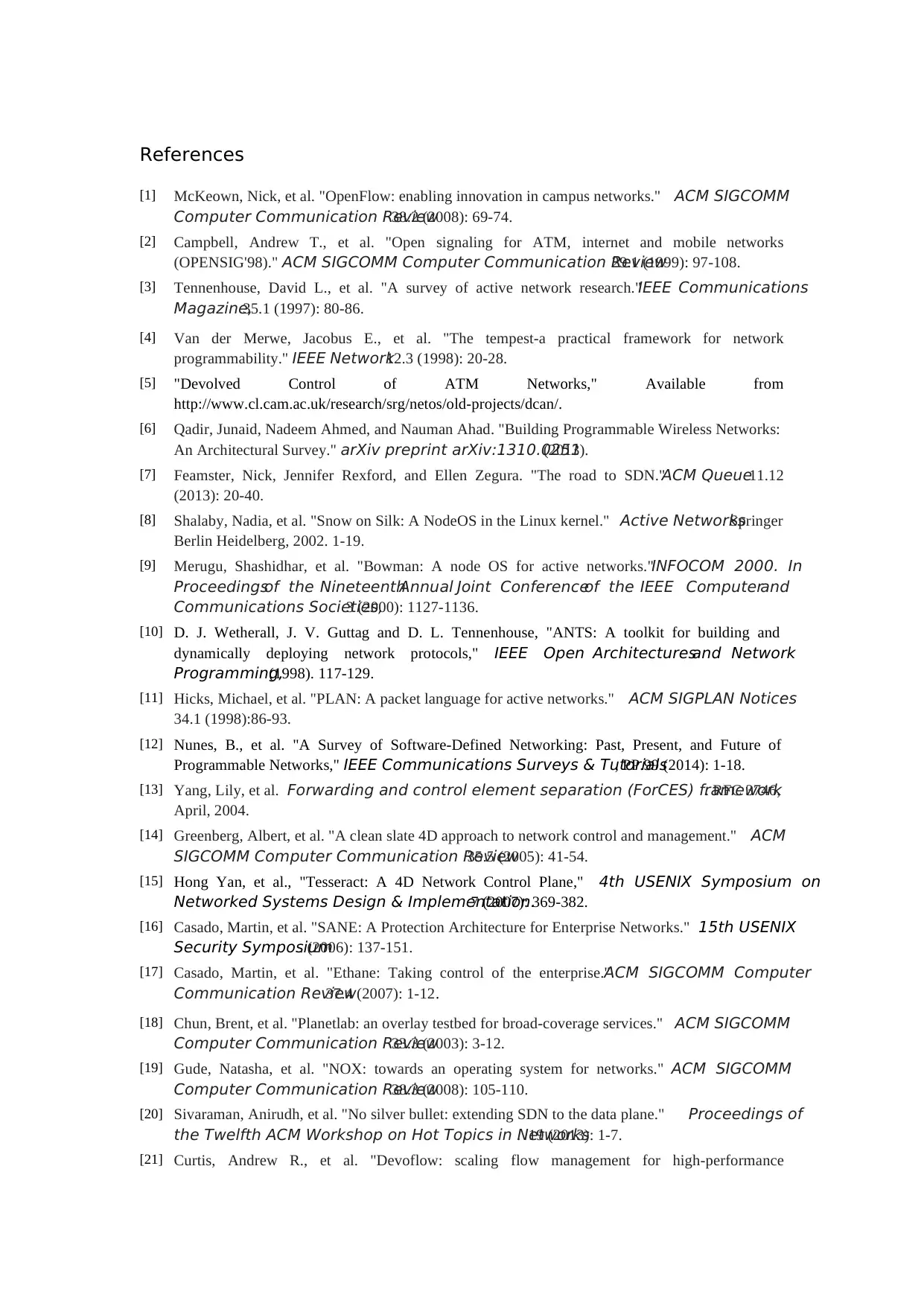
References
[1] McKeown, Nick, et al. "OpenFlow: enabling innovation in campus networks." ACM SIGCOMM
Computer Communication Review38.2 (2008): 69-74.
[2] Campbell, Andrew T., et al. "Open signaling for ATM, internet and mobile networks
(OPENSIG'98)." ACM SIGCOMM Computer Communication Review29.1 (1999): 97-108.
[3] Tennenhouse, David L., et al. "A survey of active network research."IEEE Communications
Magazine,35.1 (1997): 80-86.
[4] Van der Merwe, Jacobus E., et al. "The tempest-a practical framework for network
programmability." IEEE Network12.3 (1998): 20-28.
[5] "Devolved Control of ATM Networks," Available from
http://www.cl.cam.ac.uk/research/srg/netos/old-projects/dcan/.
[6] Qadir, Junaid, Nadeem Ahmed, and Nauman Ahad. "Building Programmable Wireless Networks:
An Architectural Survey." arXiv preprint arXiv:1310.0251(2013).
[7] Feamster, Nick, Jennifer Rexford, and Ellen Zegura. "The road to SDN."ACM Queue11.12
(2013): 20-40.
[8] Shalaby, Nadia, et al. "Snow on Silk: A NodeOS in the Linux kernel." Active Networks. Springer
Berlin Heidelberg, 2002. 1-19.
[9] Merugu, Shashidhar, et al. "Bowman: A node OS for active networks."INFOCOM 2000. In
Proceedingsof the NineteenthAnnual Joint Conferenceof the IEEE Computerand
Communications Societies,3 (2000): 1127-1136.
[10] D. J. Wetherall, J. V. Guttag and D. L. Tennenhouse, "ANTS: A toolkit for building and
dynamically deploying network protocols," IEEE Open Architecturesand Network
Programming,(1998). 117-129.
[11] Hicks, Michael, et al. "PLAN: A packet language for active networks." ACM SIGPLAN Notices.
34.1 (1998):86-93.
[12] Nunes, B., et al. "A Survey of Software-Defined Networking: Past, Present, and Future of
Programmable Networks," IEEE Communications Surveys & Tutorials, PP.99 (2014): 1-18.
[13] Yang, Lily, et al. Forwarding and control element separation (ForCES) framework. RFC 3746,
April, 2004.
[14] Greenberg, Albert, et al. "A clean slate 4D approach to network control and management." ACM
SIGCOMM Computer Communication Review35.5 (2005): 41-54.
[15] Hong Yan, et al., "Tesseract: A 4D Network Control Plane," 4th USENIX Symposium on
Networked Systems Design & Implementation.7 (2007): 369-382.
[16] Casado, Martin, et al. "SANE: A Protection Architecture for Enterprise Networks." 15th USENIX
Security Symposium. (2006): 137-151.
[17] Casado, Martin, et al. "Ethane: Taking control of the enterprise."ACM SIGCOMM Computer
Communication Review37.4 (2007): 1-12.
[18] Chun, Brent, et al. "Planetlab: an overlay testbed for broad-coverage services." ACM SIGCOMM
Computer Communication Review33.3 (2003): 3-12.
[19] Gude, Natasha, et al. "NOX: towards an operating system for networks." ACM SIGCOMM
Computer Communication Review38.3 (2008): 105-110.
[20] Sivaraman, Anirudh, et al. "No silver bullet: extending SDN to the data plane." Proceedings of
the Twelfth ACM Workshop on Hot Topics in Networks. 19 (2013): 1-7.
[21] Curtis, Andrew R., et al. "Devoflow: scaling flow management for high-performance
[1] McKeown, Nick, et al. "OpenFlow: enabling innovation in campus networks." ACM SIGCOMM
Computer Communication Review38.2 (2008): 69-74.
[2] Campbell, Andrew T., et al. "Open signaling for ATM, internet and mobile networks
(OPENSIG'98)." ACM SIGCOMM Computer Communication Review29.1 (1999): 97-108.
[3] Tennenhouse, David L., et al. "A survey of active network research."IEEE Communications
Magazine,35.1 (1997): 80-86.
[4] Van der Merwe, Jacobus E., et al. "The tempest-a practical framework for network
programmability." IEEE Network12.3 (1998): 20-28.
[5] "Devolved Control of ATM Networks," Available from
http://www.cl.cam.ac.uk/research/srg/netos/old-projects/dcan/.
[6] Qadir, Junaid, Nadeem Ahmed, and Nauman Ahad. "Building Programmable Wireless Networks:
An Architectural Survey." arXiv preprint arXiv:1310.0251(2013).
[7] Feamster, Nick, Jennifer Rexford, and Ellen Zegura. "The road to SDN."ACM Queue11.12
(2013): 20-40.
[8] Shalaby, Nadia, et al. "Snow on Silk: A NodeOS in the Linux kernel." Active Networks. Springer
Berlin Heidelberg, 2002. 1-19.
[9] Merugu, Shashidhar, et al. "Bowman: A node OS for active networks."INFOCOM 2000. In
Proceedingsof the NineteenthAnnual Joint Conferenceof the IEEE Computerand
Communications Societies,3 (2000): 1127-1136.
[10] D. J. Wetherall, J. V. Guttag and D. L. Tennenhouse, "ANTS: A toolkit for building and
dynamically deploying network protocols," IEEE Open Architecturesand Network
Programming,(1998). 117-129.
[11] Hicks, Michael, et al. "PLAN: A packet language for active networks." ACM SIGPLAN Notices.
34.1 (1998):86-93.
[12] Nunes, B., et al. "A Survey of Software-Defined Networking: Past, Present, and Future of
Programmable Networks," IEEE Communications Surveys & Tutorials, PP.99 (2014): 1-18.
[13] Yang, Lily, et al. Forwarding and control element separation (ForCES) framework. RFC 3746,
April, 2004.
[14] Greenberg, Albert, et al. "A clean slate 4D approach to network control and management." ACM
SIGCOMM Computer Communication Review35.5 (2005): 41-54.
[15] Hong Yan, et al., "Tesseract: A 4D Network Control Plane," 4th USENIX Symposium on
Networked Systems Design & Implementation.7 (2007): 369-382.
[16] Casado, Martin, et al. "SANE: A Protection Architecture for Enterprise Networks." 15th USENIX
Security Symposium. (2006): 137-151.
[17] Casado, Martin, et al. "Ethane: Taking control of the enterprise."ACM SIGCOMM Computer
Communication Review37.4 (2007): 1-12.
[18] Chun, Brent, et al. "Planetlab: an overlay testbed for broad-coverage services." ACM SIGCOMM
Computer Communication Review33.3 (2003): 3-12.
[19] Gude, Natasha, et al. "NOX: towards an operating system for networks." ACM SIGCOMM
Computer Communication Review38.3 (2008): 105-110.
[20] Sivaraman, Anirudh, et al. "No silver bullet: extending SDN to the data plane." Proceedings of
the Twelfth ACM Workshop on Hot Topics in Networks. 19 (2013): 1-7.
[21] Curtis, Andrew R., et al. "Devoflow: scaling flow management for high-performance
Paraphrase This Document
Need a fresh take? Get an instant paraphrase of this document with our AI Paraphraser
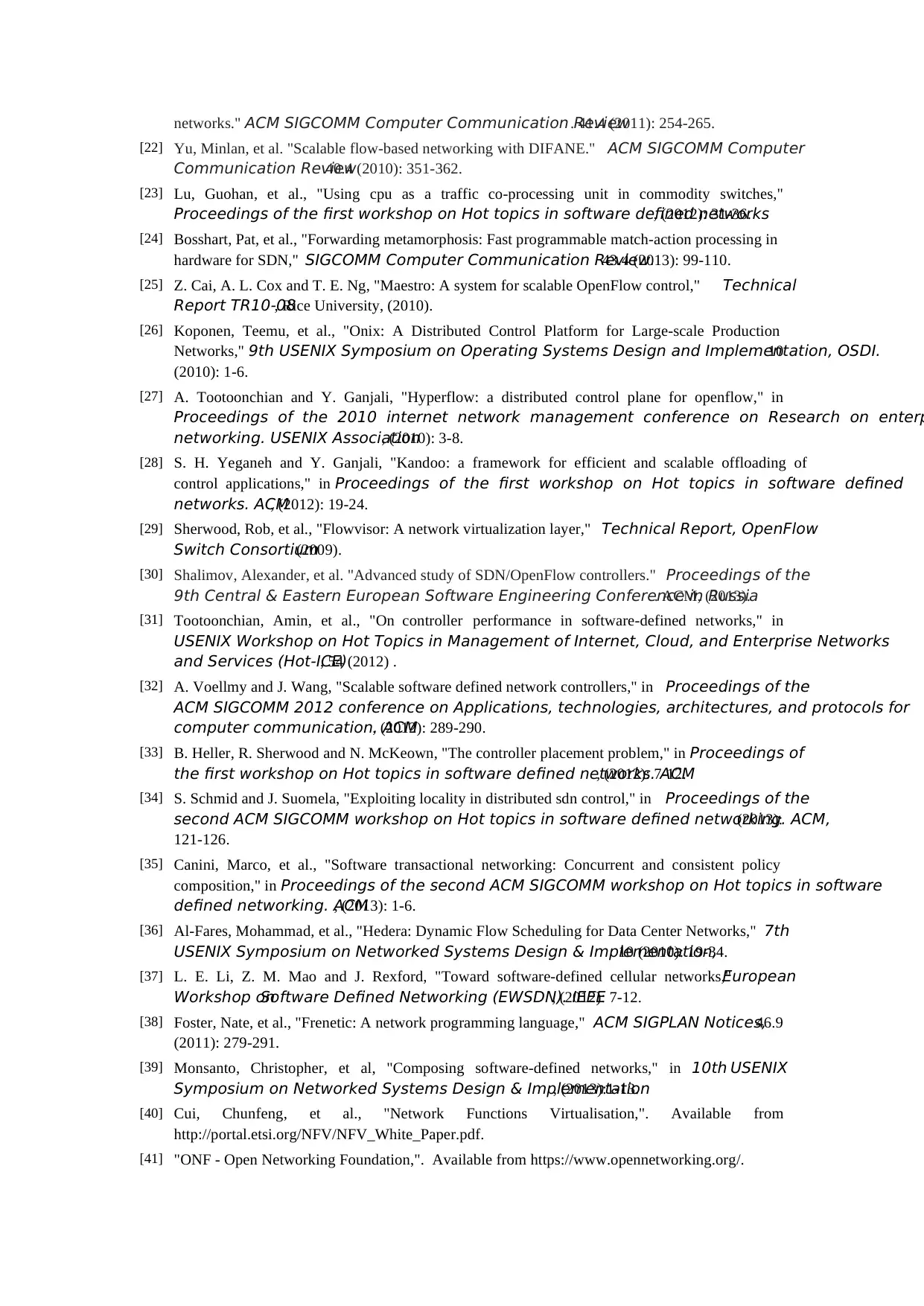
networks." ACM SIGCOMM Computer Communication Review. 41.4 (2011): 254-265.
[22] Yu, Minlan, et al. "Scalable flow-based networking with DIFANE." ACM SIGCOMM Computer
Communication Review40.4 (2010): 351-362.
[23] Lu, Guohan, et al., "Using cpu as a traffic co-processing unit in commodity switches,"
Proceedings of the first workshop on Hot topics in software defined networks, (2012): 31-36.
[24] Bosshart, Pat, et al., "Forwarding metamorphosis: Fast programmable match-action processing in
hardware for SDN," SIGCOMM Computer Communication Review.43.4 (2013): 99-110.
[25] Z. Cai, A. L. Cox and T. E. Ng, "Maestro: A system for scalable OpenFlow control," Technical
Report TR10-08, Rice University, (2010).
[26] Koponen, Teemu, et al., "Onix: A Distributed Control Platform for Large-scale Production
Networks," 9th USENIX Symposium on Operating Systems Design and Implementation, OSDI.10
(2010): 1-6.
[27] A. Tootoonchian and Y. Ganjali, "Hyperflow: a distributed control plane for openflow," in
Proceedings of the 2010 internet network management conference on Research on enterp
networking. USENIX Association, (2010): 3-8.
[28] S. H. Yeganeh and Y. Ganjali, "Kandoo: a framework for efficient and scalable offloading of
control applications," in Proceedings of the first workshop on Hot topics in software defined
networks. ACM, (2012): 19-24.
[29] Sherwood, Rob, et al., "Flowvisor: A network virtualization layer," Technical Report, OpenFlow
Switch Consortium(2009).
[30] Shalimov, Alexander, et al. "Advanced study of SDN/OpenFlow controllers." Proceedings of the
9th Central & Eastern European Software Engineering Conference in Russia. ACM, (2013).
[31] Tootoonchian, Amin, et al., "On controller performance in software-defined networks," in
USENIX Workshop on Hot Topics in Management of Internet, Cloud, and Enterprise Networks
and Services (Hot-ICE), 54 (2012) .
[32] A. Voellmy and J. Wang, "Scalable software defined network controllers," in Proceedings of the
ACM SIGCOMM 2012 conference on Applications, technologies, architectures, and protocols for
computer communication. ACM, (2012): 289-290.
[33] B. Heller, R. Sherwood and N. McKeown, "The controller placement problem," in Proceedings of
the first workshop on Hot topics in software defined networks. ACM, (2012): 7-12.
[34] S. Schmid and J. Suomela, "Exploiting locality in distributed sdn control," in Proceedings of the
second ACM SIGCOMM workshop on Hot topics in software defined networking. ACM,(2013):
121-126.
[35] Canini, Marco, et al., "Software transactional networking: Concurrent and consistent policy
composition," in Proceedings of the second ACM SIGCOMM workshop on Hot topics in software
defined networking. ACM, (2013): 1-6.
[36] Al-Fares, Mohammad, et al., "Hedera: Dynamic Flow Scheduling for Data Center Networks," 7th
USENIX Symposium on Networked Systems Design & Implementation,10 (2010): 19-34.
[37] L. E. Li, Z. M. Mao and J. Rexford, "Toward software-defined cellular networks,"European
Workshop onSoftware Defined Networking (EWSDN). IEEE, (2012): 7-12.
[38] Foster, Nate, et al., "Frenetic: A network programming language," ACM SIGPLAN Notices,46.9
(2011): 279-291.
[39] Monsanto, Christopher, et al, "Composing software-defined networks," in 10th USENIX
Symposium on Networked Systems Design & Implementation, (2013):1-13.
[40] Cui, Chunfeng, et al., "Network Functions Virtualisation,". Available from
http://portal.etsi.org/NFV/NFV_White_Paper.pdf.
[41] "ONF - Open Networking Foundation,". Available from https://www.opennetworking.org/.
[22] Yu, Minlan, et al. "Scalable flow-based networking with DIFANE." ACM SIGCOMM Computer
Communication Review40.4 (2010): 351-362.
[23] Lu, Guohan, et al., "Using cpu as a traffic co-processing unit in commodity switches,"
Proceedings of the first workshop on Hot topics in software defined networks, (2012): 31-36.
[24] Bosshart, Pat, et al., "Forwarding metamorphosis: Fast programmable match-action processing in
hardware for SDN," SIGCOMM Computer Communication Review.43.4 (2013): 99-110.
[25] Z. Cai, A. L. Cox and T. E. Ng, "Maestro: A system for scalable OpenFlow control," Technical
Report TR10-08, Rice University, (2010).
[26] Koponen, Teemu, et al., "Onix: A Distributed Control Platform for Large-scale Production
Networks," 9th USENIX Symposium on Operating Systems Design and Implementation, OSDI.10
(2010): 1-6.
[27] A. Tootoonchian and Y. Ganjali, "Hyperflow: a distributed control plane for openflow," in
Proceedings of the 2010 internet network management conference on Research on enterp
networking. USENIX Association, (2010): 3-8.
[28] S. H. Yeganeh and Y. Ganjali, "Kandoo: a framework for efficient and scalable offloading of
control applications," in Proceedings of the first workshop on Hot topics in software defined
networks. ACM, (2012): 19-24.
[29] Sherwood, Rob, et al., "Flowvisor: A network virtualization layer," Technical Report, OpenFlow
Switch Consortium(2009).
[30] Shalimov, Alexander, et al. "Advanced study of SDN/OpenFlow controllers." Proceedings of the
9th Central & Eastern European Software Engineering Conference in Russia. ACM, (2013).
[31] Tootoonchian, Amin, et al., "On controller performance in software-defined networks," in
USENIX Workshop on Hot Topics in Management of Internet, Cloud, and Enterprise Networks
and Services (Hot-ICE), 54 (2012) .
[32] A. Voellmy and J. Wang, "Scalable software defined network controllers," in Proceedings of the
ACM SIGCOMM 2012 conference on Applications, technologies, architectures, and protocols for
computer communication. ACM, (2012): 289-290.
[33] B. Heller, R. Sherwood and N. McKeown, "The controller placement problem," in Proceedings of
the first workshop on Hot topics in software defined networks. ACM, (2012): 7-12.
[34] S. Schmid and J. Suomela, "Exploiting locality in distributed sdn control," in Proceedings of the
second ACM SIGCOMM workshop on Hot topics in software defined networking. ACM,(2013):
121-126.
[35] Canini, Marco, et al., "Software transactional networking: Concurrent and consistent policy
composition," in Proceedings of the second ACM SIGCOMM workshop on Hot topics in software
defined networking. ACM, (2013): 1-6.
[36] Al-Fares, Mohammad, et al., "Hedera: Dynamic Flow Scheduling for Data Center Networks," 7th
USENIX Symposium on Networked Systems Design & Implementation,10 (2010): 19-34.
[37] L. E. Li, Z. M. Mao and J. Rexford, "Toward software-defined cellular networks,"European
Workshop onSoftware Defined Networking (EWSDN). IEEE, (2012): 7-12.
[38] Foster, Nate, et al., "Frenetic: A network programming language," ACM SIGPLAN Notices,46.9
(2011): 279-291.
[39] Monsanto, Christopher, et al, "Composing software-defined networks," in 10th USENIX
Symposium on Networked Systems Design & Implementation, (2013):1-13.
[40] Cui, Chunfeng, et al., "Network Functions Virtualisation,". Available from
http://portal.etsi.org/NFV/NFV_White_Paper.pdf.
[41] "ONF - Open Networking Foundation,". Available from https://www.opennetworking.org/.

[42] "IRTF SDNRG,". Available from https://irtf.org/sdnrg.
[43] "IETF I2RS,". Available from http://datatracker.ietf.org/wg/i2rs/.
[44] "ALTO and SDN,". Available from http://www.ietf.org/proceedings/84/slides/slides-84-alto-5.
[45] "IETF CDNI and SDN,". Available from http://www.ietf.org/proceedings/84/slides/slides-84-
cdni-1.pdf.
[46] "ITU Telecommunication Standardization Sector,". Available from http://www.itu.int/en/ITU-T.
[47] "OIF - Optical Internetworking Forum,". Available from http://www.oiforum.com/.
[48] "Broadband Forum and SDN,". Available from http://www.broadband-
forum.org/technical/technicalwip.php.
[49] "MEF - Metro Ethernet Forum,". Available from http://metroethernetforum.org/.
[50] Jain, Sushant, et al., "B4: Experience with a globally-deployed software defined WAN," in
Proceedings of the ACM SIGCOMM 2013 conference on SIGCOMM. ACM, (2013): 3-14.
[51] A. Vahdat, "Enter the Andromeda zone - Google Cloud Platform’s latest networking stack,"
Available from http://googlecloudplatform.blogspot.gr/2014/04/enter-andromeda-zone-google-
cloud-platforms-latest-networking-stack.html.
[43] "IETF I2RS,". Available from http://datatracker.ietf.org/wg/i2rs/.
[44] "ALTO and SDN,". Available from http://www.ietf.org/proceedings/84/slides/slides-84-alto-5.
[45] "IETF CDNI and SDN,". Available from http://www.ietf.org/proceedings/84/slides/slides-84-
cdni-1.pdf.
[46] "ITU Telecommunication Standardization Sector,". Available from http://www.itu.int/en/ITU-T.
[47] "OIF - Optical Internetworking Forum,". Available from http://www.oiforum.com/.
[48] "Broadband Forum and SDN,". Available from http://www.broadband-
forum.org/technical/technicalwip.php.
[49] "MEF - Metro Ethernet Forum,". Available from http://metroethernetforum.org/.
[50] Jain, Sushant, et al., "B4: Experience with a globally-deployed software defined WAN," in
Proceedings of the ACM SIGCOMM 2013 conference on SIGCOMM. ACM, (2013): 3-14.
[51] A. Vahdat, "Enter the Andromeda zone - Google Cloud Platform’s latest networking stack,"
Available from http://googlecloudplatform.blogspot.gr/2014/04/enter-andromeda-zone-google-
cloud-platforms-latest-networking-stack.html.
1 out of 33
Related Documents
Your All-in-One AI-Powered Toolkit for Academic Success.
+13062052269
info@desklib.com
Available 24*7 on WhatsApp / Email
![[object Object]](/_next/static/media/star-bottom.7253800d.svg)
Unlock your academic potential
© 2024 | Zucol Services PVT LTD | All rights reserved.




